|
Made With |
|
|
|
|
Dr. Hoffer's Travel WebSite This site was last updated 05/12/19 |
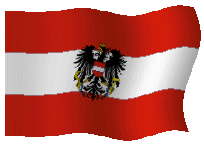
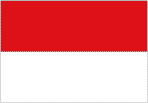
![]() GREECE17 #3 VIENNA #1 HOFBURG PALACE 1
GREECE17 #3 VIENNA #1 HOFBURG PALACE 1
![]()
FLAG of VIENNA
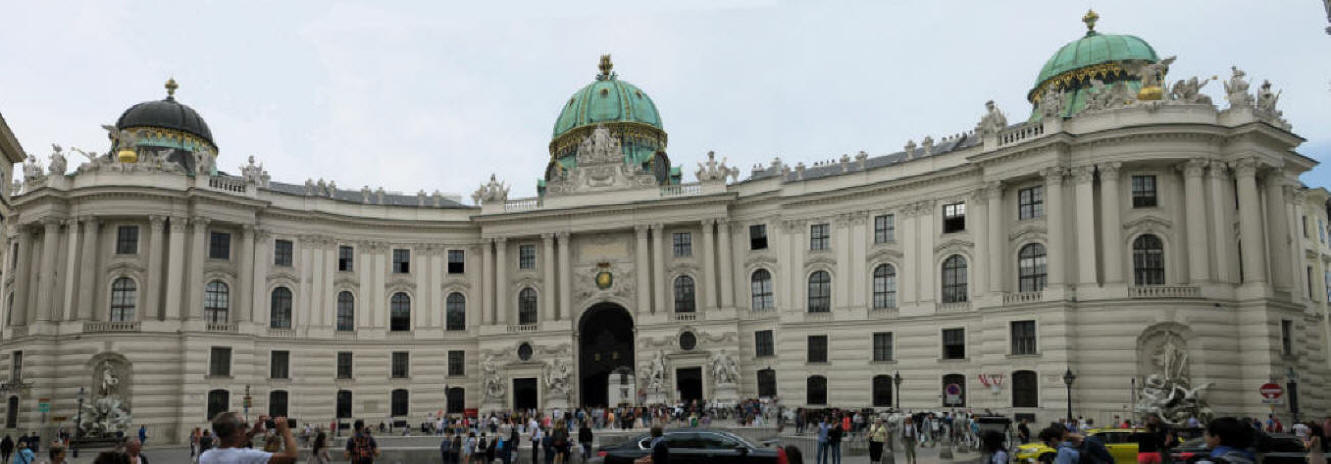
HOFBURG PALACE
[This trip is primarily to visit Greece but Greece is small and doesn't warrant a whole three months to see it. Since we will have visited all of Western Europe except Malta and Romania when we are done, I thought it would be a good idea to visit things on this trip that we have missed over the years. An important one was Vienna. We have been here four times since 1997 but because of attending scientific eye meetings, we have not seen it as we have all the other capitols of Europe; spending at least a week acting like tourists. To do this I set aside a week between Munich and getting to Italy heading to Greece by ferry. I used a tour book recommending the top ten things to be sure to visit in Vienna and set out to see all ten. This means I had to get up each day earlier than I usually do and marathon through each of the seven days. It was grueling and exhaustive but I did it and took thousands of photos to document it all. At age 74, I was proud I got it done. Therefore, each of these next early Diarios will be quite long showing multiple pictures of many of the sites. No one will have the time to look at and read through everything but you can scroll through and get a general idea of this genuinely historic and beautiful city.]
Friday, July 14, 2017
I am calling this our first day in Vienna as a tourist and today happens to be
Bastille
Day in France.
I woke at 5:25 AM and forced myself to get up at 8:00 AM and get into my running
gear. I headed out at 8:40 AM and went around the corner
on
Rotenturmstrasse (Red Tower Street)
(below left) and got a cappuccino at a Starbucks I found nearby (below right) for �4.65 and did my email.
In the EU, Starbucks is great because you can get a decent cappuccino but more
important is the free WiFi so you can use your computer. Otherwise, I
seldom go there.
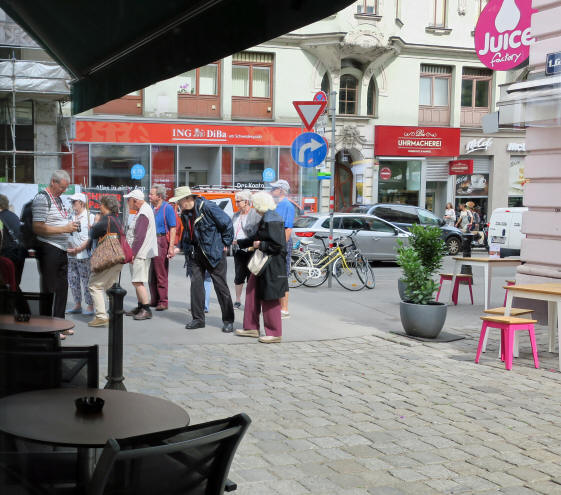
I left there at 9:40 AM and walked around the neighborhood a bit and noted that McDonalds had taken over the first floor of this very stately building. Note there are no "Golden Arches" showing outside.
Except for this tiny one on the corner. I liked their depiction of the makings of their cheeseburger. At 10:00 AM, I started my run heading today to Hofburg Palace. I came across this bust statue honoring Dr. Georg Coch (1842-90).
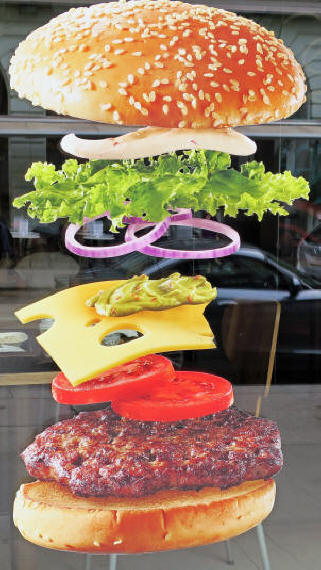
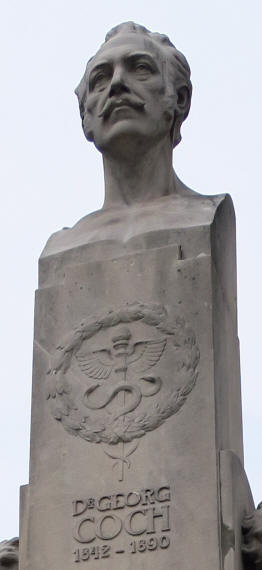
I am now in Georg Coch Platz. He was an economist, banker and founder of the Austrian Postal Savings Bank (�sterreichischen Postsparkasse). His statue sits in front of the Vienna branch (below right).

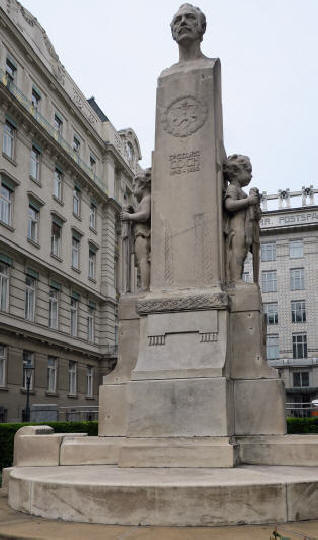
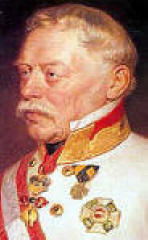 I then passed another impressive building with a prominent bronze equestrian
statue in front. The building was formerly
the Ministry
of War and now houses the Ministry for a Livable Austria as
well as the Federal Ministry of Science, Research and Economy. The
building's
official name is "Regierungsgeb�ude am Stubenring" or Government Building on
Stubenring. The statue
in front is of their most famous
Austrian
Field Marshal,
Josef Wenzel
Radetzky (1766�1858) (right). He fought against Napoleon and in the
first war for Italian independence and died at
home at
age 92.
I then passed another impressive building with a prominent bronze equestrian
statue in front. The building was formerly
the Ministry
of War and now houses the Ministry for a Livable Austria as
well as the Federal Ministry of Science, Research and Economy. The
building's
official name is "Regierungsgeb�ude am Stubenring" or Government Building on
Stubenring. The statue
in front is of their most famous
Austrian
Field Marshal,
Josef Wenzel
Radetzky (1766�1858) (right). He fought against Napoleon and in the
first war for Italian independence and died at
home at
age 92.
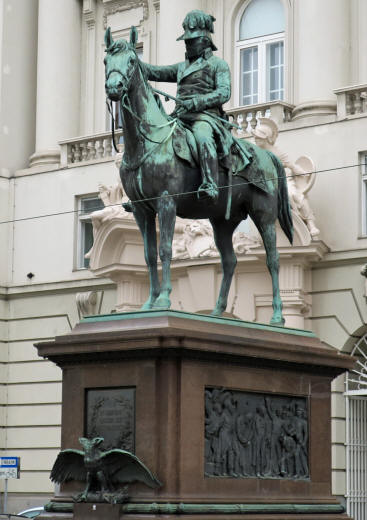

Above is a stock photo of it. The words below the two-headed eagle at the top of the building state: "Summis imperatoris et regis Francisci Josephi I auspiciis Anno 1912 aedificatum" meaning "Built in the year 1912 under the reign of the High Emperor and King, Francis Joseph 1."
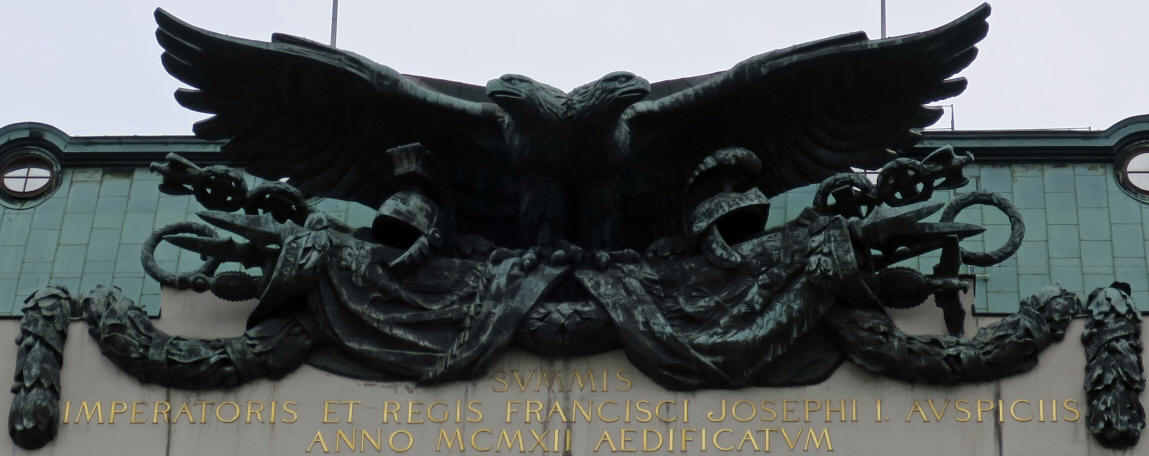

I am still on the Stubenring (ring street) and arrived in a small park dedicated to and called ...
... Dr. Karl Leuger Platz. Karl Leuger (1844-1910) was an Austrian politician, mayor of Vienna and founder/leader of the Austrian Christian Social Party. He is credited with the transformation of the city of Vienna into a modern city. The populist and anti-Semitic politics of his Christian Social Party has been viewed by some as a model for Hitler.


His bronze statue is rather impressive and looks very much like him (below right).
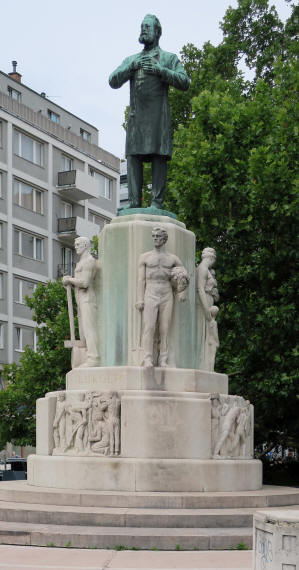
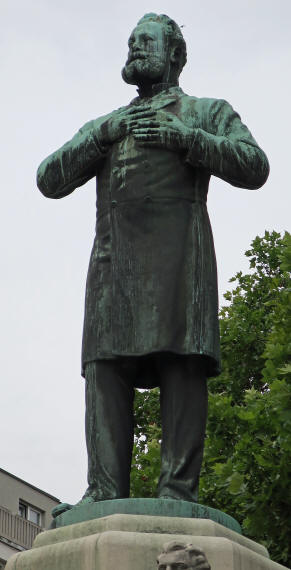
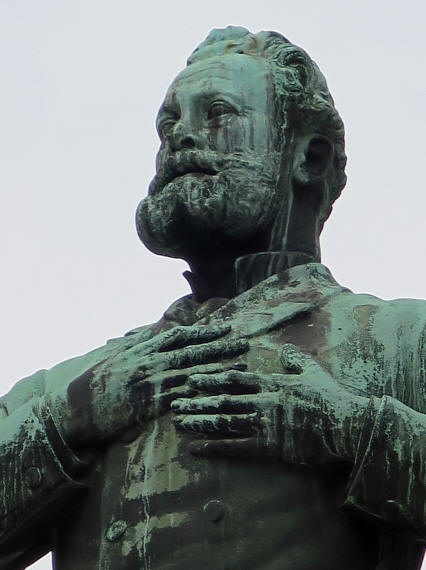
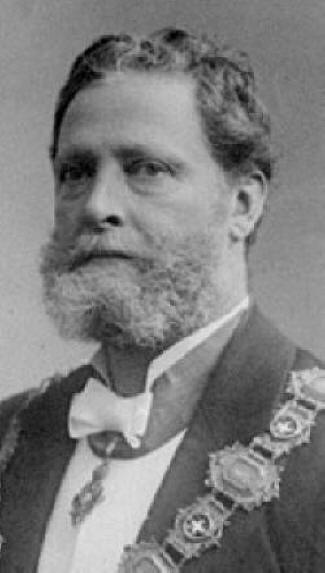
Just below him are four stone statues; three men and a woman with two children.
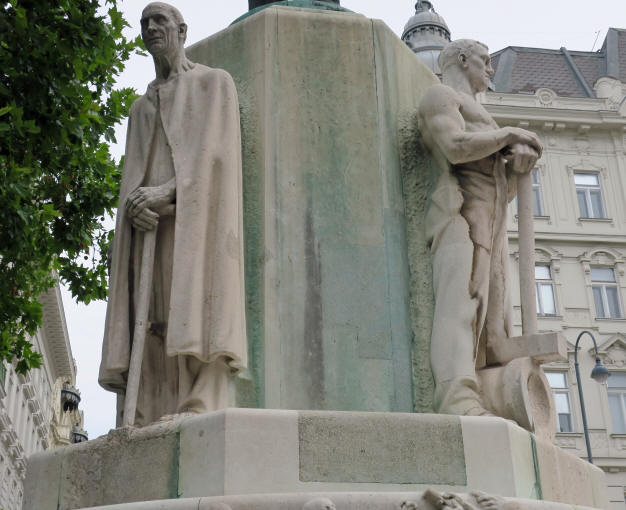
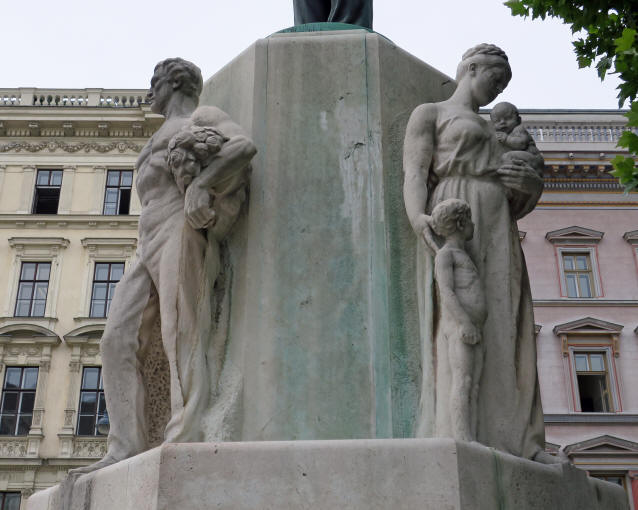
I'm not sure what they represent but, even though they could not vote, he heavily courted the women of Vienna and their interests. Below them are four stone reliefs depicting perhaps agriculture (left) and construction (right)?
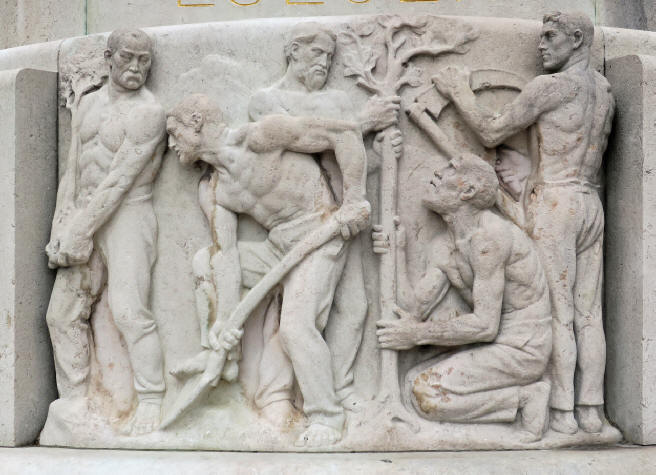
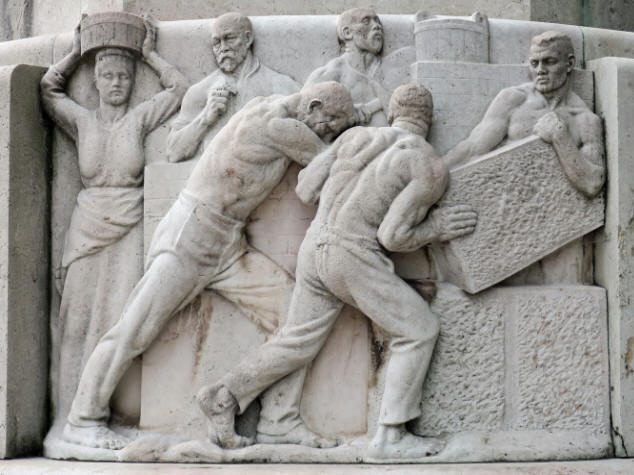
I'm guessing the one on the right (below) is about politics.
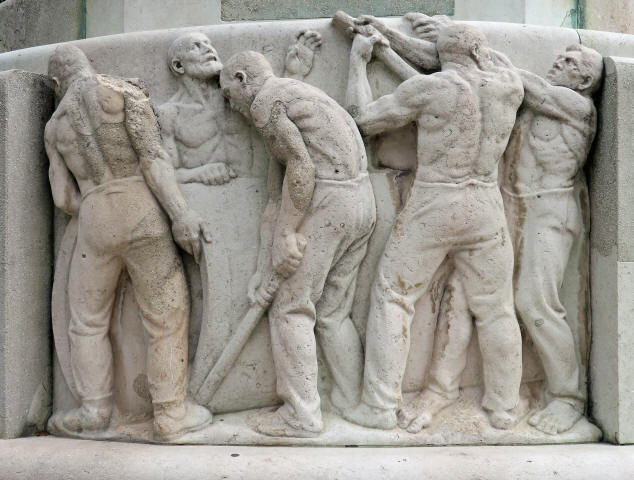
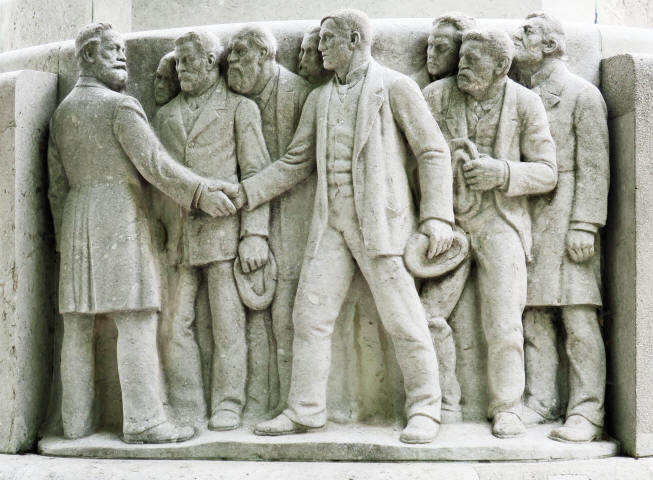
Nearby is an area with remnants (below) of the old Medieval wall surrounding the
inner city of Vienna where the Stubentor Gate stood. The walls were initially
destroyed by Napoleon after he took over the city and fifty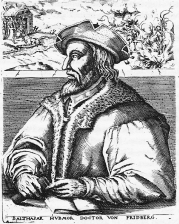 years later Franz Joseph ordered their complete removal and replacement with a
ring road. There is a major U3 subway stop here called Stubentor.
The dark plaque on it is about Dr.
Balthasar Hubmaier
(1480-1528) (right) who was born in Freiberg and was executed here by burning. He was one
of the most well-known and respected
Anabaptist theologians of
the Reformation. Anabaptists were opposed to the baptism of infants; only
adults of free will should be. Today
Anabaptist groups include the Mennonites (2.1 million),
the German
Baptists (1.5 million), the Amish (300,000)
and the Hutterites (50,000).
years later Franz Joseph ordered their complete removal and replacement with a
ring road. There is a major U3 subway stop here called Stubentor.
The dark plaque on it is about Dr.
Balthasar Hubmaier
(1480-1528) (right) who was born in Freiberg and was executed here by burning. He was one
of the most well-known and respected
Anabaptist theologians of
the Reformation. Anabaptists were opposed to the baptism of infants; only
adults of free will should be. Today
Anabaptist groups include the Mennonites (2.1 million),
the German
Baptists (1.5 million), the Amish (300,000)
and the Hutterites (50,000).
The plaque, placed by "the Christians of this city", states that "On March 10, 1528, Hubmaier, founder of religious tolerance thinking, was burned before the Stubentor as an Anabaptist." They quote from his book against intolerance "Heretics and Those Who Burn Them" (1524) yet in 1519, Hubmaier helped orchestrate a violent pogrom against Regensburg's Jews, as well as the total destruction of their synagogue. They were murdered and expelled from the city. Very perplexing?
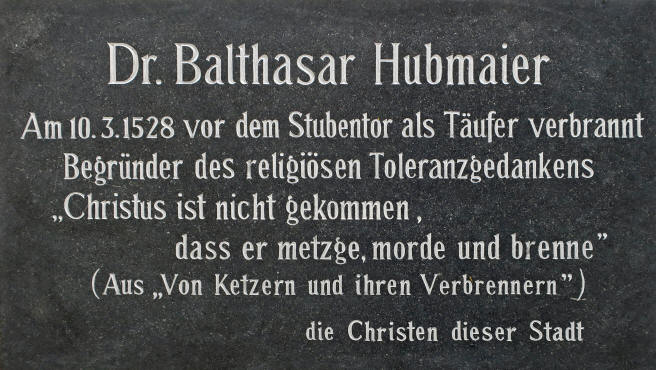
A little further down is a metal replica of the old inner city with its walls and gates. I got a shot from both sides. The city was pretty small.
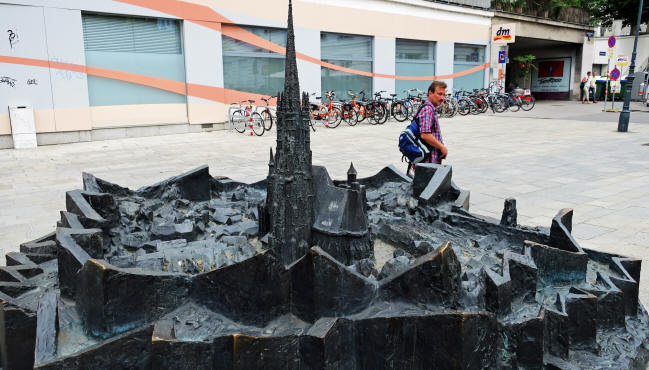
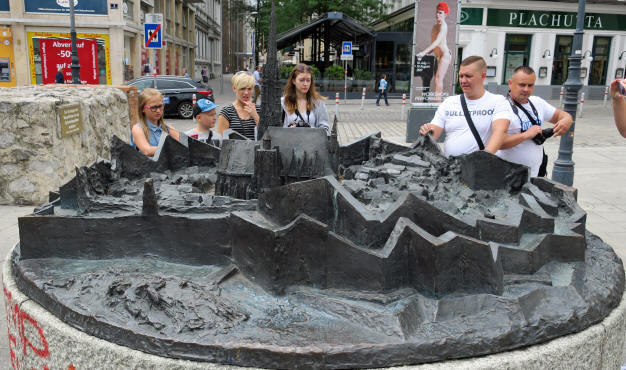
Below the sculpture were three plaques each describing the Stubentor (Stuben Gate). The left one tells how the walls were uncovered along with the Black Tower (built 1555-66) during the construction of the U3 underground station between 1985-7. The center one says that the oldest stub gate (Stubentor) was built around 1200 AD and that in 1831, from the gate a prefabricated kennel and black tower, a 25 meter long box gate was rebuilt with a bell tower with a Classic fa�ade. The right one says "The parlor gate with its gate tower was part of the city wall built around 1200, later built into a fortress from 1531-1672. It saved Vienna in 1683 from conquest by the Ottomans. It was demolished from 1858-1864 and the Ringstrasse was built at its site."
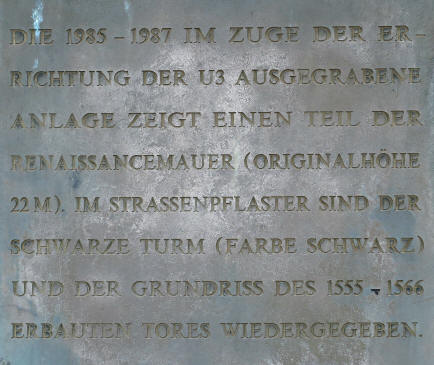
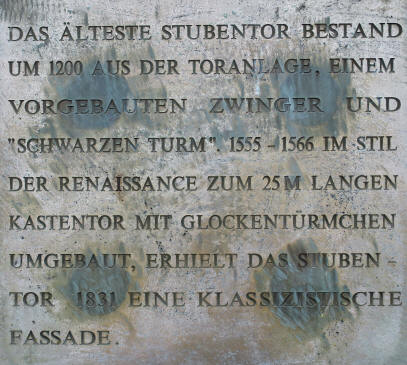
The map below shows the Big purple U Stubentor (far right) and I continued running down Wollzeile then made a left and an immediate right onto Schulerstra�se heading to St. Stephan's Domkirche (far left).


As I went along, I ran past Porterhouse
Steakhouse [Schulerstra�e 19,
![]() +43-1-512-8143] which looked interesting but I can't imagine it could equal
T-bones in the US.
+43-1-512-8143] which looked interesting but I can't imagine it could equal
T-bones in the US.
Here are some interior shots from their website.
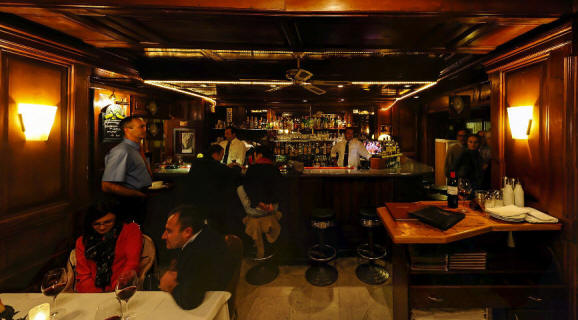
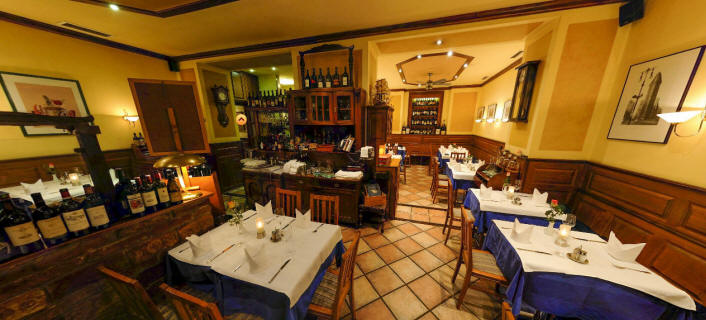
A couple of doors down, I had to laugh seeing the
Gulaschmuseum restaurant
[Schulerstra�e 20, ![]() +43-1-512-1017] remembering my Hungarian grandmother cooking me her fantastic
goulash. Maybe we should try it. Not too far away from that is
Da Capo [Schulerstra�e 18,
+43-1-512-1017] remembering my Hungarian grandmother cooking me her fantastic
goulash. Maybe we should try it. Not too far away from that is
Da Capo [Schulerstra�e 18,
![]() +43-1-512-4491], a good Italian ristorante where we went with Dima and
friends a couple of years ago. It might be good to go back during this
week.
+43-1-512-4491], a good Italian ristorante where we went with Dima and
friends a couple of years ago. It might be good to go back during this
week.
Here below is a stock photo of the interior of the Gulaschmuseum.
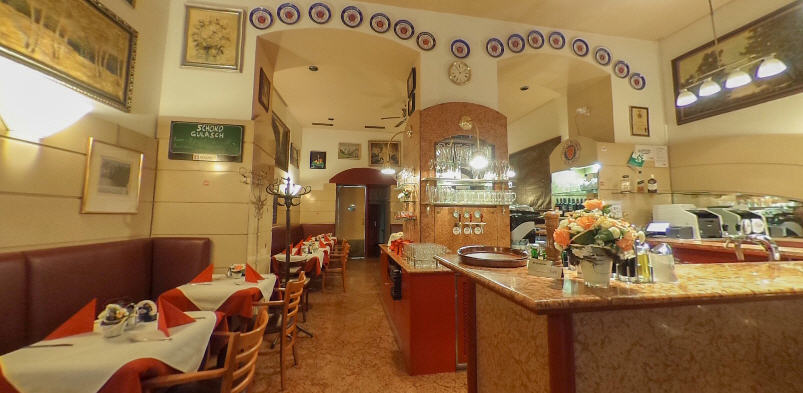
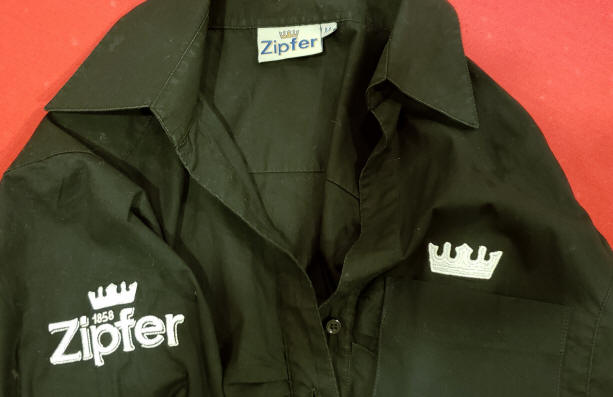
Then I ran by Hotel K�nig von Ungarn (King of
Hungary) [Schulerstra�e 10,
![]() +43-151-5840] (below). They have the shortest web url for a hotel I have ever seen
(kvu.at). It has been this hotel since 1746 and before that it was the
stables and guest quarters for St. Stephan's church where many Hungarian
officials and dignitaries stayed during the Austro-Hungarian Empire (1867-1918).
I remember the long visit I had here with my dear friend Irene (see Home page)
from Madrid several years ago. The bartender gave me a black Zipfer (beer)
shirt I brought home and tailored to fit me (above right).
+43-151-5840] (below). They have the shortest web url for a hotel I have ever seen
(kvu.at). It has been this hotel since 1746 and before that it was the
stables and guest quarters for St. Stephan's church where many Hungarian
officials and dignitaries stayed during the Austro-Hungarian Empire (1867-1918).
I remember the long visit I had here with my dear friend Irene (see Home page)
from Madrid several years ago. The bartender gave me a black Zipfer (beer)
shirt I brought home and tailored to fit me (above right).
I was finally getting close to
Stephansplatz and the center masterpiece of St. Stephan's Dom, the major cathedral of Vienna
and Austria, which was named in honor of St. Stephan, the King of Hungary.
As I come along the left side from behind (below left) you can see the stark contrast
between the parts that have been cleaned and those that have not. Then as
I look at it from the left front (below right), you can see that the front of
the church has all been nicely cleaned.
and the center masterpiece of St. Stephan's Dom, the major cathedral of Vienna
and Austria, which was named in honor of St. Stephan, the King of Hungary.
As I come along the left side from behind (below left) you can see the stark contrast
between the parts that have been cleaned and those that have not. Then as
I look at it from the left front (below right), you can see that the front of
the church has all been nicely cleaned.
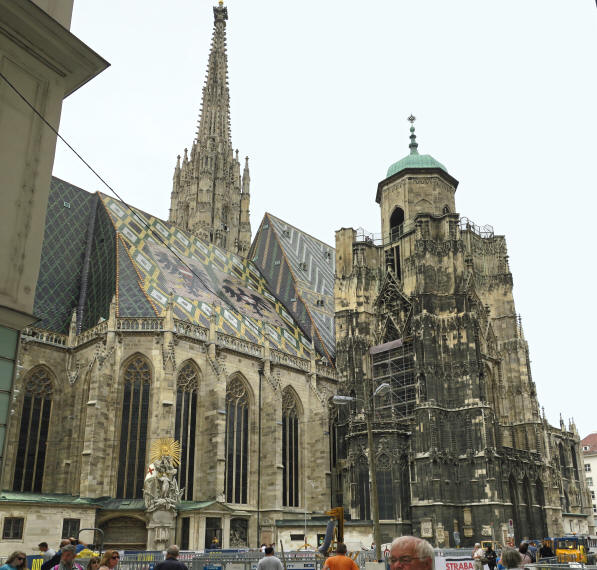
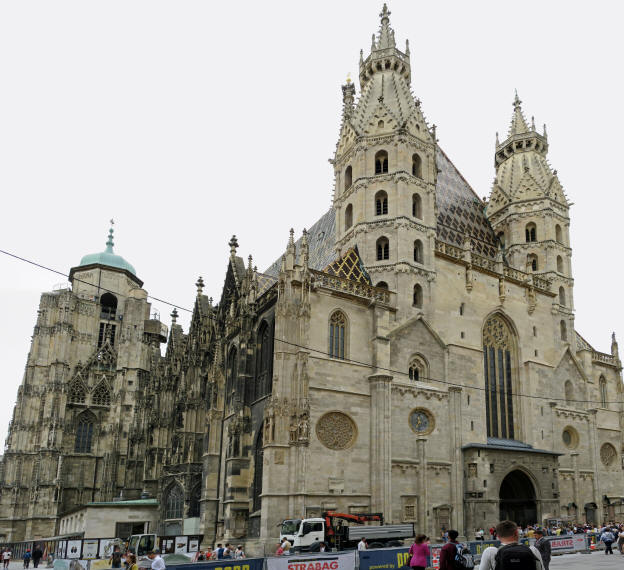
It is difficult to get this huge church in one photo when standing anywhere near it since you can't step back far enough from it without being blocked by other buildings. Most of these photos were accomplished using PhotoStitch. The statue with the gold in it (below left) can be barely seen in the shot of the left side (above left). The entry door is always crowded with tourists.

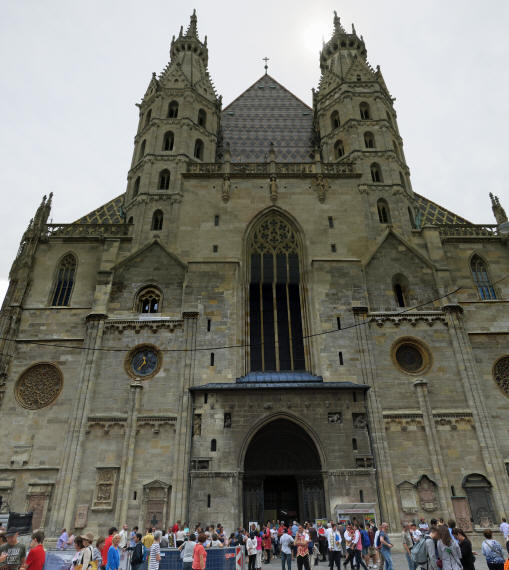
I then walked past the front to see the right side of it (below left) of which
half of it has been cleaned and the rear half is in the process. In the EU
the responsibility for doing this is usually
 the
state and not the church or its
parishioners. As I got into the central plaza, I thought this building,
the Palais Equitable
(below right), was worth a photo. It is a mansion in a corner of
Stephansplatz called Stock-im-Eisen-Platz that was built in the 19th century by
The Equitable Life Assurance Society of the United States and incorporates the
Stock im Eisen (tree
trunk in iron) in one corner (left
corner of building, below right).
the
state and not the church or its
parishioners. As I got into the central plaza, I thought this building,
the Palais Equitable
(below right), was worth a photo. It is a mansion in a corner of
Stephansplatz called Stock-im-Eisen-Platz that was built in the 19th century by
The Equitable Life Assurance Society of the United States and incorporates the
Stock im Eisen (tree
trunk in iron) in one corner (left
corner of building, below right).
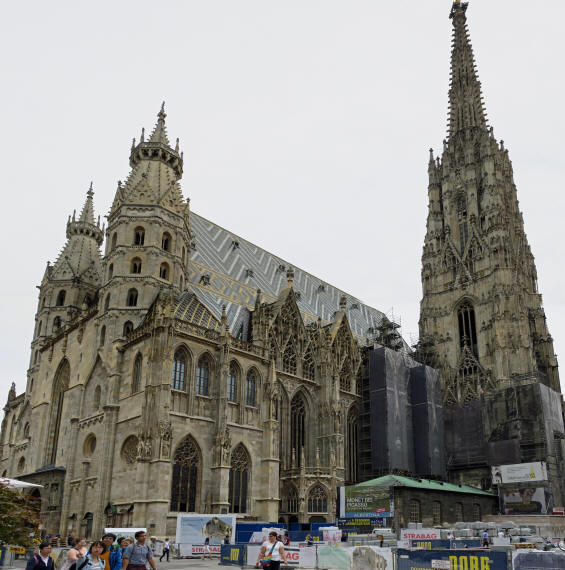
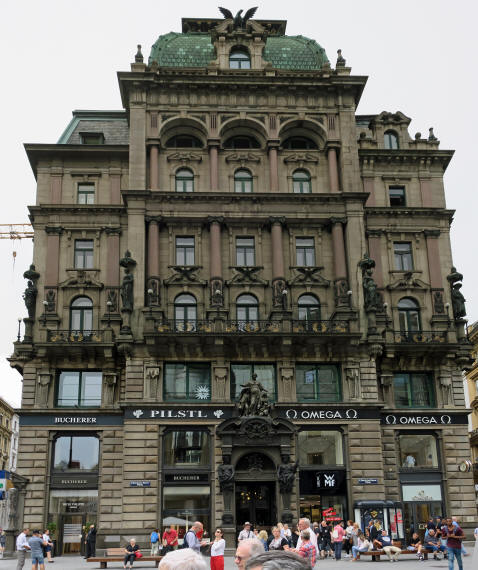
 They renamed it the Equitable Life Insurance Company, also known as "The
Equitable". It was founded by an American, Henry
Baldwin Hyde (below right) in 1859. Note the eagles all over it.
In 1991, AXA, a
French insurance company, acquired majority control of it and in 2004, changed
its name officially to the AXA Equitable Life Insurance Company. It was
once the largest such company in the world.
They renamed it the Equitable Life Insurance Company, also known as "The
Equitable". It was founded by an American, Henry
Baldwin Hyde (below right) in 1859. Note the eagles all over it.
In 1991, AXA, a
French insurance company, acquired majority control of it and in 2004, changed
its name officially to the AXA Equitable Life Insurance Company. It was
once the largest such company in the world.
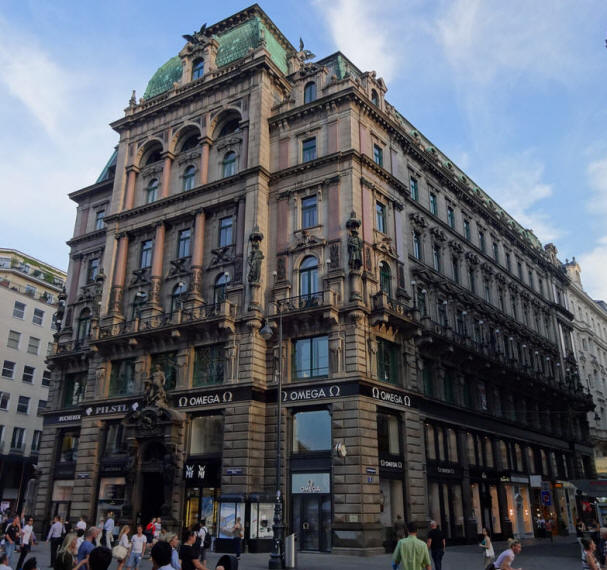
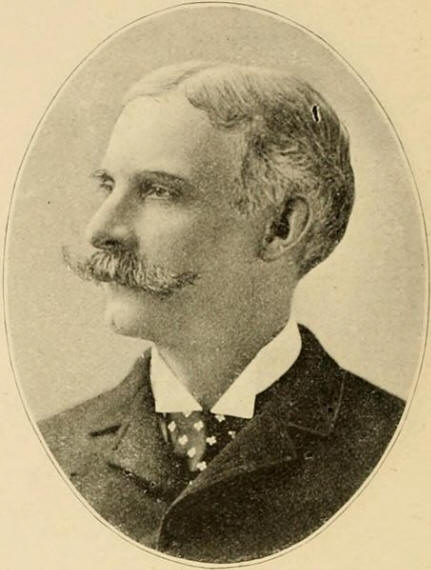
Stock-im-Eisen-Platz is at the corner of the Graben (down the right side) and K�rntner Stra�e (down the left side). The Stock im Eisen is the midsection of a tree trunk from the Middle Ages, a so-called nail-tree (Nagelbaum), into which hundreds of nails have been pounded for good luck over the centuries, specifically by visiting locksmiths. The trunk is now behind glass (stock photos below) built into the corner of the Equitable building. The section of trunk is a little over 7 feet (2.19 m) tall and is held in place by five iron bands which bear the date 1575. More than a half a millennium is pretty old.
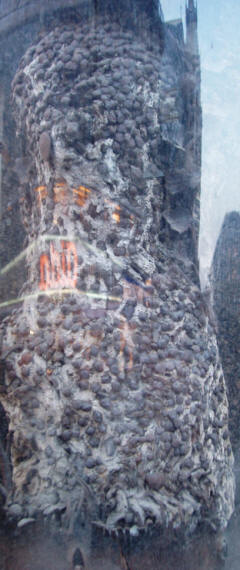

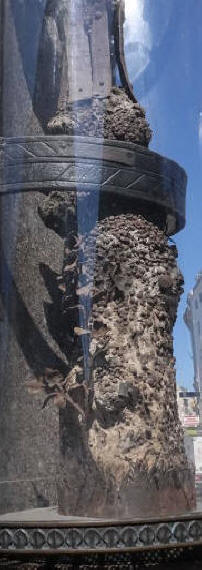
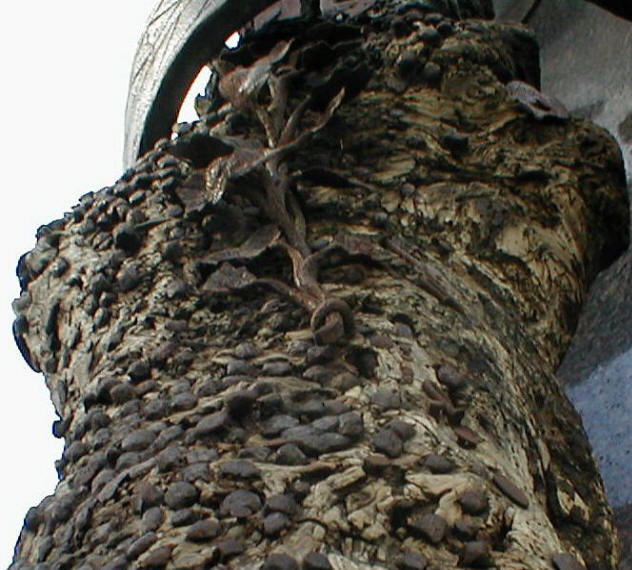
The tree was a forked spruce which started to grow around 1400 AD and was felled in approximately 1440. Inside the Equitable building are bronze plaques telling the story of the tree.
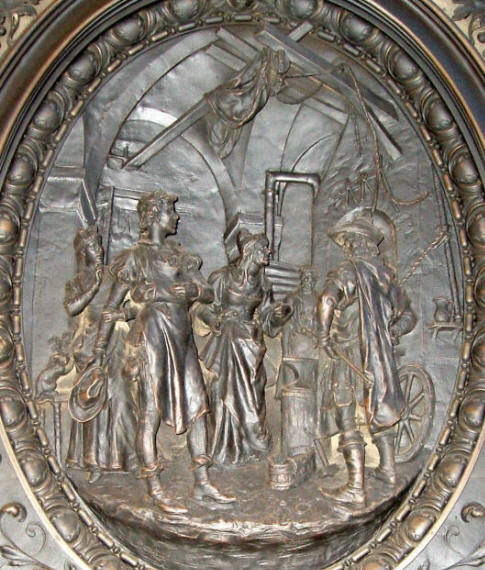
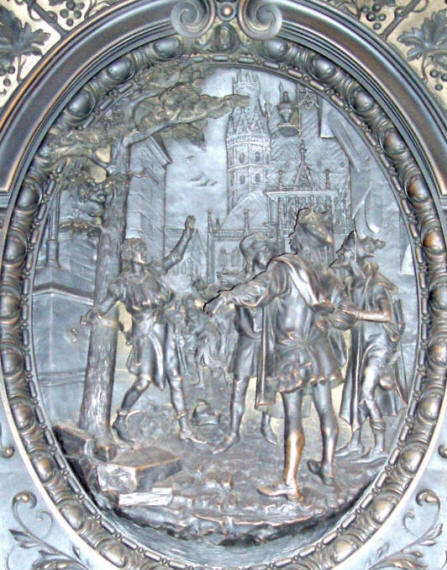
I turned right here and kept running down the busy street called The
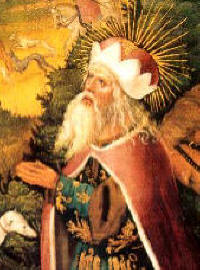
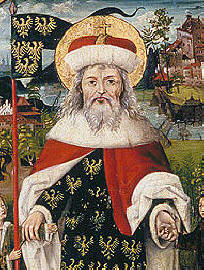 Graben and
at its eastern end there was this bronze statue called Leopoldsbrunnen (Leopold's
Fountain), over a small fountain (below left). It is of
St.
Leopold (1075-1136) (left, right), the patron saint of Austria, holding a flag in his left
hand. To his right, a boy shows
him the sketch of the
Klosterneuburg
Abbey (just north of Vienna, see below), which he founded with his wife, St.
Agnes (1072�1143) (above right). He was known as the Margrave
Leopold
III of Babenberg (the Pious), and was canonized by Pope Innocent VIII in
1485. Agnes, should be a saint. She had eleven children with her
first husband Frederick I starting at age 14 and eleven more with Leopold; 22 children
who lived is amazing for the Middle Ages.
Graben and
at its eastern end there was this bronze statue called Leopoldsbrunnen (Leopold's
Fountain), over a small fountain (below left). It is of
St.
Leopold (1075-1136) (left, right), the patron saint of Austria, holding a flag in his left
hand. To his right, a boy shows
him the sketch of the
Klosterneuburg
Abbey (just north of Vienna, see below), which he founded with his wife, St.
Agnes (1072�1143) (above right). He was known as the Margrave
Leopold
III of Babenberg (the Pious), and was canonized by Pope Innocent VIII in
1485. Agnes, should be a saint. She had eleven children with her
first husband Frederick I starting at age 14 and eleven more with Leopold; 22 children
who lived is amazing for the Middle Ages.
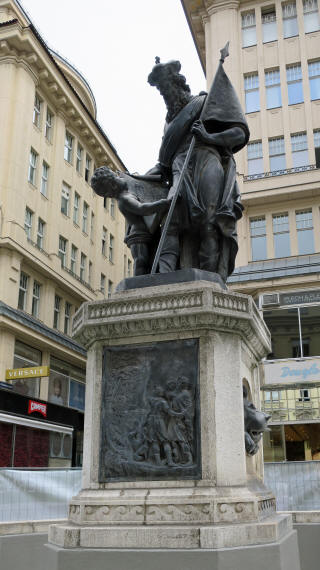
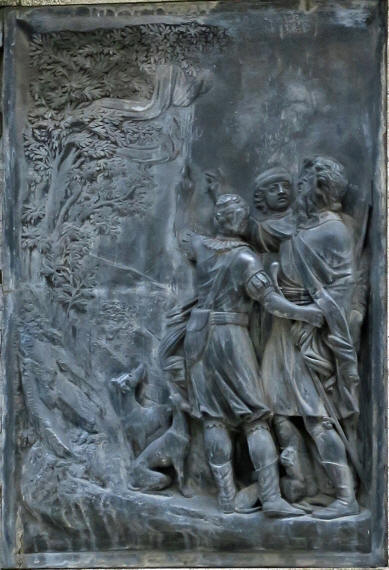
The base of the statue is decorated with lions spitting water (above center left), and reliefs (above center right); one illustrating one legend of the discovery of the veil of Saint Agnes and the other the founding of the Abbey of Klosterneuburg (official website). The Abbey (stock photos below) is also the oldest winery in Austria. Quite an impressive place. I also saw this circular "billboard" advertising the Mozart Haus museum (above right).
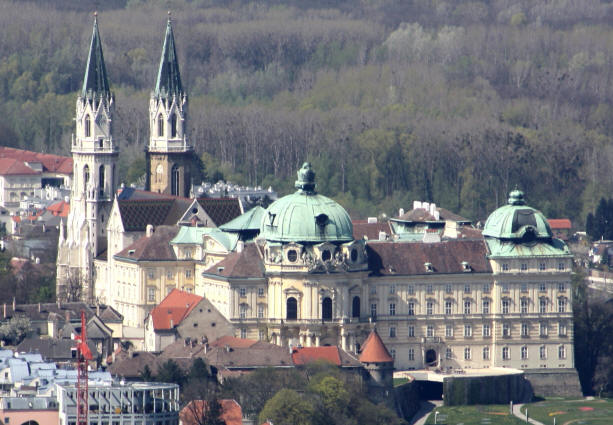
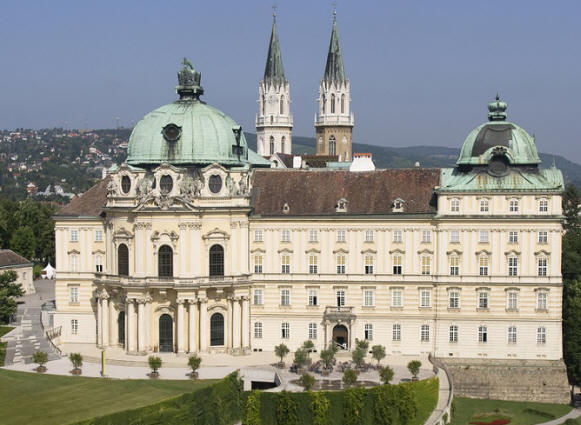
I can't remember whether we ever visited it in 2011 when touring Austria and the Melk Abbey. The reliquary of St. Leopold (below left) and another one of his skull (below right) are both at the Abbey.
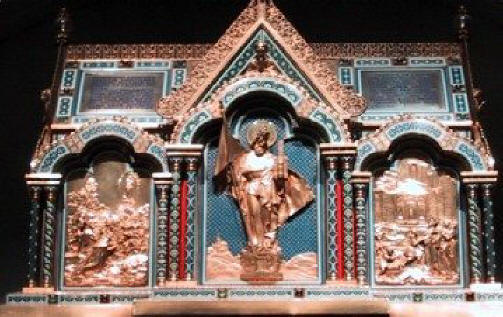
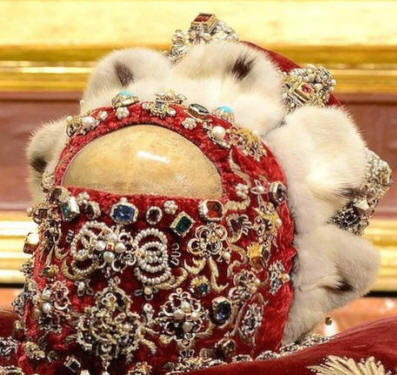
This is the view of The Graben heading away from Stephansplatz.
Below is a stock sketch of what the street looked like in 1609. The Graben is one of Vienna's most famous streets which begins at Stock-im-Eisen-Platz next to the Palais Equitable and ends at the junction of Kohlmarkt and Tuchlauben. Graben means ditch or trench and in Roman times it was the trench around the old city wall. The walls were turn down and the ditch filled in in the 12th Century using the money obtained from the famous ransom of Richard the Lionhearted (so the English paid for it!)
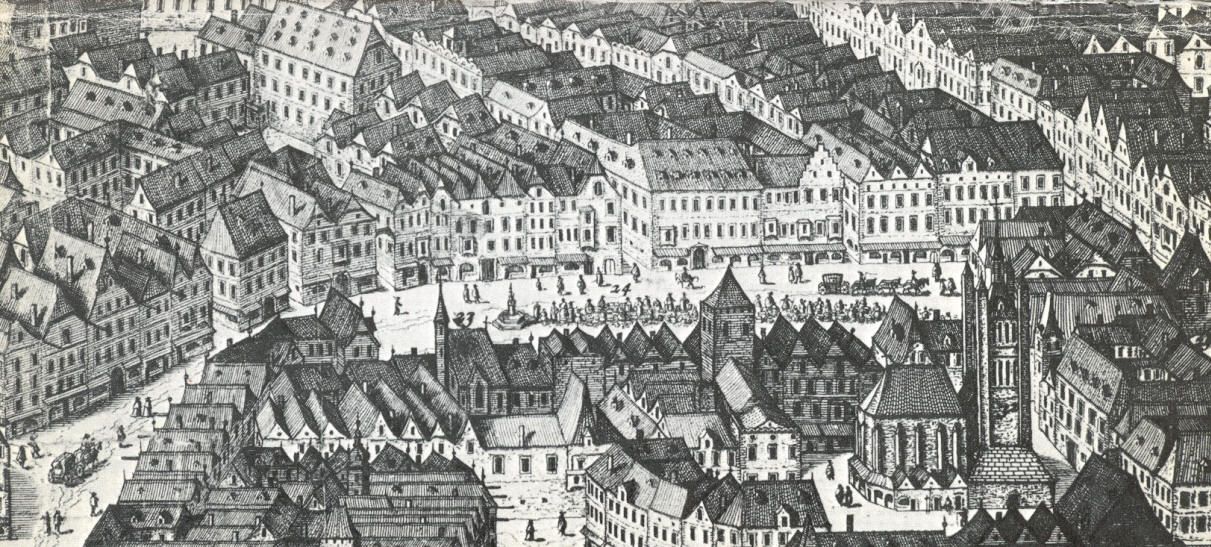
Here are stock photos of how it appeared in 1890 (below left) and in 1900 (below right). It was the first pedestrianized street in Vienna in 1971, first on a trial basis and then the entire extent permanently in 1978.
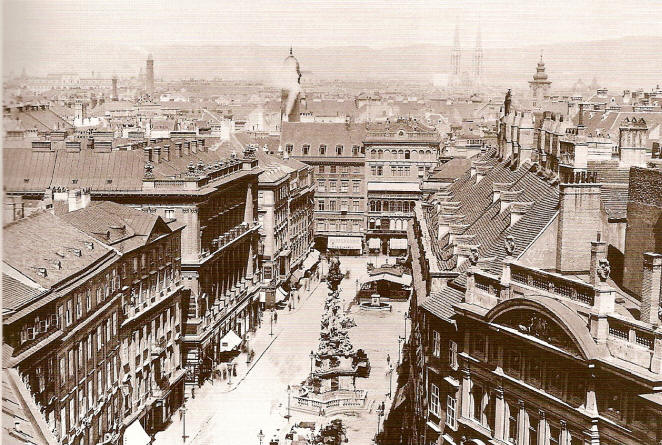
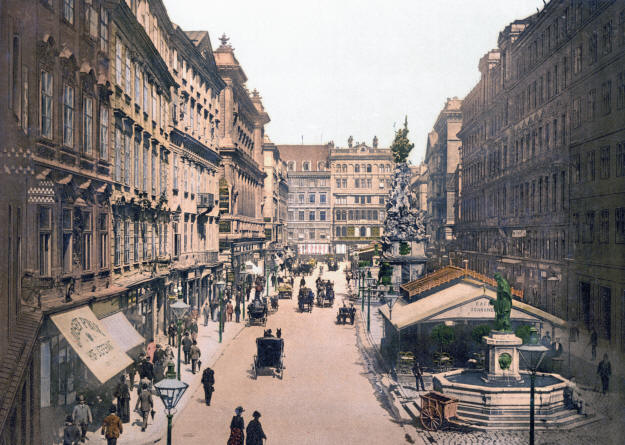
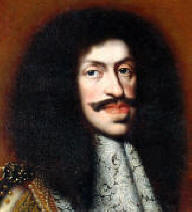 Over the centuries, it went from vegetable markets, then bakers and later
butchers and then to elite residences and ultimately to high-end shopping as it is today.
In the center of The Graben is this extremely ornate Baroque monument called
the Pests�ule (below;
note is in above old photos) which was constructed by Emperor Leopold
I (1640-1705) (right, hard to believe he approved the portrait) following the Great
Plague of Vienna which started in 1679 lasting several years and killing
76,000. The monument was finished in 1689. I got a shot of it from
several
angles.
Over the centuries, it went from vegetable markets, then bakers and later
butchers and then to elite residences and ultimately to high-end shopping as it is today.
In the center of The Graben is this extremely ornate Baroque monument called
the Pests�ule (below;
note is in above old photos) which was constructed by Emperor Leopold
I (1640-1705) (right, hard to believe he approved the portrait) following the Great
Plague of Vienna which started in 1679 lasting several years and killing
76,000. The monument was finished in 1689. I got a shot of it from
several
angles.
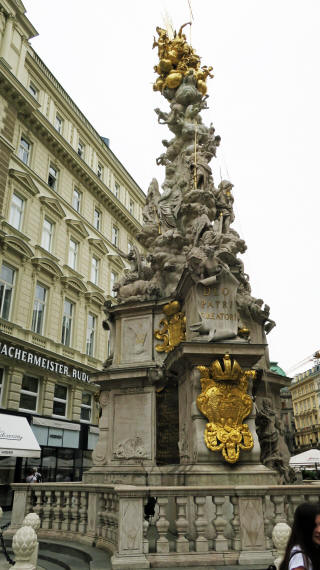
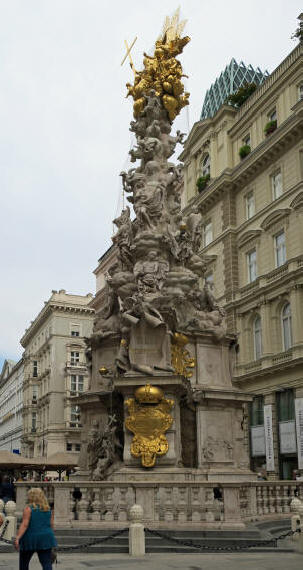
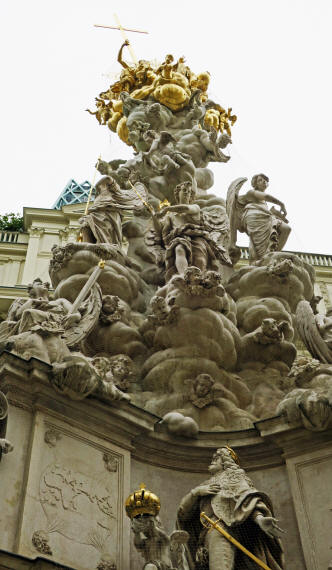
Below left is another of my shots. Below center is a stock photo of the colorful top of it and below right is the crest of Hungary symbolizing Leopold I retaking Hungary from the Turks in the decisive Battle of Vienna in 1683. It is very interesting to read about because it changed world history in stopping the Ottoman incursion into Europe.
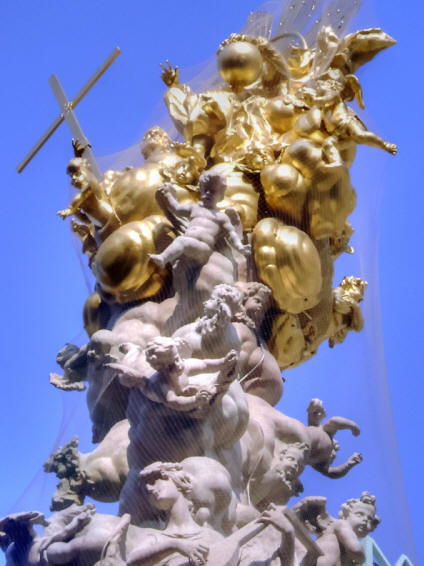

You can see King Leopold kneeling (below right) above the metal sign stating: "Tibi Regi Soeculori Immortali Uni In Essentia Et Trino in Personis, Deo: Infinite Bono Aterno et Immenso ..." meaning roughly "King be immortal, one in essence and three persons in God, the eternal and infinite immensely good ...". Below left are two stock photos.


There is only one street (Habsburgergasse) leading from the Graben to the old city (there are four in the other direction) and it leads to Petersplatz and the Baroque Peterskirche (St. Peter's Church) (below left, stock photo of interior, below center left) which is hidden away in this cul de sac. This may be the oldest church in Vienna since the first one built here was in the early Middle Ages on a Roman fort. It is said that it was replaced with a Romanesque church by Charlemagne around the year 800 which burned down in 1661. Construction of the new church was begun under Leopold I around 1701 and its design was inspired by St. Peter's Basilica in Rome; most of the building was finished by 1722 and it was consecrated in 1733.
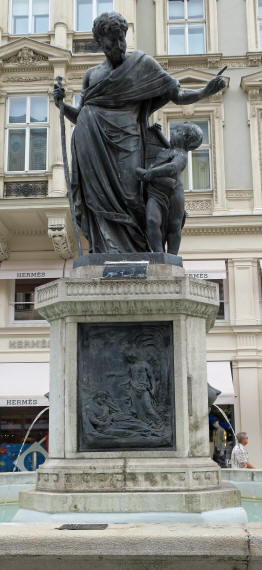
Above center right is the other fountain statue on the Graben, the Josefsbrunnen for St. Joseph. The bronze on the front (above right) depicts the angel appearing to St. Joseph to warn him to escape to Egypt. If you look carefully at the two sides of the base you can see the lions spouting water; these two fountains were installed to use in case of fires.
Above is the view of The Graben looking back toward St. Stephansplatz with the Equitable Building (Palace) just to the left of the Pests�ule. Below is a map of my run from St. Stephan's Dom to the Hofburg Palace.
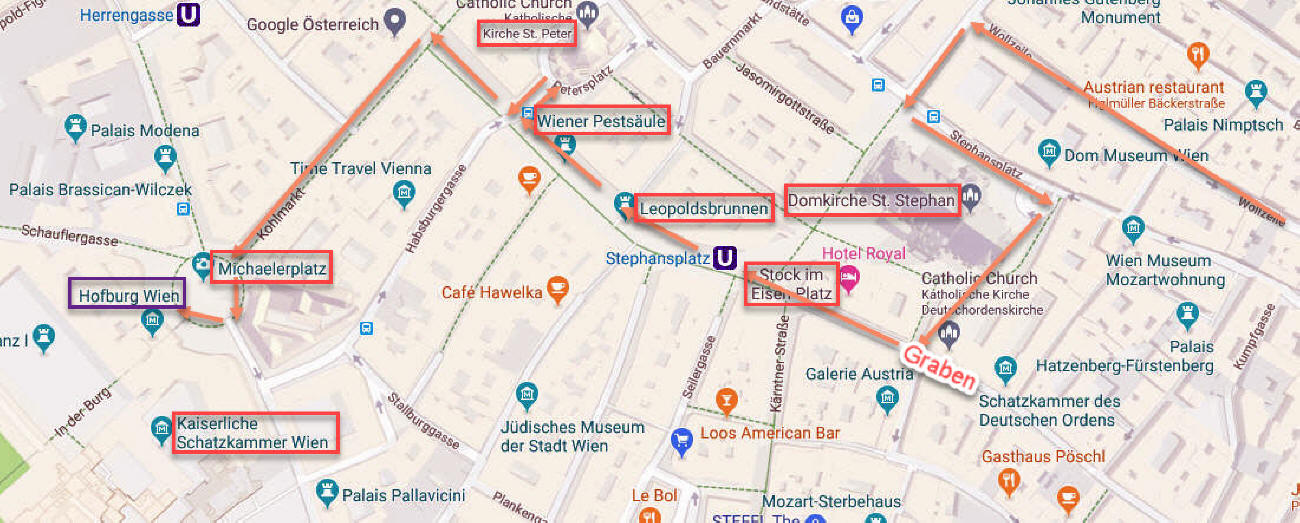
I always get a shot of a local police car. At the end of the Graben is
the Julius
Meinl House [Graben 9,
![]() +43-1-532-3334] with its beautiful columns of six caryatids. It is an extremely
high-end food specialty emporium.
+43-1-532-3334] with its beautiful columns of six caryatids. It is an extremely
high-end food specialty emporium.
 The caryatids are quite beautifully done on the building (below left). I
turn left here and I am now on
Kohlmarkt which is the final block I
have to go to get to my destination, the Hofburg Palace, which is just visible at the
very end (below right).
The caryatids are quite beautifully done on the building (below left). I
turn left here and I am now on
Kohlmarkt which is the final block I
have to go to get to my destination, the Hofburg Palace, which is just visible at the
very end (below right).
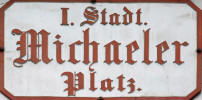 At 10:30 AM, I arrived at Michaelerplatz, a traffic circle in front of the
Hofburg Palace. Here it is in all its splendor. As you will see, the
beauty of this city is unrivaled in Europe for the sheer intricacy and splendor of its
edifices and statuary. This part of the Hofburg is called the St. Michael's Wing.
At 10:30 AM, I arrived at Michaelerplatz, a traffic circle in front of the
Hofburg Palace. Here it is in all its splendor. As you will see, the
beauty of this city is unrivaled in Europe for the sheer intricacy and splendor of its
edifices and statuary. This part of the Hofburg is called the St. Michael's Wing.

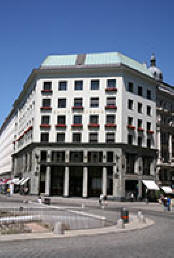 If you turn around from this view you will look to the left and see a very
historic building (below and right) called the Looshaus. It was quite
revolutionary in its day. People now hardly notice the building, but when
it was built in 1911, the Looshaus caused quite a controversy due to its modern
fa�ade void of decorations, something very unusual in Baroque Vienna.
If you turn around from this view you will look to the left and see a very
historic building (below and right) called the Looshaus. It was quite
revolutionary in its day. People now hardly notice the building, but when
it was built in 1911, the Looshaus caused quite a controversy due to its modern
fa�ade void of decorations, something very unusual in Baroque Vienna.
Adolf Loos was influenced by the nascent skyscraper architecture that he had seen on a trip to the United States, and employed a business-like style with straight lines and little or no decoration. The modern design caused such an outcry that construction was even temporarily halted. Loos was only allowed to continue after he promised to decorate the facade with balcony flower boxes. Emperor Franz Joseph I despised it and it is said that the curtains in the wing opposite the Looshaus were always closed so he wouldn't have to look at it. Today the building is considered an example of groundbreaking modern architecture. Below are stock photos of the front (left) and interior (right).
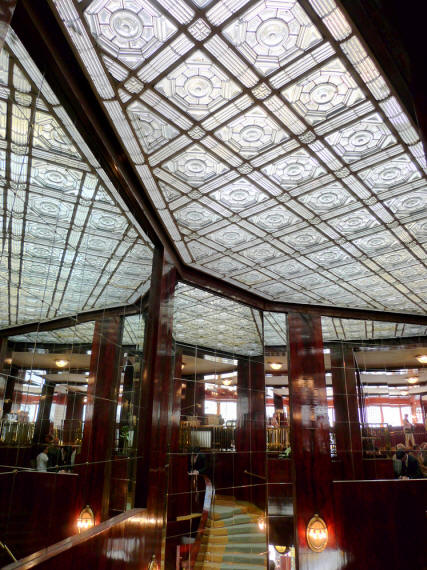
I never noticed it as I passed right by it. The other thing I completely missed was that during construction, right in front of the palace, they unearthed ruins of a Roman camp.
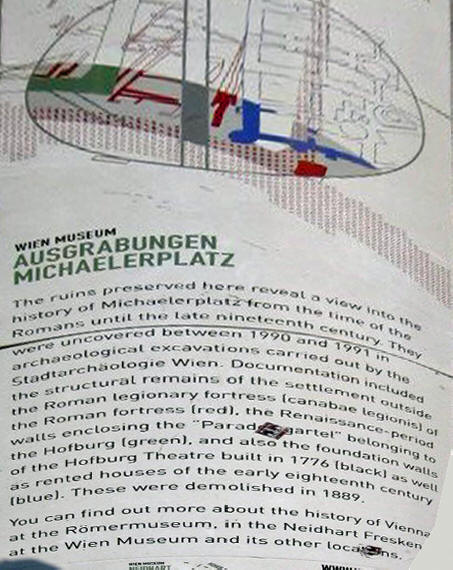
It was hidden behind the little wall enclosing the remains. All I had to do was look over the edge of the wall and I would have found it. I'm usually good at ferreting out such things but this one totally escaped me. Of course, below are stock photos of it.
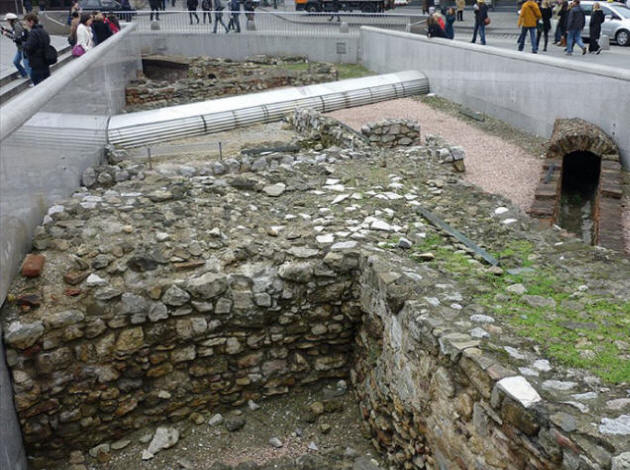
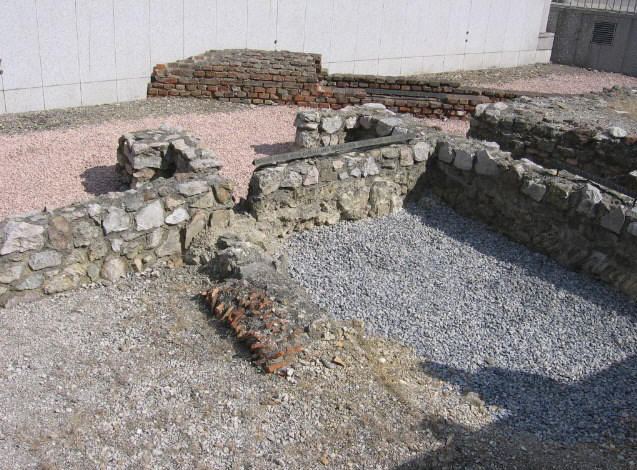
After taking some photos of the outside of the Hofburg, I ran inside and purchased a ticket (below) to get in: �13.90 ($15.85) for Silver (seniors; regular is �17 ($19.38)) which includes the Kaiser Apartments, the Sisi Museum and the Silberkammer. I also bought two souvenir lapel pins for my pin collection for �7.80 ($8.90).
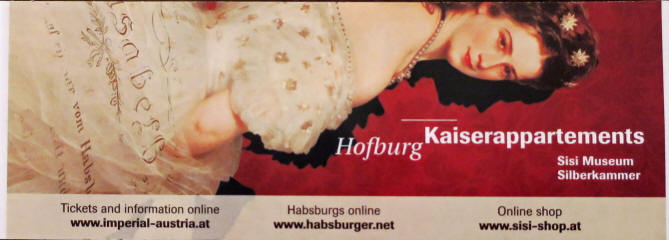
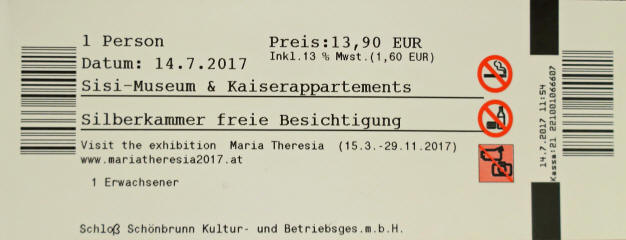
I then came back outside to photograph all the magnificent statuary on the buildings. The two corners of the building each has an intricate fountain statuary. The one on the left side is of a man (below left, center) called the "Mastery of the Land". It was designed in 1897 by Edmund Hellmer and symbolizes the Austrian army. On the right is a woman (below right) and is called the "Mastery of the Sea". It was sculpted in 1895 by Rudolf Weyr and symbolizes the Austrian naval power.
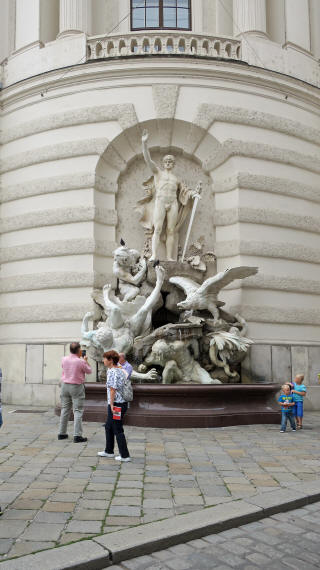
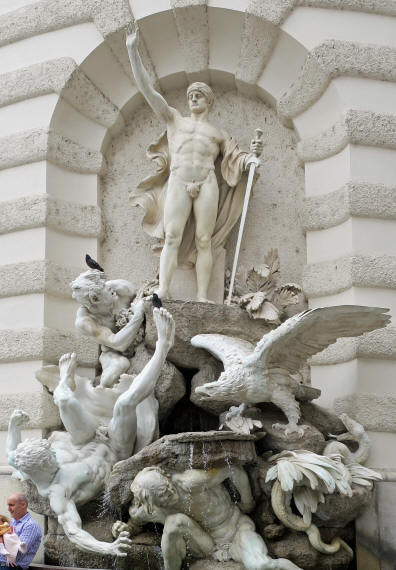
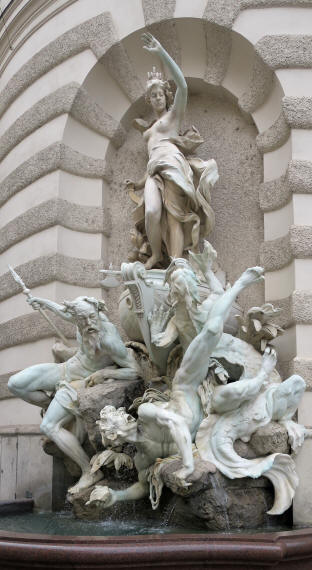
You can see that the detail on these statues is well kept up (below left).
Looking across from the Hofburg, is
St.
Michael's Church [Habsburgergasse 12/Michaelerplatz 4-5,
![]() +43-1-533-8000] (below right) built in Gothic and Romanesque style from 1220-40 and
unchanged since 1792. It used to be the parish church of the Imperial Court.
+43-1-533-8000] (below right) built in Gothic and Romanesque style from 1220-40 and
unchanged since 1792. It used to be the parish church of the Imperial Court.
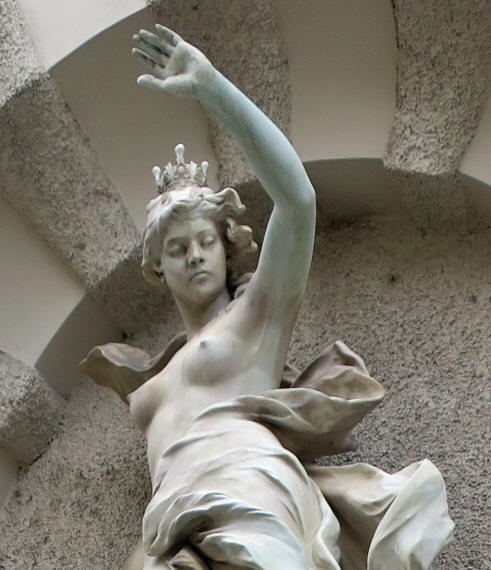
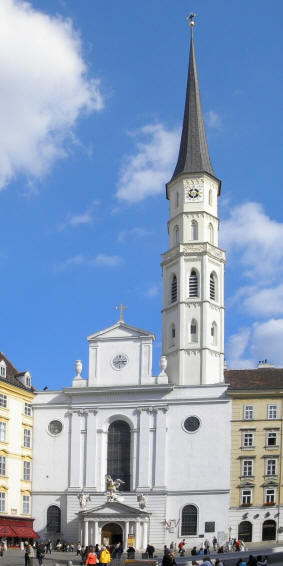
Above right is a better stock photo of the church and below left is one of the altar. Below center is one looking back at the beautiful organ. St. Michael's is famous for its Michaelergruft, a large crypt located underneath the church; entry below right). Aristocrats were able to access their family crypts through marble slabs marked with their coats of arms in the church main floor.
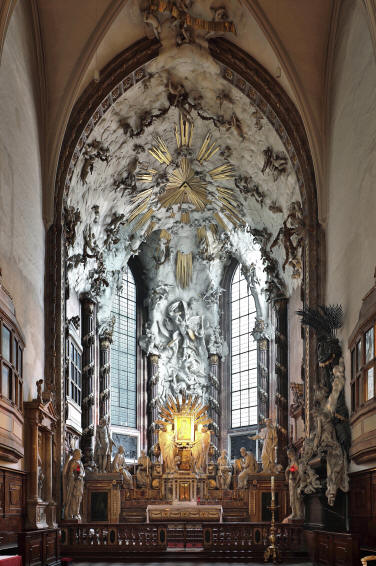
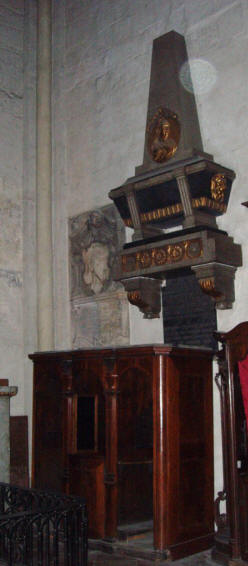
The coffin of a deceased member of the family could then be lowered directly into the crypt via these marble slabs. Due to the special climatic conditions and constant temperature in the crypt, more than 4,000 corpses were kept well preserved. There are hundreds of mummified corpses on display, some still in burial finery. Below is a stock photo of the beautifully intricate marble statue of "The Deposition of Christ" which is in the church.
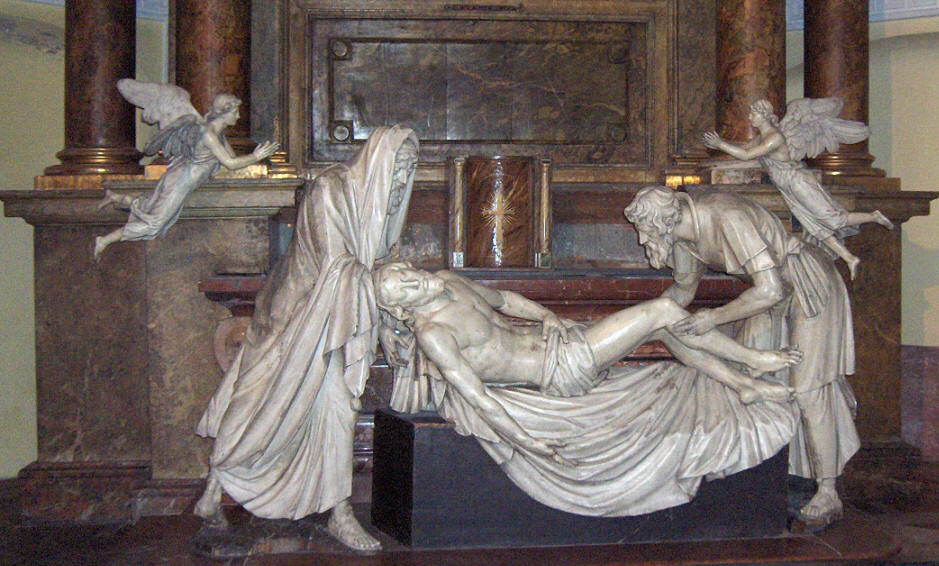
Now, let's look back at the entry door of the Hofburg Palace (Michaelertor) (below left). Looking up at the writing above the entry (below right), it states: "Franz Joseph I: an old palace - the work was finished by Maria Theresa and Joseph Charles II, 1893 to continue".
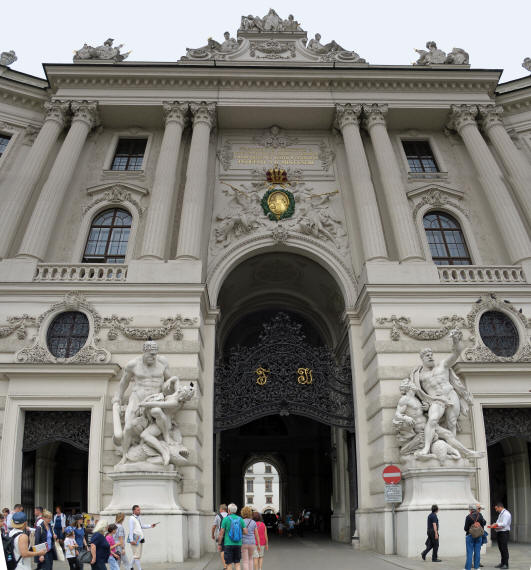
Of course there are two huge statues on either side of the entry way. They are of Hercules performing his daring feats. On the left is one of Hercules stealing the belt of Hippolyte (queen of the Amazons) (his 9th Labor) and on the right is him killing the Stymphalian birds (his 6th Labor). These are directly next to the main entry gate.
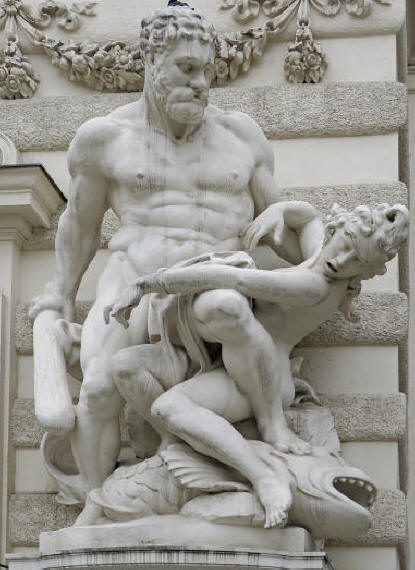
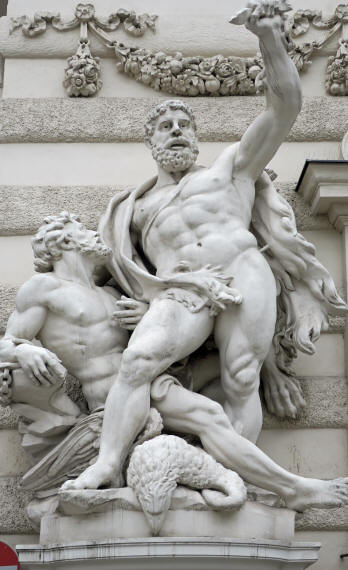
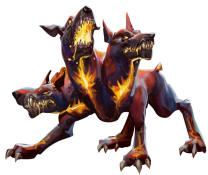 Below are the two on either side of the secondary doors next to the entry. The one on the left is of Hercules
slaying the nine-headed
Lernaean Hydra (his 2nd Labor) and on the right is him capturing
Cerberus (right), the three-headed
dog of Hell (his 12th and final Labor) which set Hercules free at last.
Below are the two on either side of the secondary doors next to the entry. The one on the left is of Hercules
slaying the nine-headed
Lernaean Hydra (his 2nd Labor) and on the right is him capturing
Cerberus (right), the three-headed
dog of Hell (his 12th and final Labor) which set Hercules free at last.
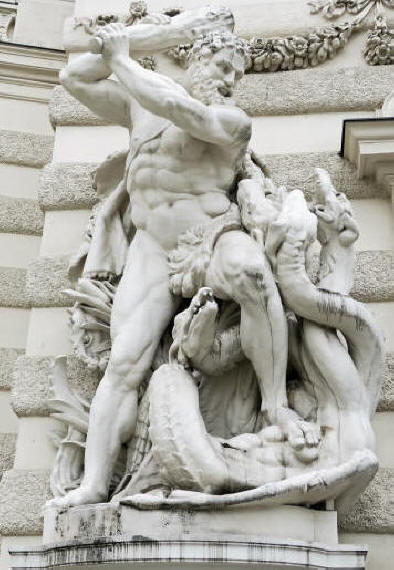
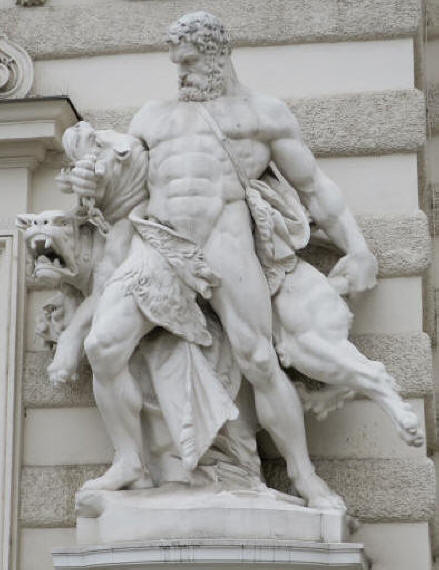
The websites below describe all the Twelve Labors, if you are interested.
In the photo below you can see that there are many more Hercules statues adorning the other structures.
The Hofburg Palace [![]() +43-1-533-7570], started in the 13th Century,
+43-1-533-7570], started in the 13th Century, 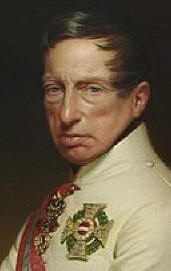 is the former principal imperial
palace of the Habsburg
dynasty rulers and today serves as the official residence and workplace of the President
of Austria. There are 2,600 rooms in 18 buildings, 54 staircases and
19 courts but only 24 rooms are open to the public. The below stock photo
is the Neue Burg Section (Art Gallery section) with the Heldenplatz in front
with two statues. The one in the forefront is of
Archduke Charles (1771-1847) (right).
is the former principal imperial
palace of the Habsburg
dynasty rulers and today serves as the official residence and workplace of the President
of Austria. There are 2,600 rooms in 18 buildings, 54 staircases and
19 courts but only 24 rooms are open to the public. The below stock photo
is the Neue Burg Section (Art Gallery section) with the Heldenplatz in front
with two statues. The one in the forefront is of
Archduke Charles (1771-1847) (right).
The extent of this place can be seen in this stock aerial photo. You can see the entry when you find the dome (upper right). Below right is a stock photo of what it looked like up until the 16th Century.
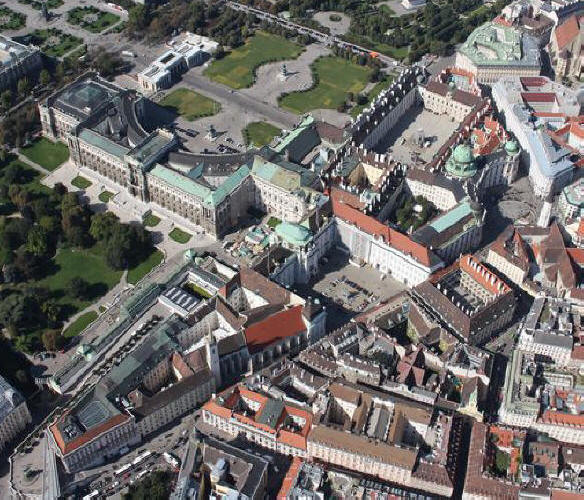
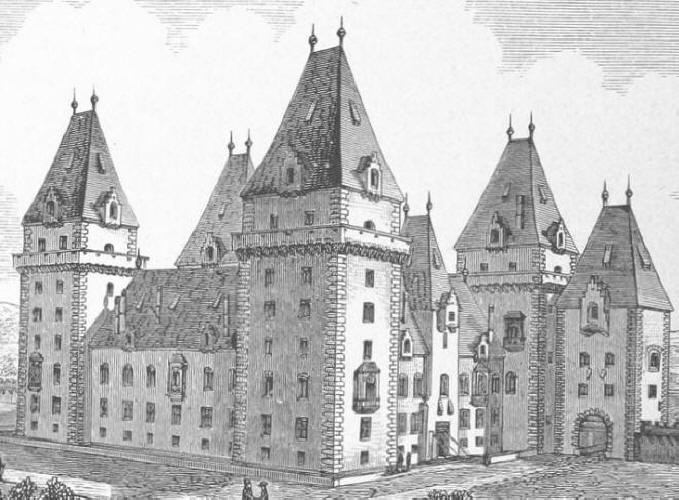
Before we go inside, let's take a look at its layout. Historical construction stages are color coded: TAN: 13th-17th Century, BLUE: 18th Century, GREEN: 19th-20th Century. An index to the map is below on the right. I am coming in from C and entering 13. A is the inner courtyard I will take a rest at.
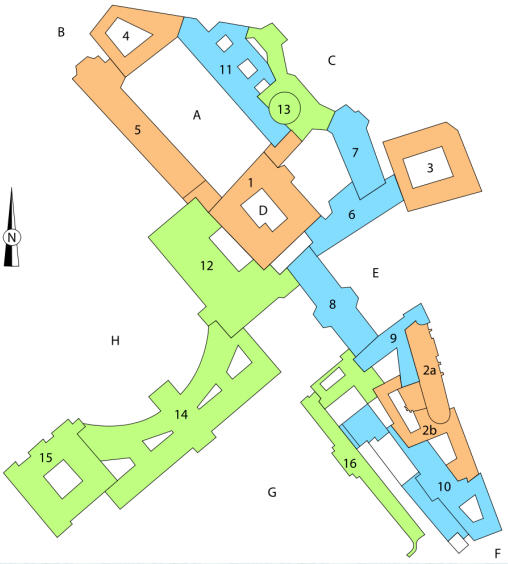
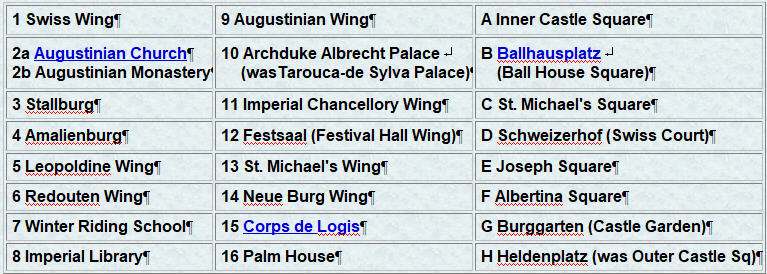
As you can see, this place is humongous. It houses the Imperial Apartments, the Sisi Museum, the Imperial Silver Collection, the Ancient Music Institute, the Winter Spanish Riding School, the Ephesus Museum, the Museum of Fine Arts, the Collection of arms and armor, the National Library in the Grand Hall, the Imperial Chapel, the Treasury, a Papyrus Museum and the Butterfly and Palm House. I hope I can cover it all in one day.
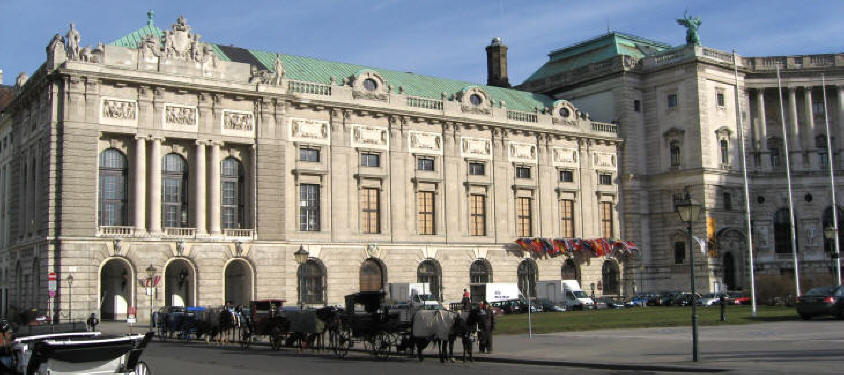
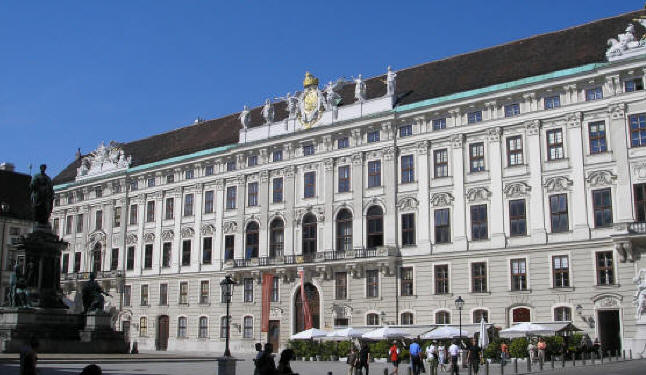
Here are some of the exterior views of various parts of the palace; the Library is left (left).
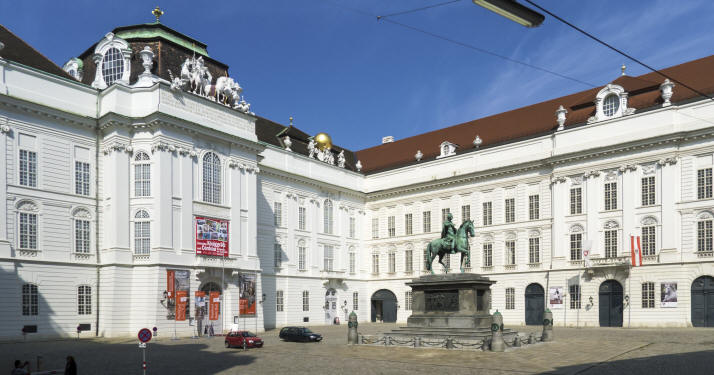
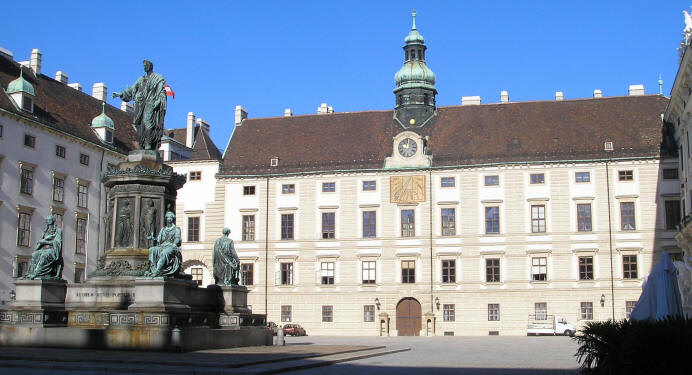
Below left is the part where the Austrian President lives. Center is a stock painting of a grand dinner party inside and on the right is an example of the corridors.
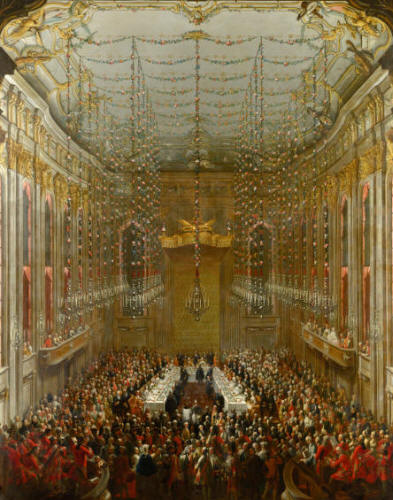
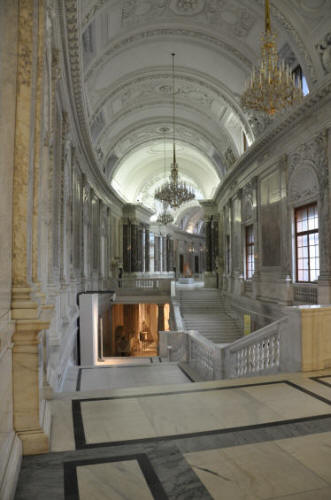
Here are stock photos of the Imperial Apartments (left), an orchestra recital in the theater (center) and the Imperial Chapel (right).
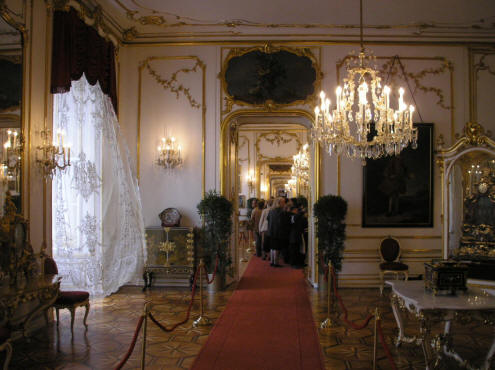
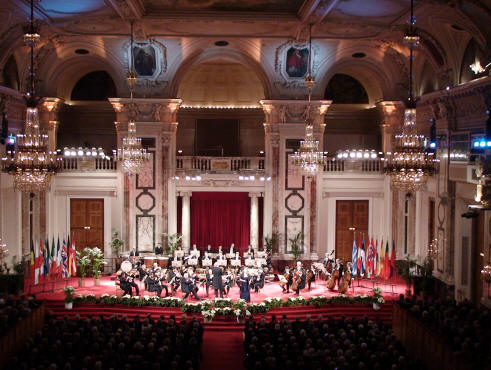
Now its my time to explore. I enter under the dome to see the museums (stock photo).
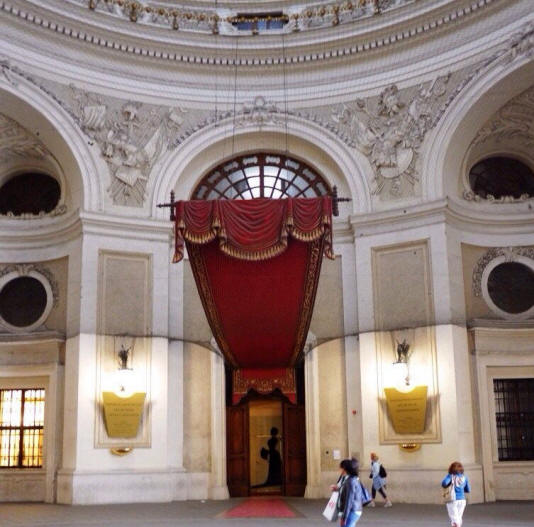
The Imperial Silver Collection (SILBERKAMMER)
The first museum that I decided to explore was the Imperial Silver Collection with its displays of the imperial dining ware. It starts with an explanation of how they dined here in the 1800s.
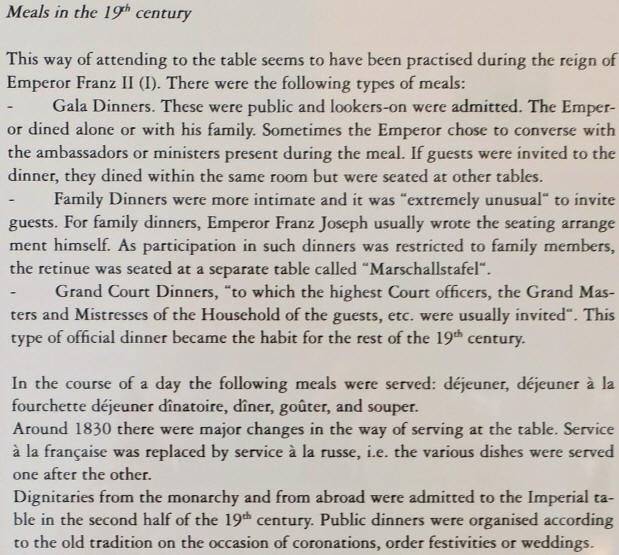
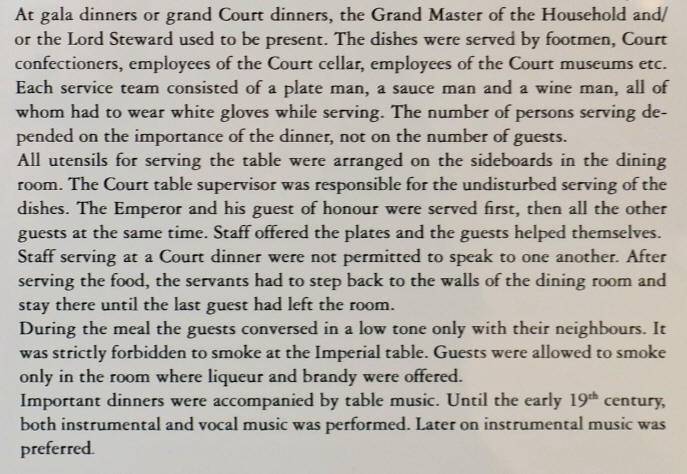
This left side got cut off a little, but you can fill in the missing words.
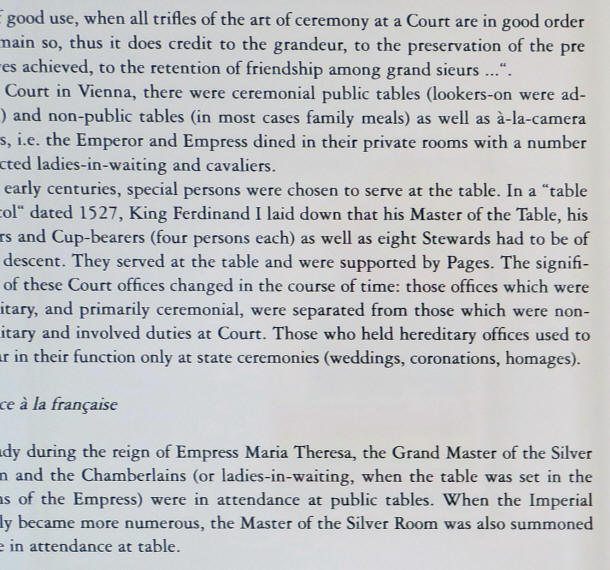
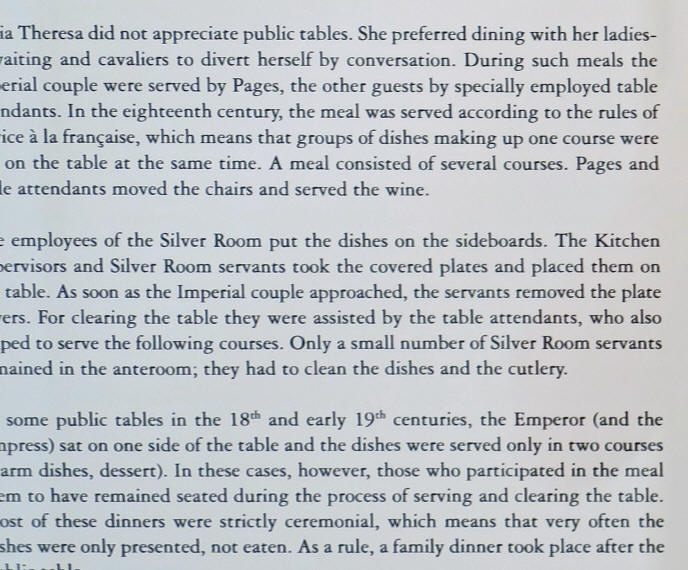
I first came across the silver and gold metal serving sets and plates in these cabinets.
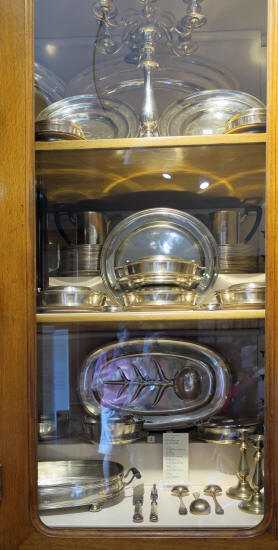
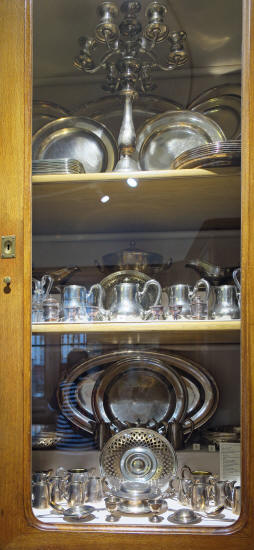
It seems that every surviving plate is on display here.
Below is a large mirrored centerpiece with serving dishes and gold candelabras.
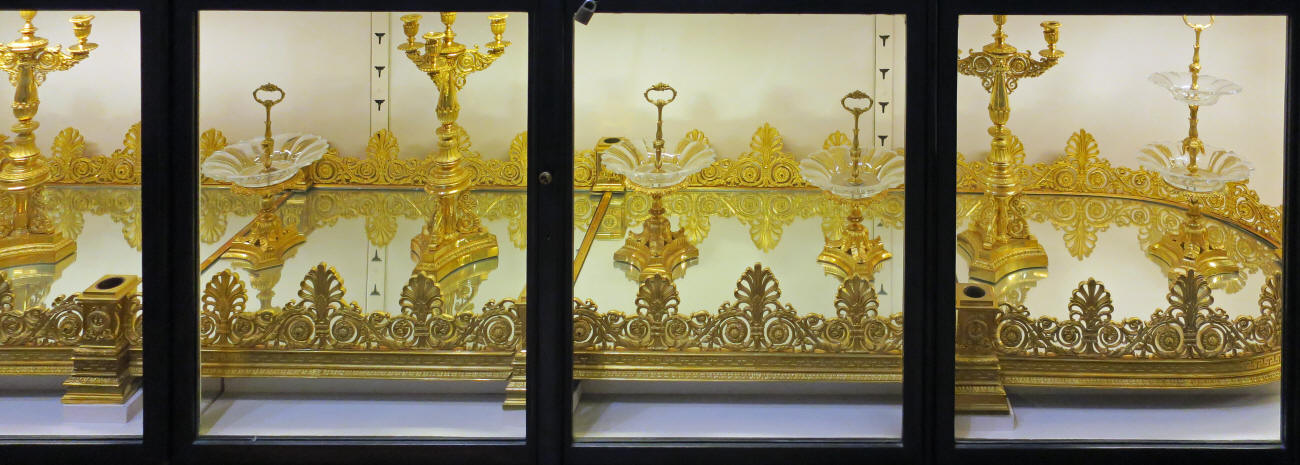
There are cabinets and cabinets of precious metal serving vessels of different varieties.
There were a lot of beautifully ornate candelabras.
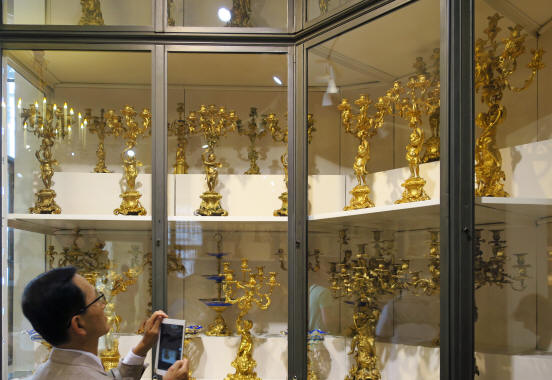
There were piles of silver plates and serving dishes.
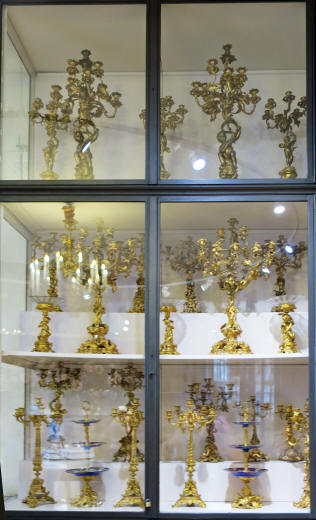
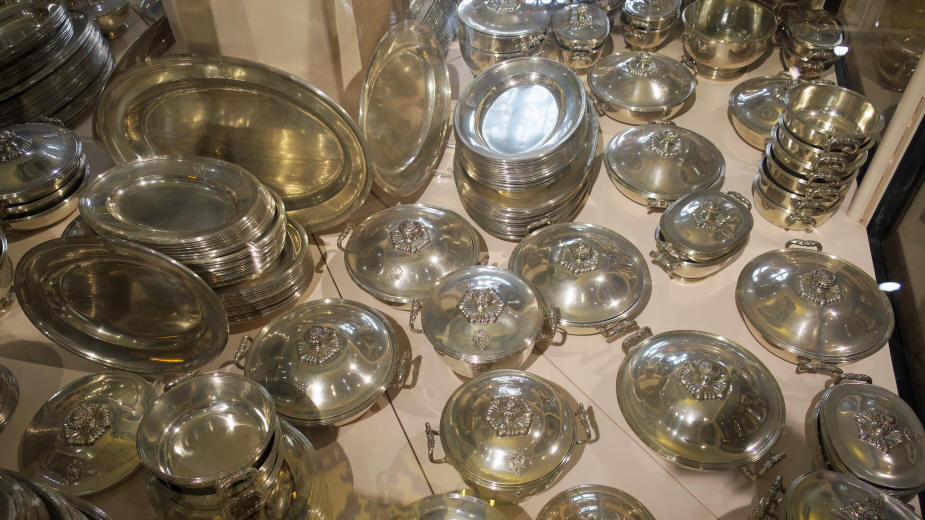
Below is a sample royal dinner place setting.
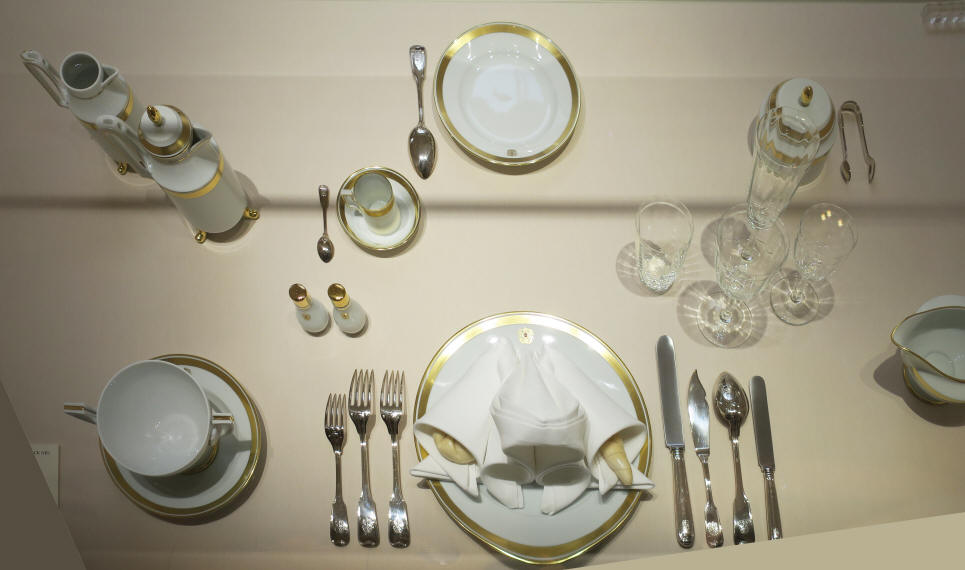
There was a section displaying plates with intricately painted scenes (left, center) and some with flowers (right).
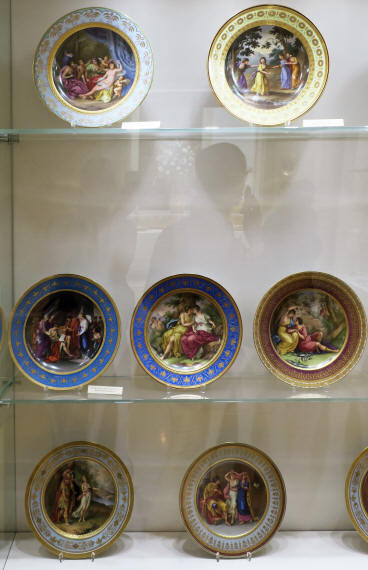
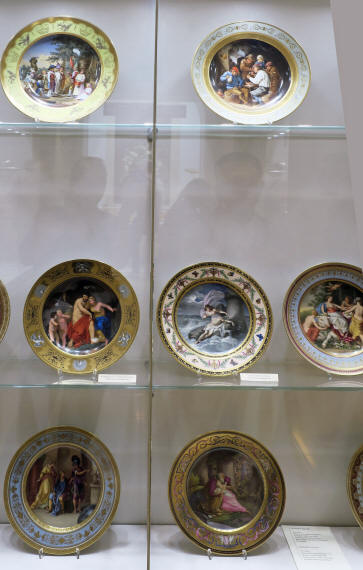
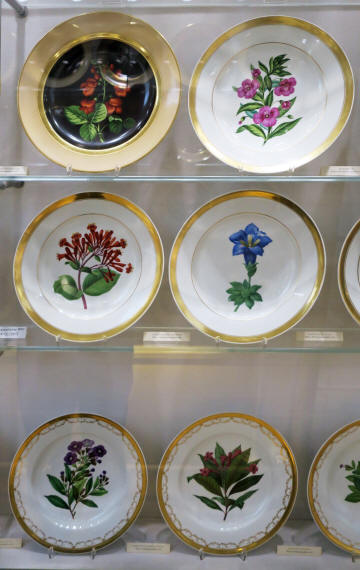
Here is the description of the flower plates.
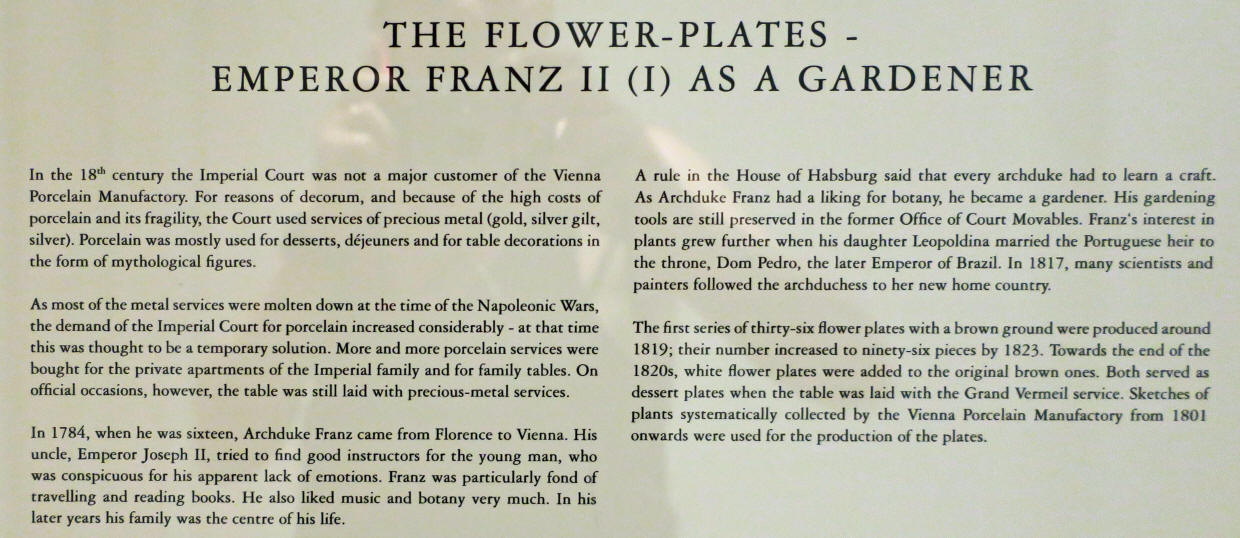
These are quite nice.
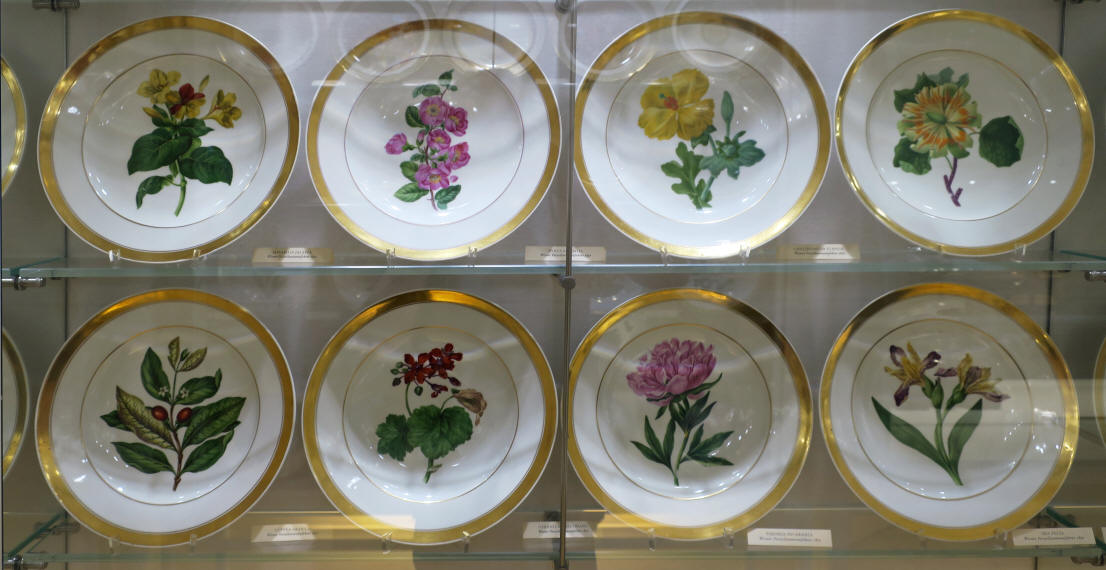
Some plates are extensively decorated.
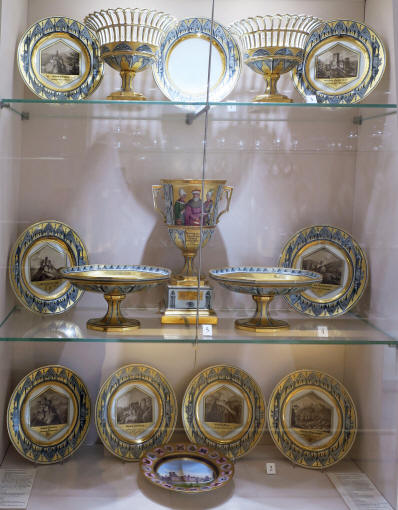
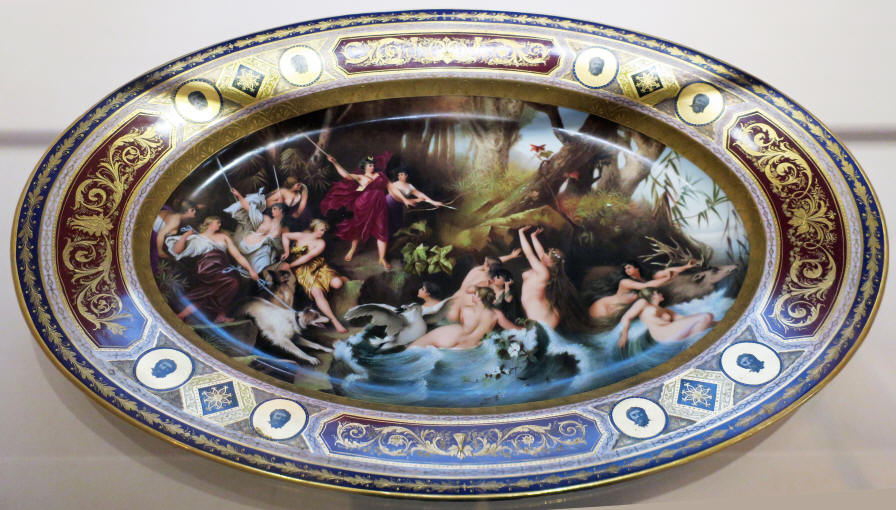
Many gold-lined serving bowls.
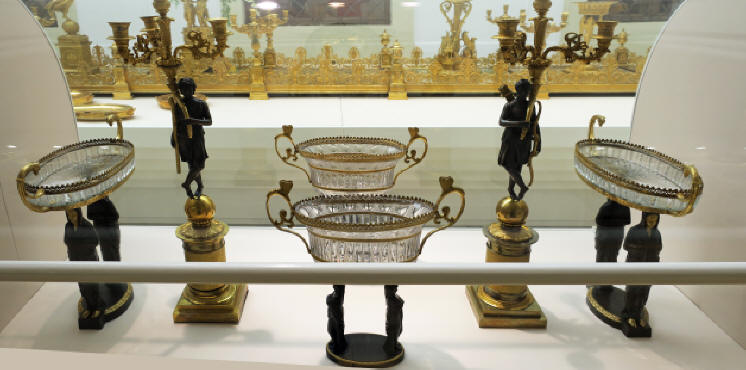
Another very long gold mirrored centerpiece extending down a long table (below left) and ending in a tiered display of candelabras (below right).
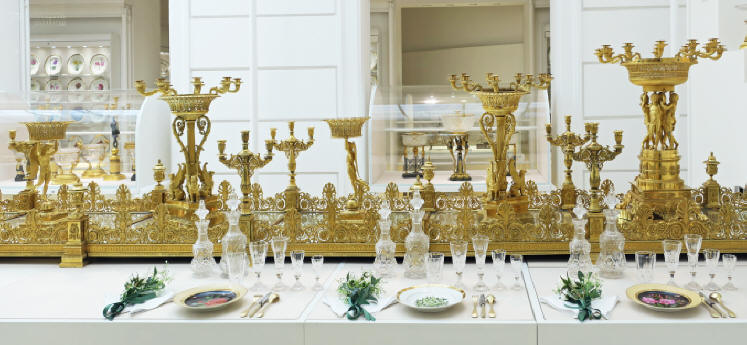
Below left is a display of various fancy jars and below right is an interesting piece showing "icons" and cups with the images of kings.
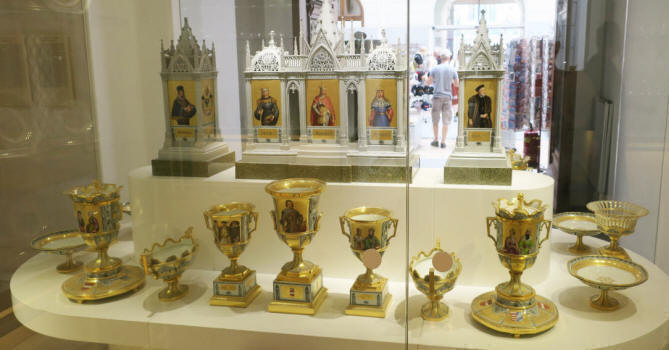
A closer look shows they are of (L-R): Rudolph II, Albrecht I, Rudolph I, Friedrich II and Karl V.
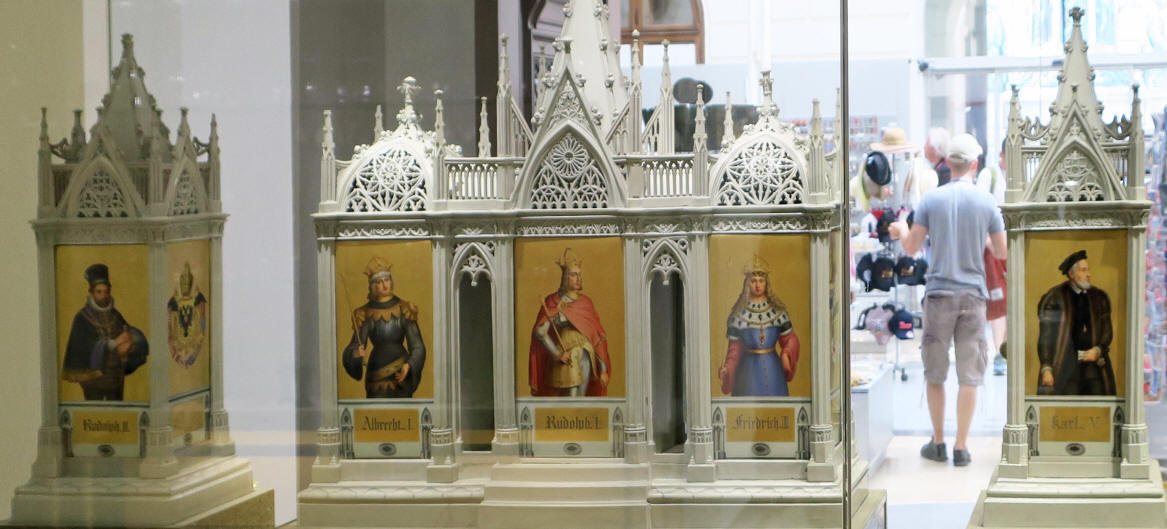
These cups weren't labeled as to who the pictures were of.

And more displays of dishes, plates and cup.
Here are large detailed porcelain statues of Emperor Franz Joseph and his wife Elizabeth ("Sisi") and more beautiful dishes.
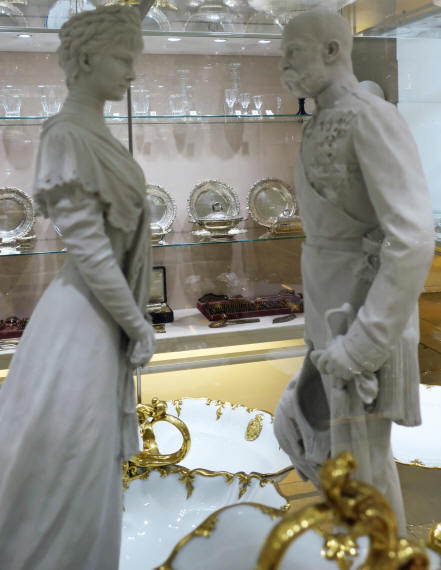
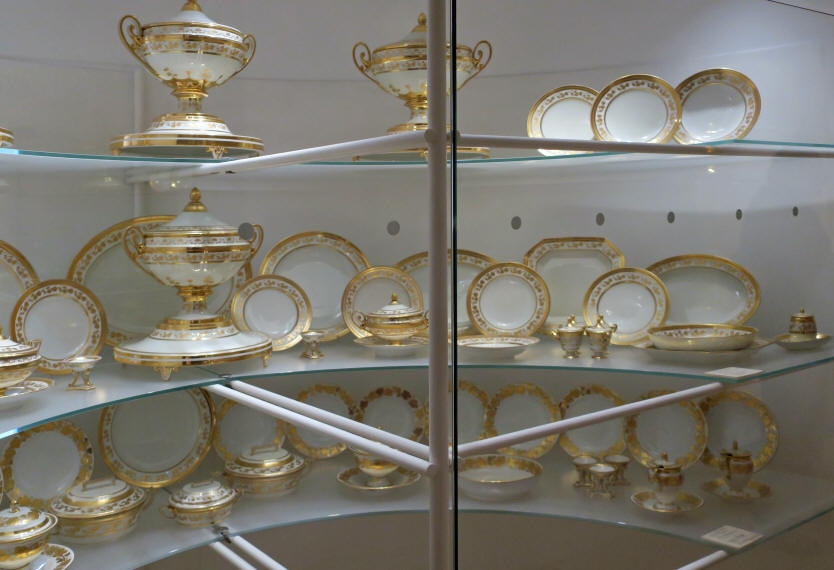
Below are some pretty elaborate candelabras.
Here are other varieties of serving dishes.
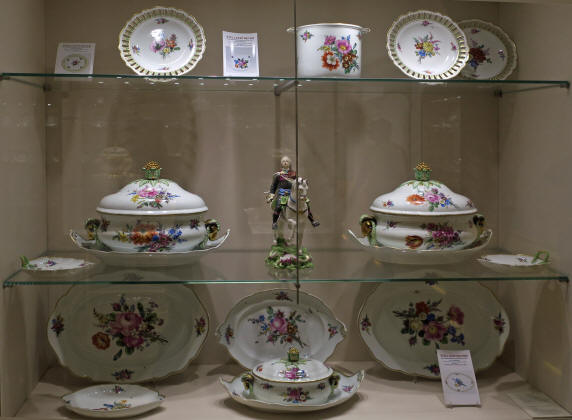
More serving bowls (upper) and intricate napkin foldings (lower) and a slightly blurry shot of gold bowls.
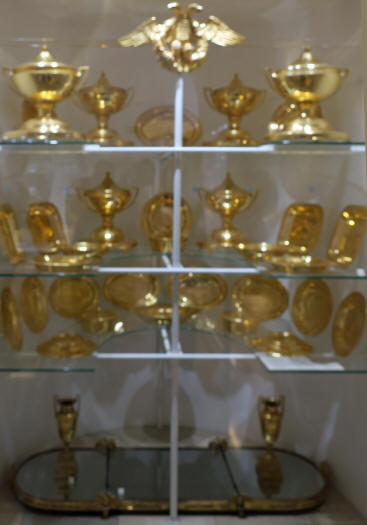
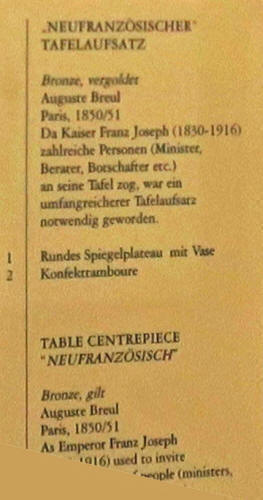
More of Franz Joseph's bronze gilt centerpieces circa 1850 (above, below).
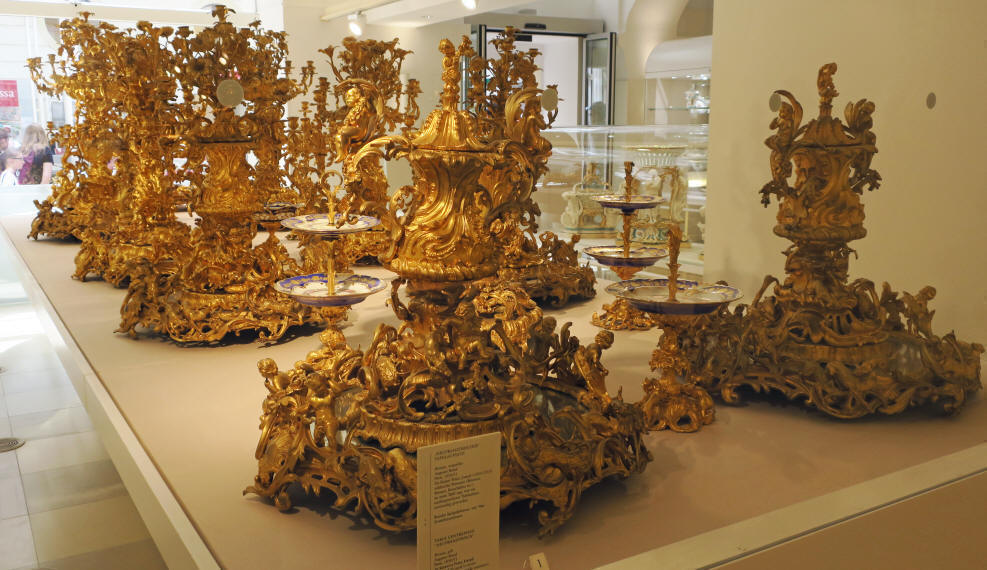
It took PhotoStitch to put this large eclectic display in one photo.
There are displays of porcelain figurines (below left) and silverware sets (below right).
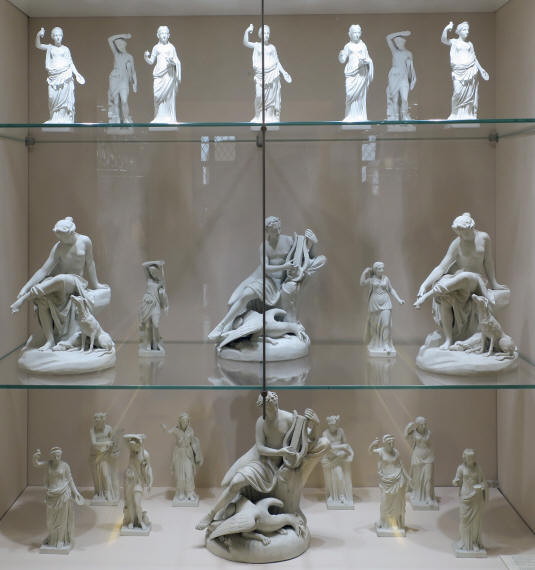
More dishes and table setting figures (below left). I was forced to take a photo of myself (in my running gear) to get a shot of this mirrored door which allowed a shot of the perspective of this place.
I wasn't the only one taking photos of "dishes".
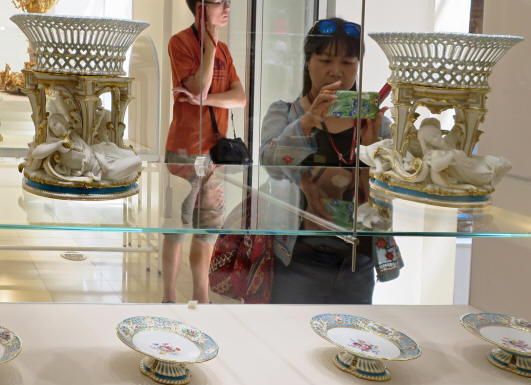
It seemed to never end. Makes one wonder what all this cost and where the money came from.
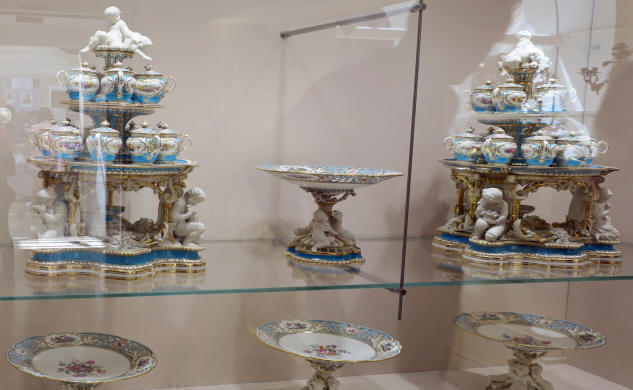
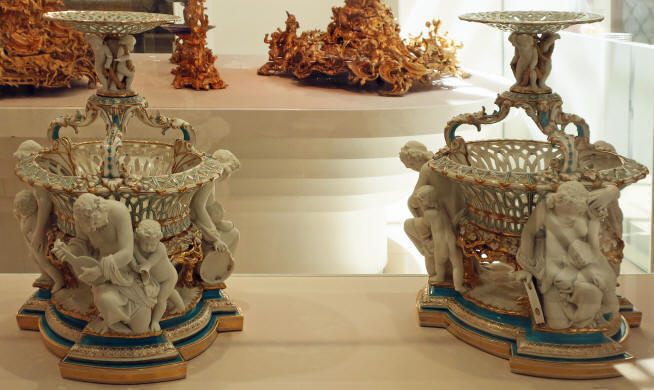
It is now 10:45 AM and I finished with this "dish" museum. It was time for a rest and a cappuccino. Nearby the exit was the convenient Cafe Hofburg (below) and my cappuccino that Natalie brought me cost �5.50 ($6.27); on the expensive side for such a small couple of sips.
It was good but small. They had a lot of tempting baked goods that I passed on.
They had this very large painting of the Sch�nbrunn Palace that I will ultimately visit this week.
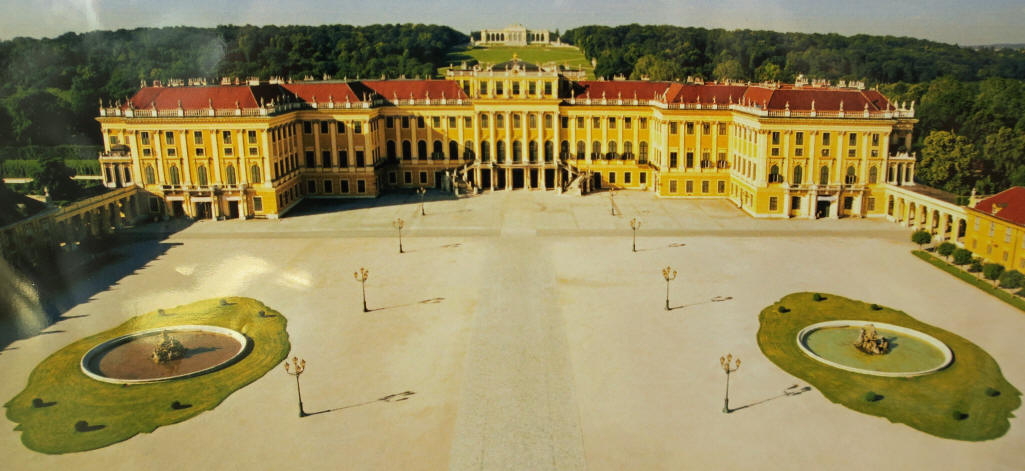
After 30 minutes of relaxing, it was time to get back at it. I walked out the interior exit door and wound up the very large inner courtyard which is called the Inner Castle Square (PhotoStitch below). In the center is this large statue.
I walked to the opposite corner and got a shot of it from behind.
I got a shot of it face on. A blowup of the clock above the sundial shows it is 1:25 PM.
The statue is large and quite impressive. I was fascinated with the whole display and got shots of it from every angle.
First, an up-close of the figure (left) and then the base (right) with statues of women.
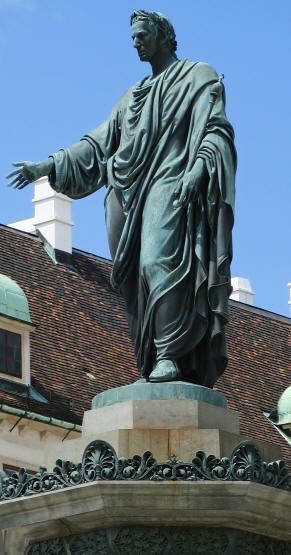
Here is the base from the other side ...
... and here from a third angle. I have no idea what the women represent, but this one (left) is holding a crucifix and the one on the right is holding a sword and a olive branch.
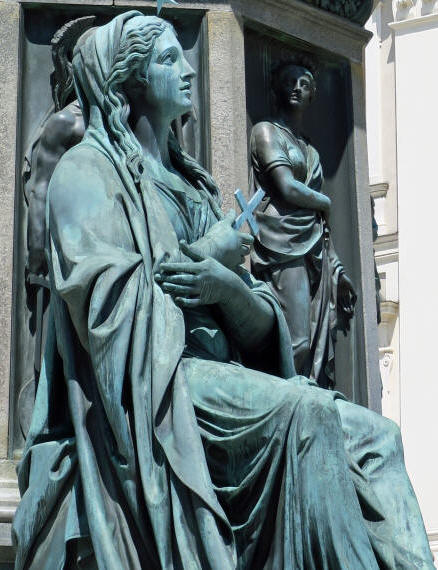
I focused on the main figure, trying to figure out who it was. With wreath crown I was guessing it was Julius Caesar.
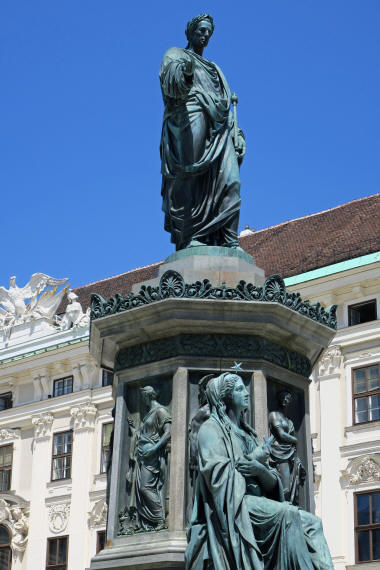
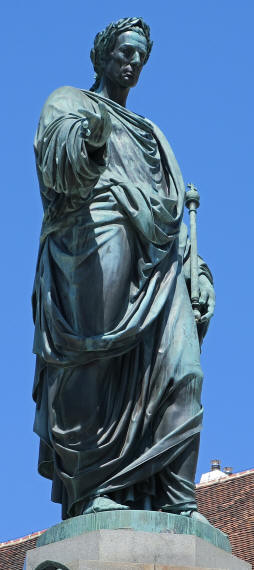
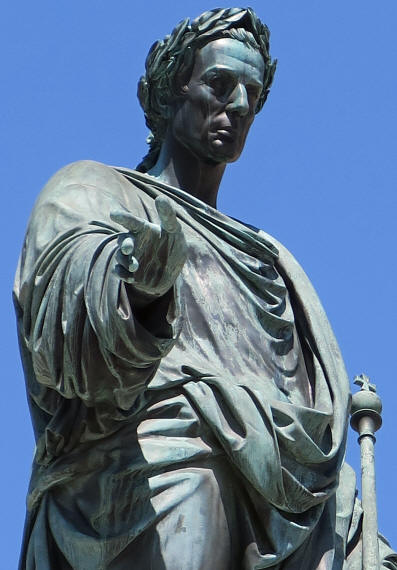
But I was wrong. It is of Kaiser (Emperor) Franz Joseph I (1830-1916). Looking at photos of him from 1905 (center) and 1915 (right), I don't see the likeness. Since he was considered the "last Holy Roman Emperor" maybe the sculptor made him in the image of Julius Caesar.
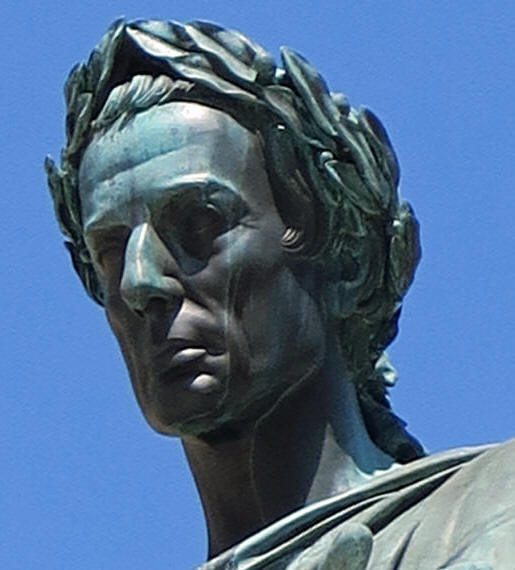
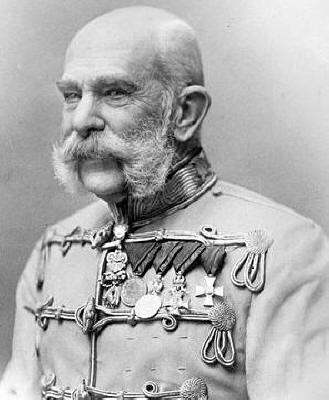
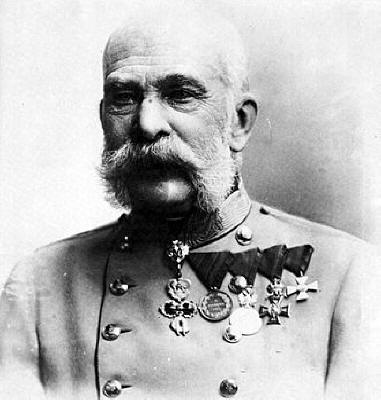
Relaxing over, it is now time to get back at it, so I went back inside climbing the beautiful marble staircases ...
... and the next logical section to visit is the special dedication to their Hungarian Empress Elizabeth who was affectionately known as "Sisi" located in the Kaiser Apartments section.
the Sisi Museum
Below are the entrance signs along with this beautiful statue of her in the entrance.
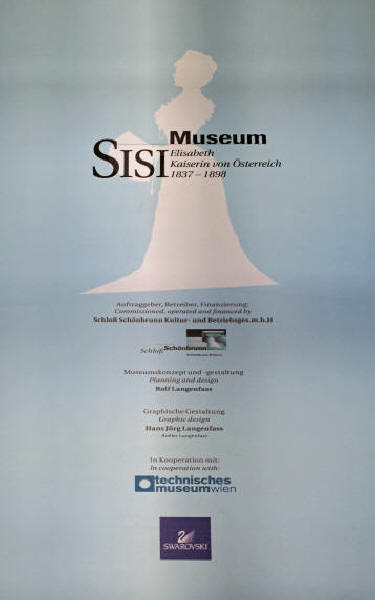
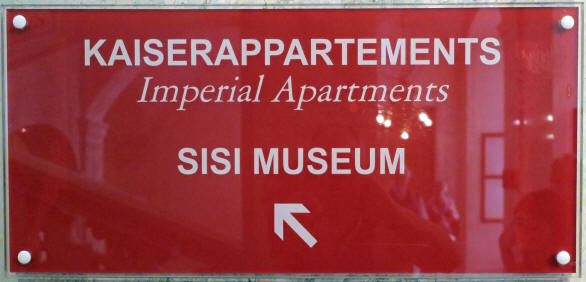
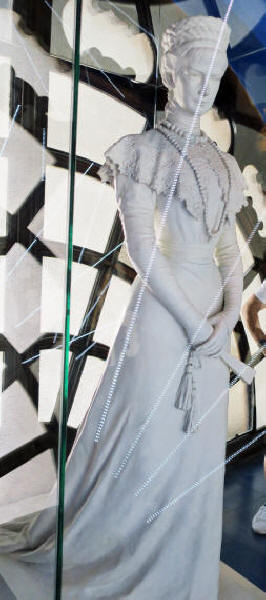
Inside the room was this full scale model of the whole palace and its grounds, which was her home.
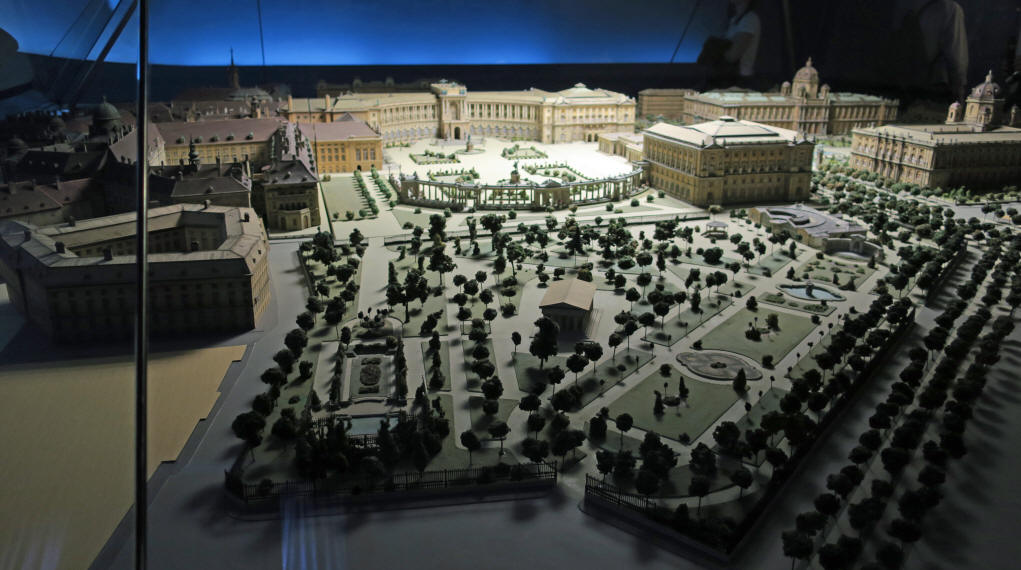
Next was a display showing many of her personal items. Heinrich Heine was her favorite poet, so their are some of his books from her private library (center right) and her miniature secretaire.
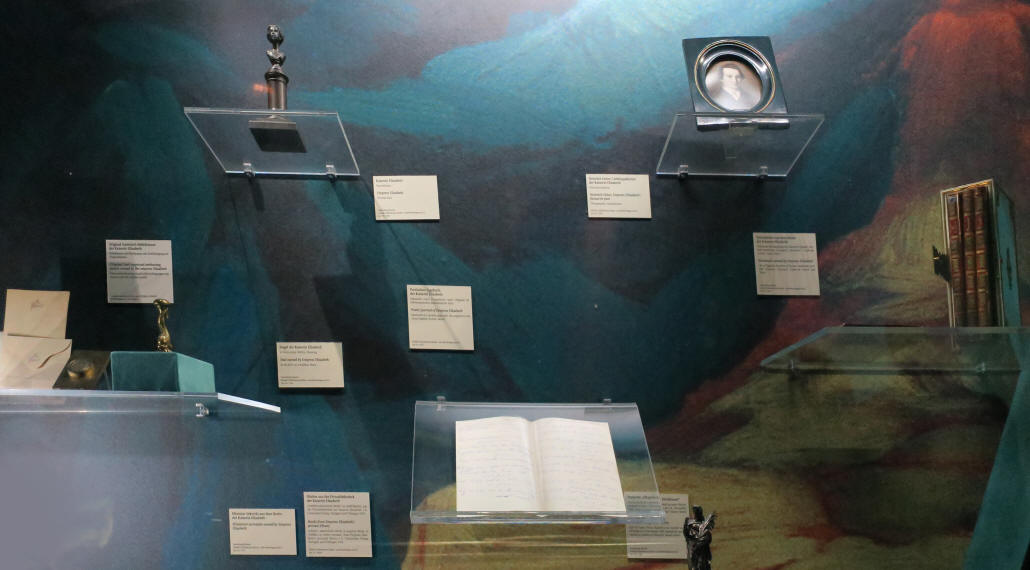
There was a small portrait bust of the Empress (above, upper left) and a statuette (above, lower right) titled "Allegarie des Dichtkunst", which was a gift from Prince Rudolf in 1898 (photo above, upper right). Below is a blowup of the original steel engraved embossing punch (left) used by the Empress and one of the Empress's notebooks (right) showing her handwriting.
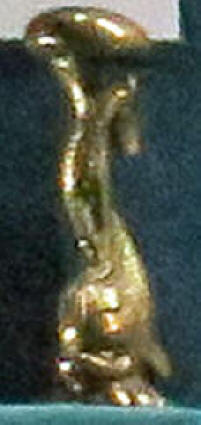
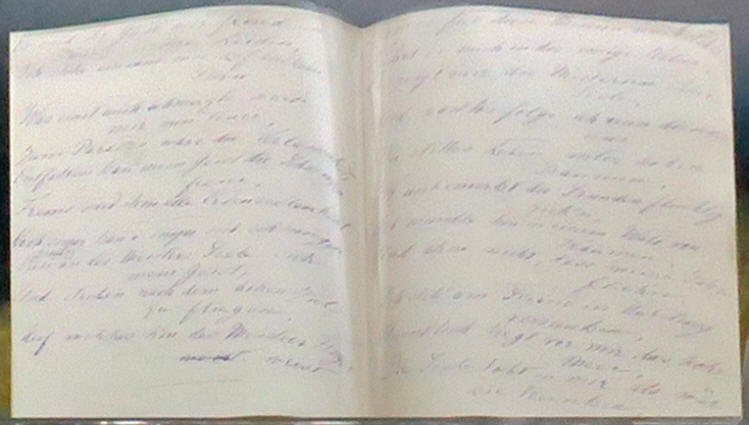
In the next room, the wall held these large genealogy charts of the House Hapsburg. Center is from 1273-1740 and on the right is from 1740-1918.
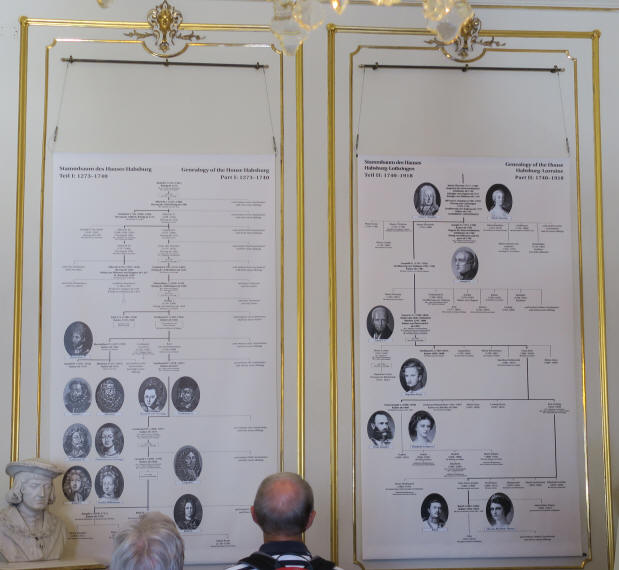
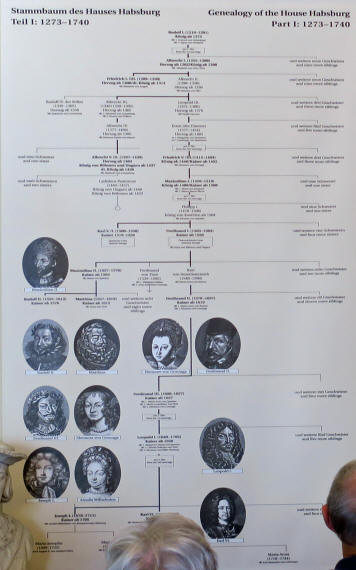
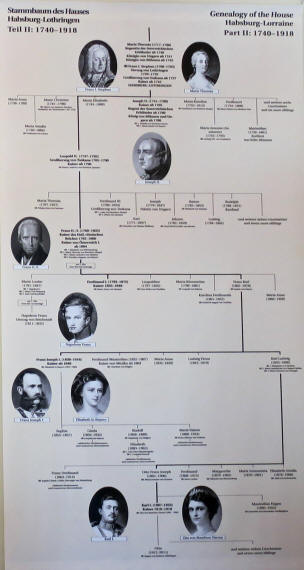
Here is a blow-up of her and her husband (below left). They had a display showing her luxurious train compartment. I wish Amtrak had ones like this.
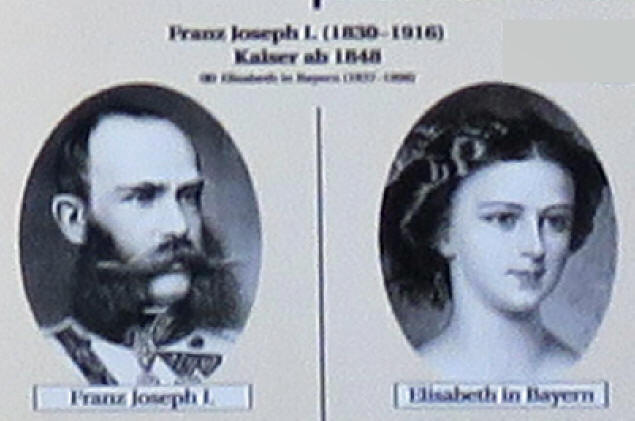
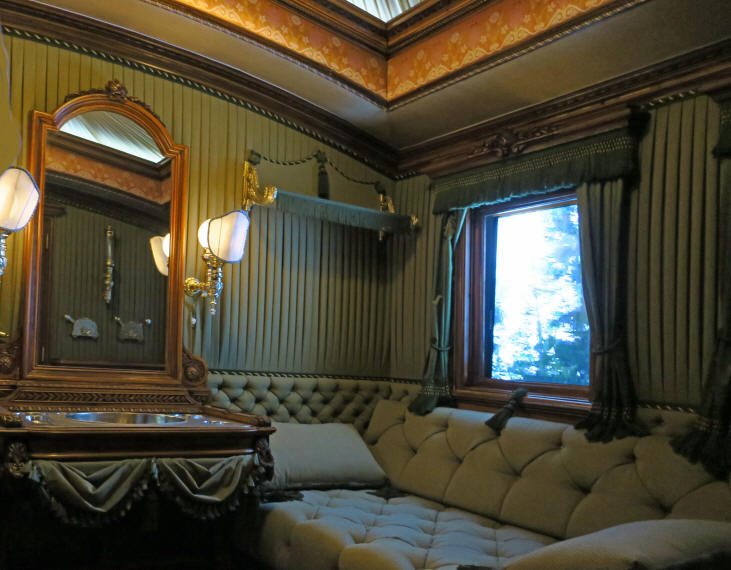
The next room had a large oval portrait of her. She was quite beautiful. The room was full of these pink and white oval boards with descriptions of the events in her life.
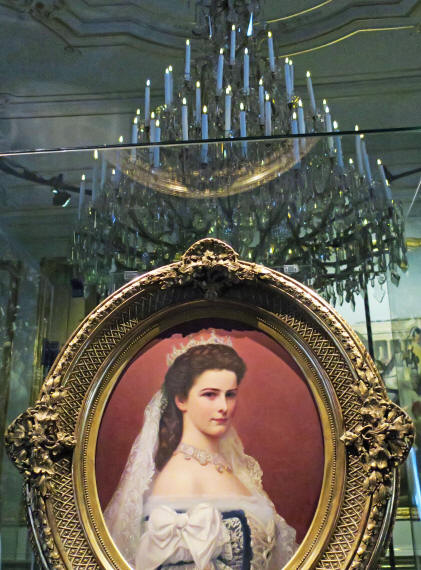
You can see the tops of them above right. I edited the individual photos to include only the English. Note that her name in Hungarian is Erzs�bet, which is the same as my Hungarian grandmother. Sisi was much loved by the Hungarian as well as the Austrians.
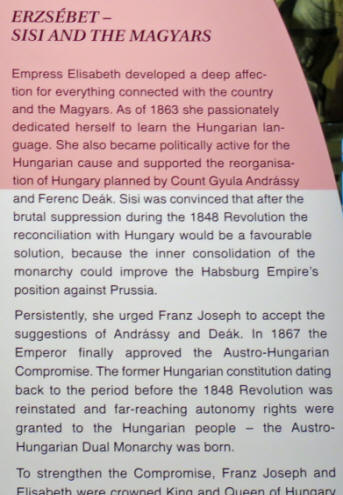
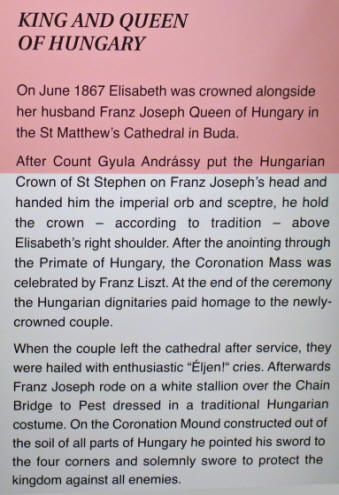
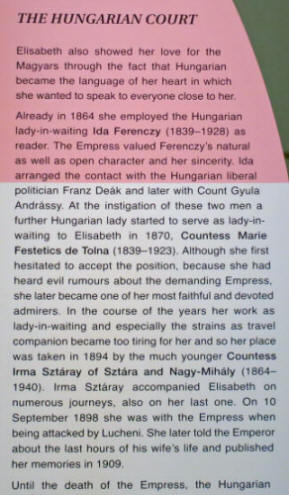
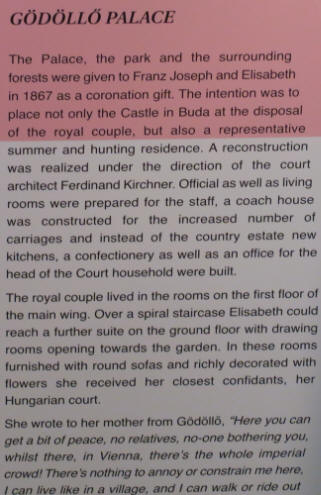
This Sisi display led right into the Imperial Apartments. Having seen so many such rooms in so many palaces across Europe, I somewhat hurried through, attempting to take photos of as many rooms as I could.
THE Imperial Apartments
I first got one of the Audience Chamber (below left) followed by the Conference Room (below right).
Below left is Sisi's office and on the right is the Emperor's study with fireplace.
Below left is the Emperor's Bedroom and on the right is his Large Salon.
Here on the left is a small salon for Emperor Maximilian of Mexico and his Bedroom (right).
Below is Elizabeth's dressing and exercise room.
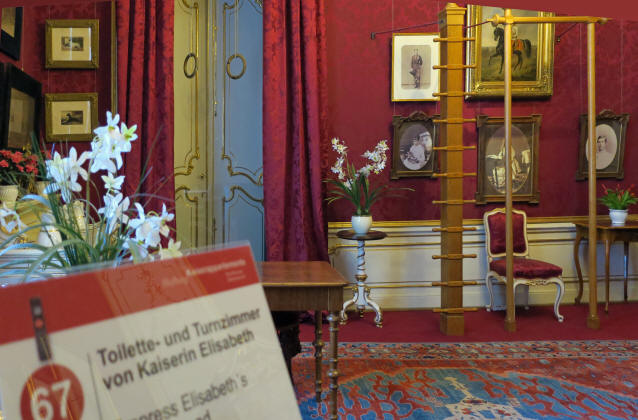
Below are shots of Elizabeth's small salon (being refurbished) and some bathtubs (right).
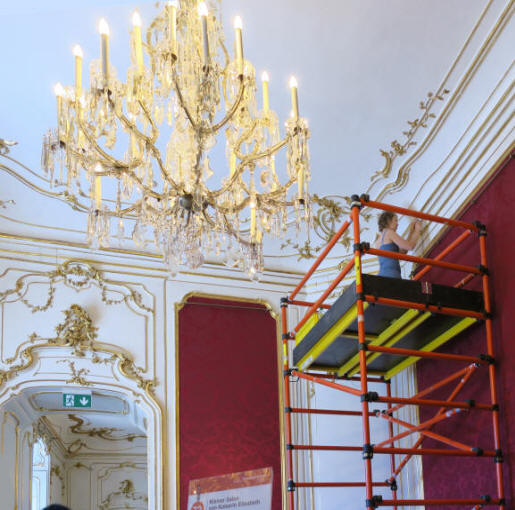
Here are more elegantly decorated rooms.
Below left is a grand dining hall, now also used for special events. There were rooms I didn't get photos of, because of the attendants watching, but with a sigh of relief I finally arrived at the Gift Shop (below right) which means I am done.
I sped through the shop and found the exit door. When I got outside, I
found myself in Ballhausplatz which is a square containing
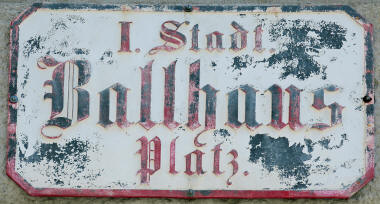 the
building (with the address Ballhausplatz 2) that for over 200 years has been the
official residence of the most senior Austrian Cabinet Minister, the State
Chancellor, today the Chancellor of Austria (or Prime Minister). As a
result, Ballhausplatz is often used as shorthand for the Austrian Federal
Chancellery.
Ferdinand I, HRE erected a tennis house here, he called it the Ballhaus
(ball house). Later the building was used for the Imperial Court
Construction Office (Hofbauamt). At the end of the 18th century, the
Ballhaus was ripped down. All I saw here was this monument fountain (below
right).
the
building (with the address Ballhausplatz 2) that for over 200 years has been the
official residence of the most senior Austrian Cabinet Minister, the State
Chancellor, today the Chancellor of Austria (or Prime Minister). As a
result, Ballhausplatz is often used as shorthand for the Austrian Federal
Chancellery.
Ferdinand I, HRE erected a tennis house here, he called it the Ballhaus
(ball house). Later the building was used for the Imperial Court
Construction Office (Hofbauamt). At the end of the 18th century, the
Ballhaus was ripped down. All I saw here was this monument fountain (below
right).
Then I turned around and there were all these guards and officials around this doorway ...
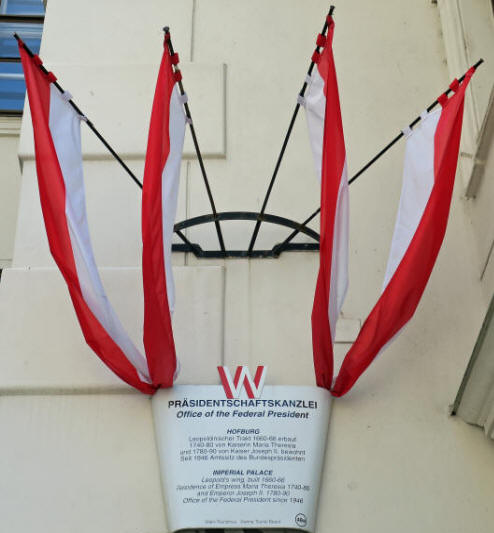
... and I realized I was at the entrance to the President's official office in the Leopold Wing. It was previously used by Maria Theresa.
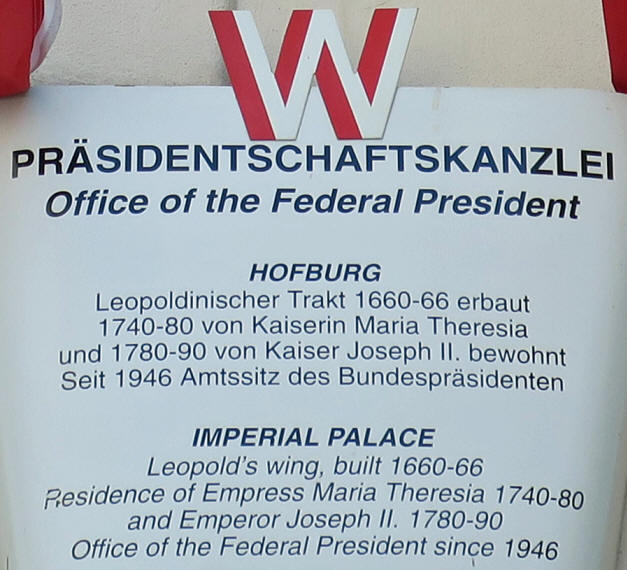
I walked a little farther and came across another exit (below) with more Hercules statues.
These were The Seventh Labor, the Cretan Bull (left) and The First Labor, the Nemean lion (right).
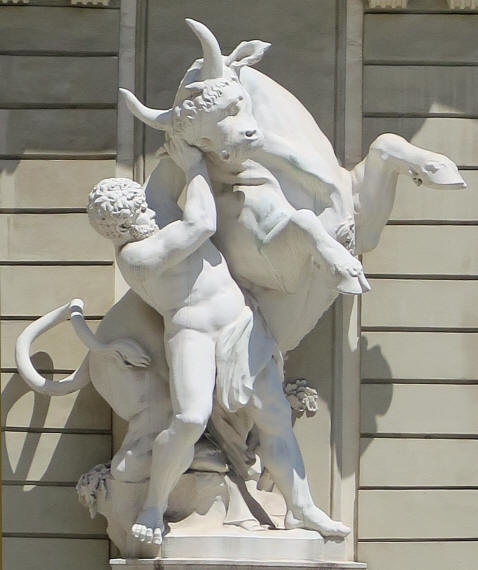
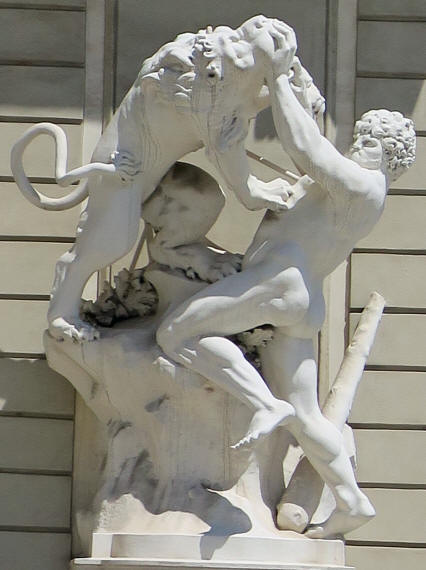
And then another gate with more of Hercules.
This time I could not figure out which Labors these were; just him fighting another man.
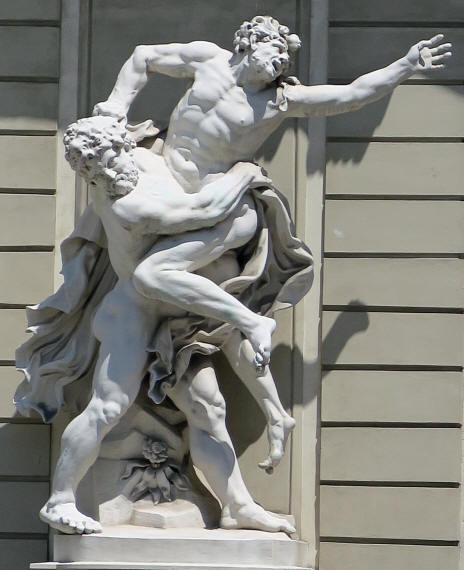
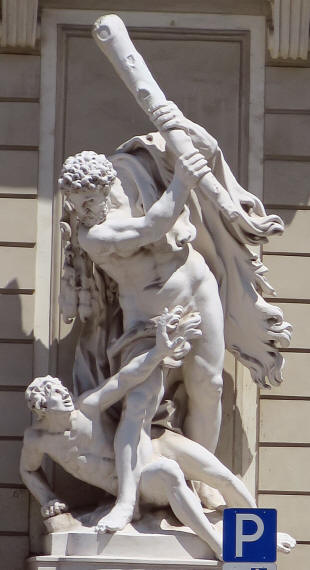
This is the beautifully decorated top of the building.

I then came across the Swiss Gate and got a shot of it from both sides; entry (left), exit (right).
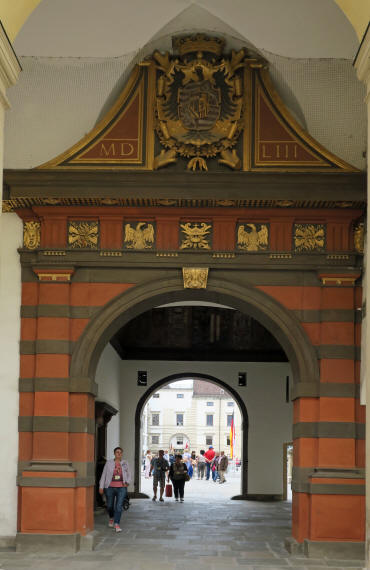
The marble sign near the gate is hard to read and in German (below left); it says "The Swiss Gate (Schweizerhof) is enclosed by the oldest laid castle building in 1270, which was long ago enriched by four long corner tower reinforcements under Emperor Frederick III (1417-1440) and by the installation of the Gothic Castle Chapel (Burgerkapelle) under Emperor Ferdinand I (1552-3) in Renaissance style. The name was changed to "Swiss Gate" because of the Swiss Guard, who guarded the old castle at the time of Empress Maria Theresa."
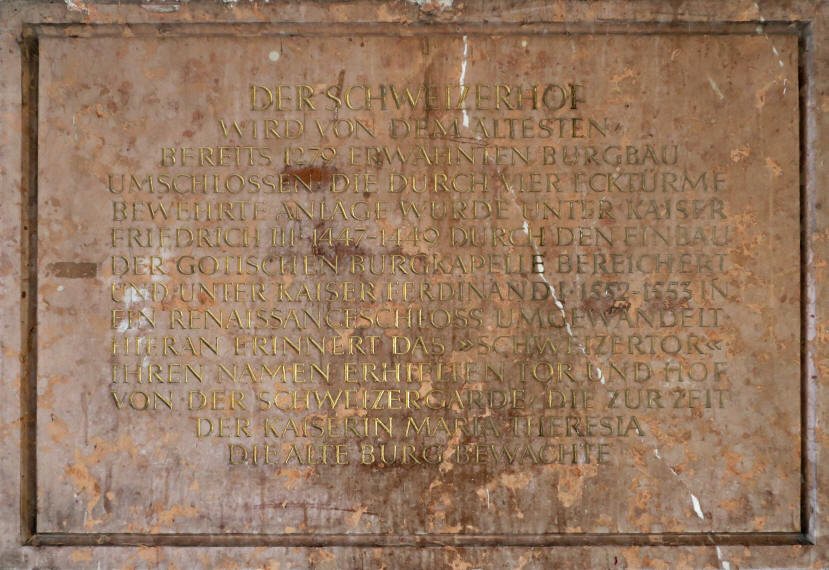
Below left is the tourist sign (above right) for the nearby Chapel and right is it's Mass schedule.
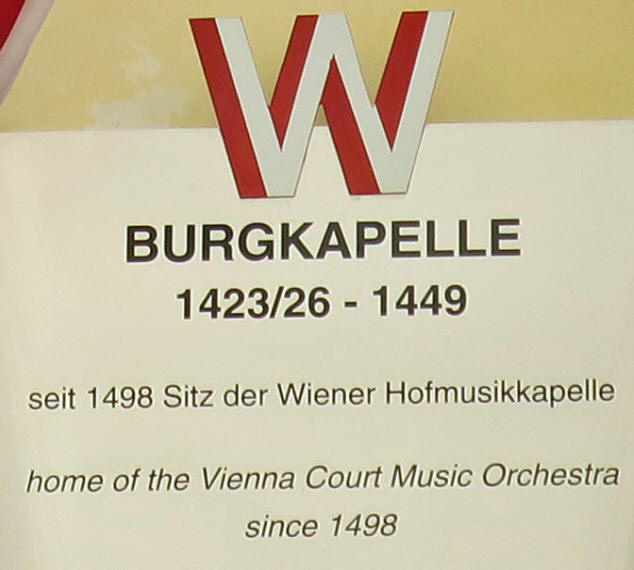
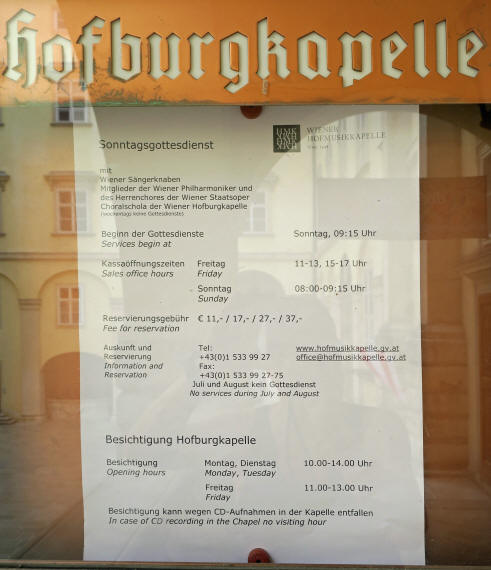
When you walk through the Swiss Gate and look up, the ceiling is elaborately decorated.
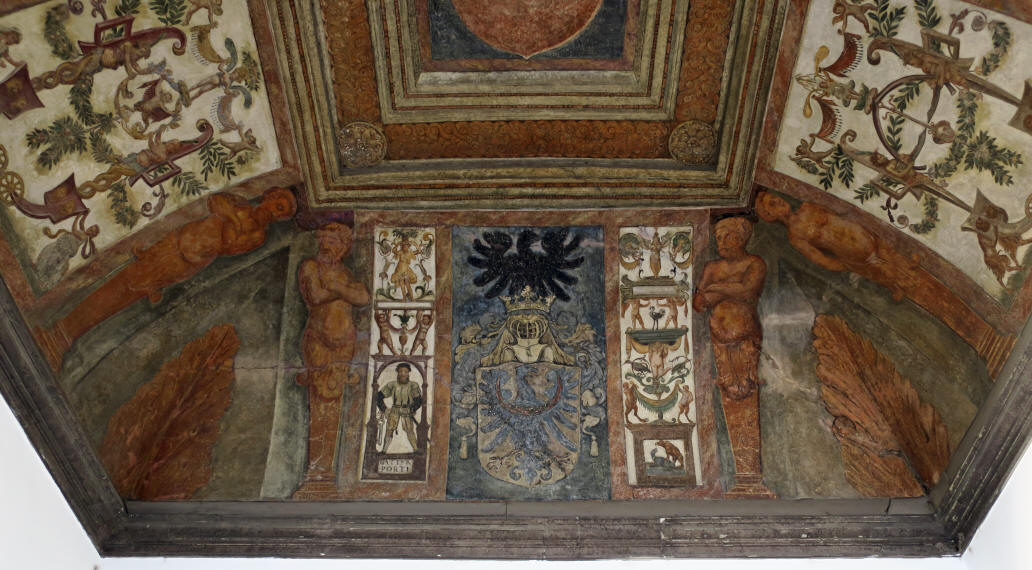
It's only 1:23 PM now, so I have time to see some more. The next place I will visit is the Kaiserliche Schatzkammer (Imperial Treasury). They have this long sign for it on the fence and I kept waiting for this young man to move out of the picture but finally had to give up and take it anyway.
The IMPERIAL Treasury (kaiserliche SCHATZKAMMER)
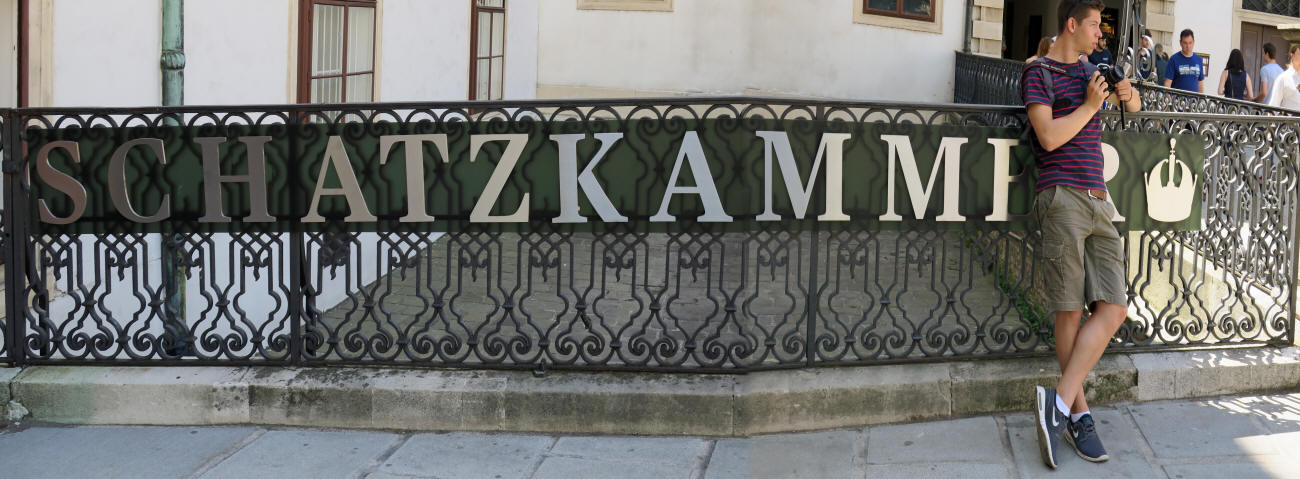

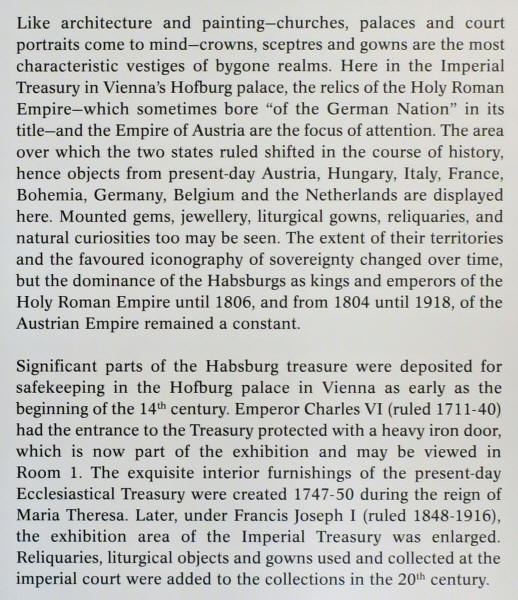
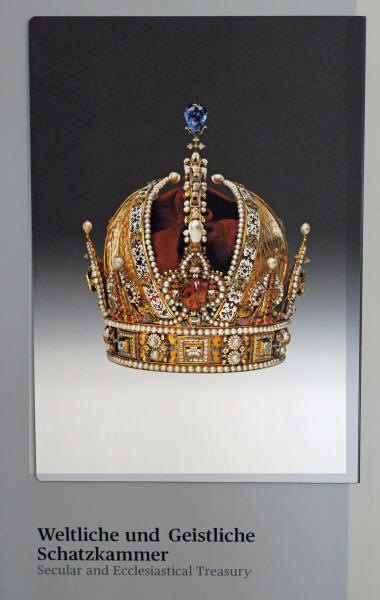
I enter and pay the �20 ($23.68) fee. The first area I come across displays of ancient priest vestments (albs) from the 1400s.
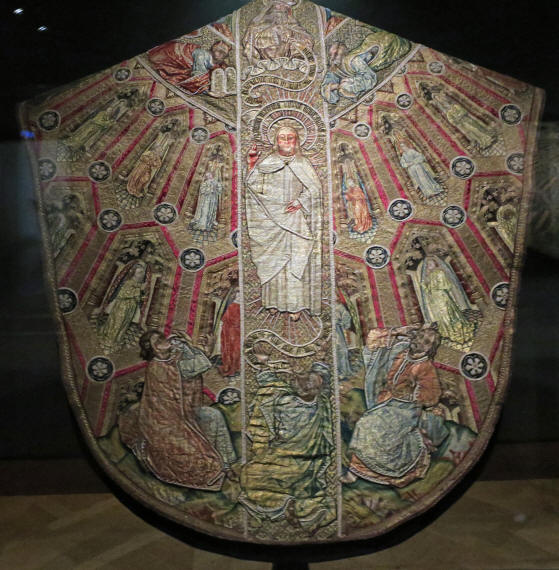
Some of them are extremely detailed and well preserved.
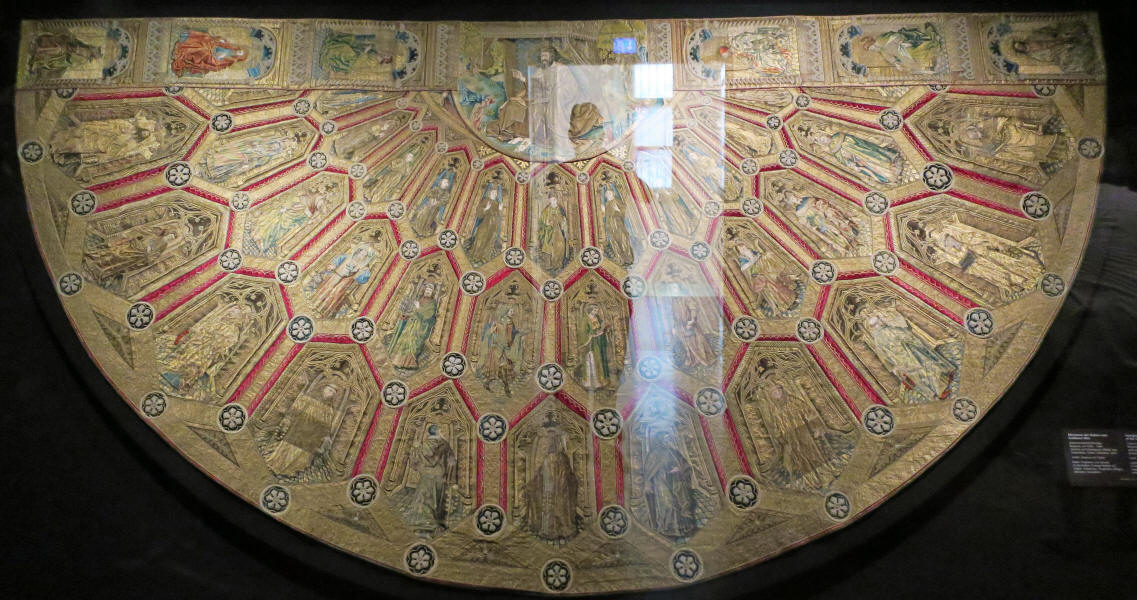
Then there were these three "buttons" (or morses) for liturgical vestments of the Order of the Golden Fleece from the Netherlands (1500).

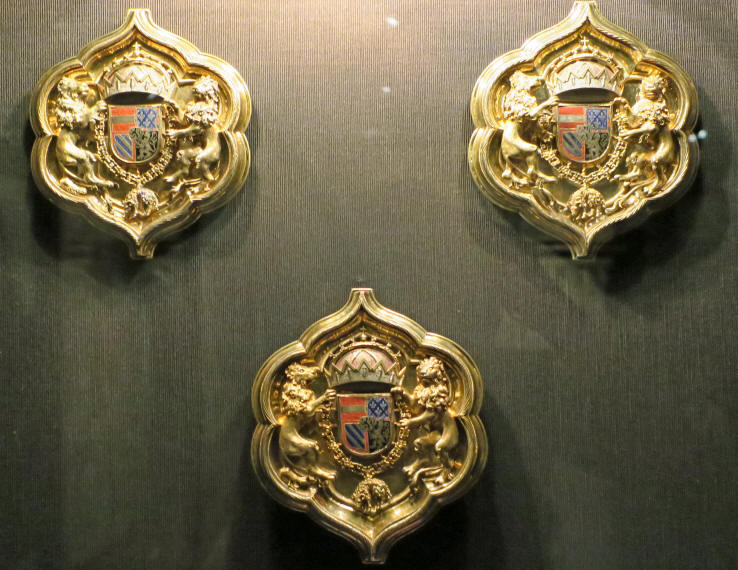
Here is a beautiful, very ornate necklace piece.
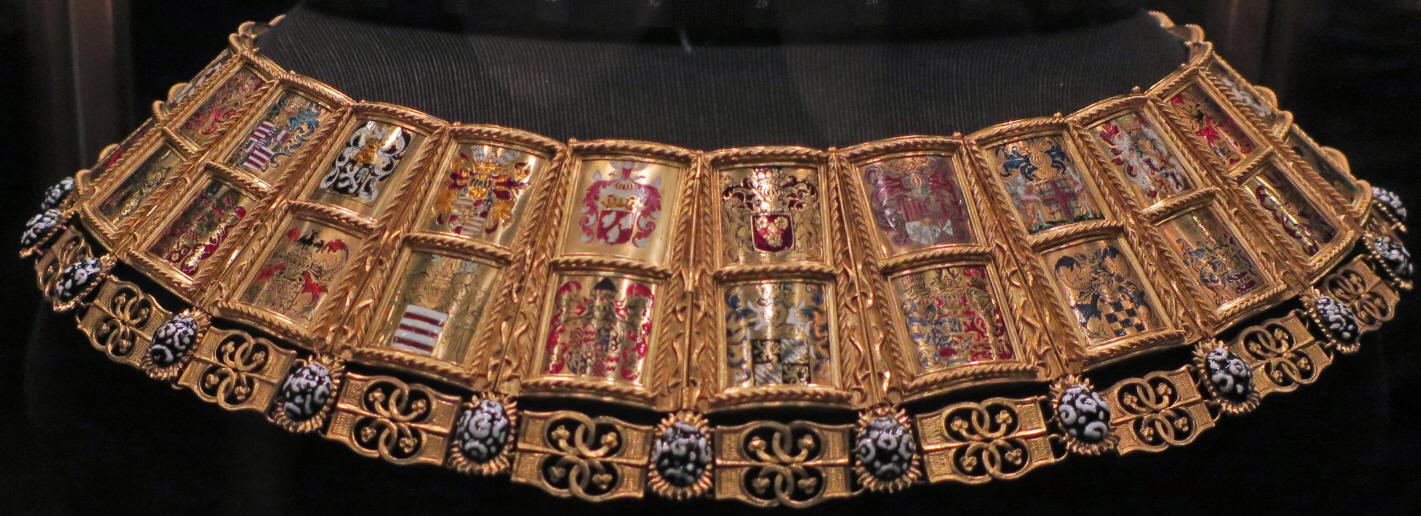
This necklace also seems to be "Golden Fleece" oriented (left), elegant robes (center) and a Burgundian Court Goblet (1453/67) made of rock-crystal, gold, enamel, pearls, diamonds and rubies.
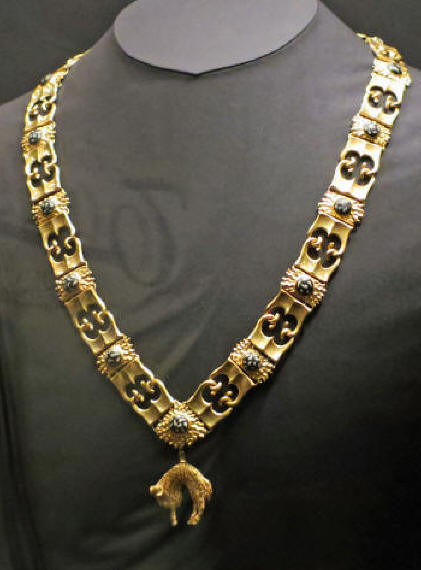
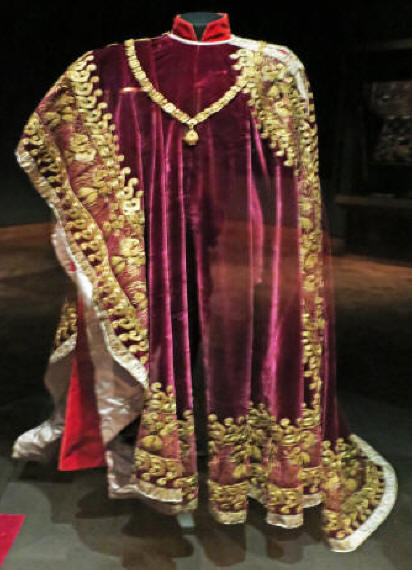
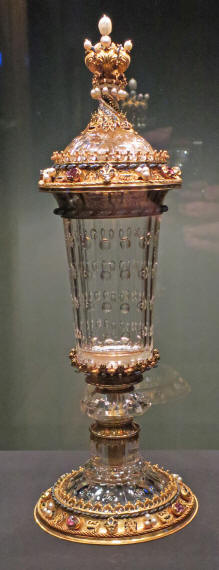
This case (below) displays the Ceremonial sword of Maximilian I (1496) (large one) and the Burgundian Ainkh�rn (unicorn horn) sword (1425-50) (at the bottom).
The cabinet below right displays: a reliquary containing a piece of the Last Supper tablecloth (1518), one containing a piece of Christ's crucifixion loincloth (1518), one containing a tooth of John the Baptist (1350), one of a fragment of John the Evangelist's robe (1368) and finally, one holding a piece of wood from Christ's manger (1368). All a little hard to believe, I would say.
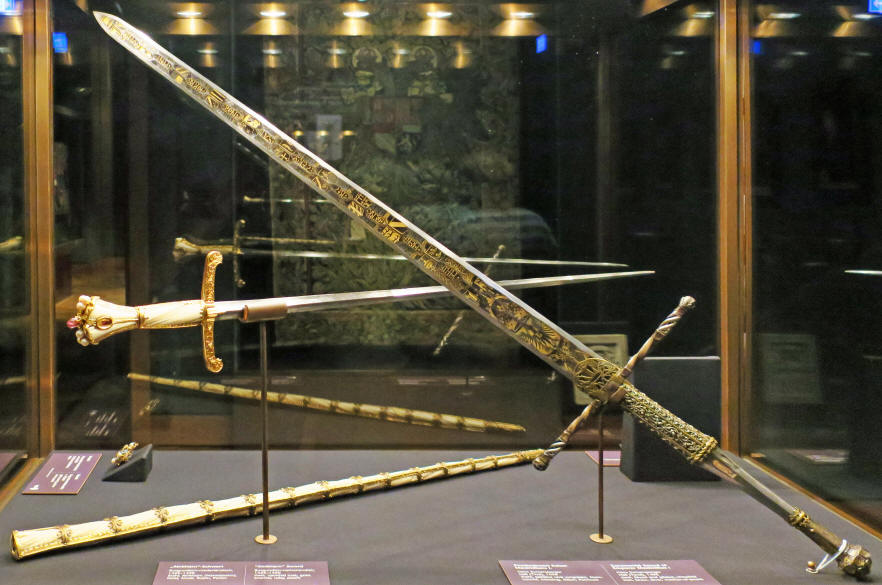
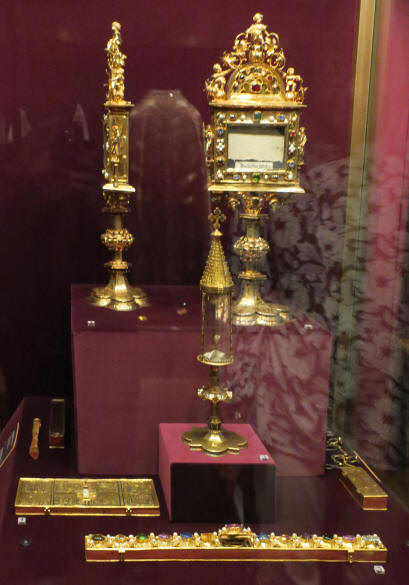

Below is an array of various garments.
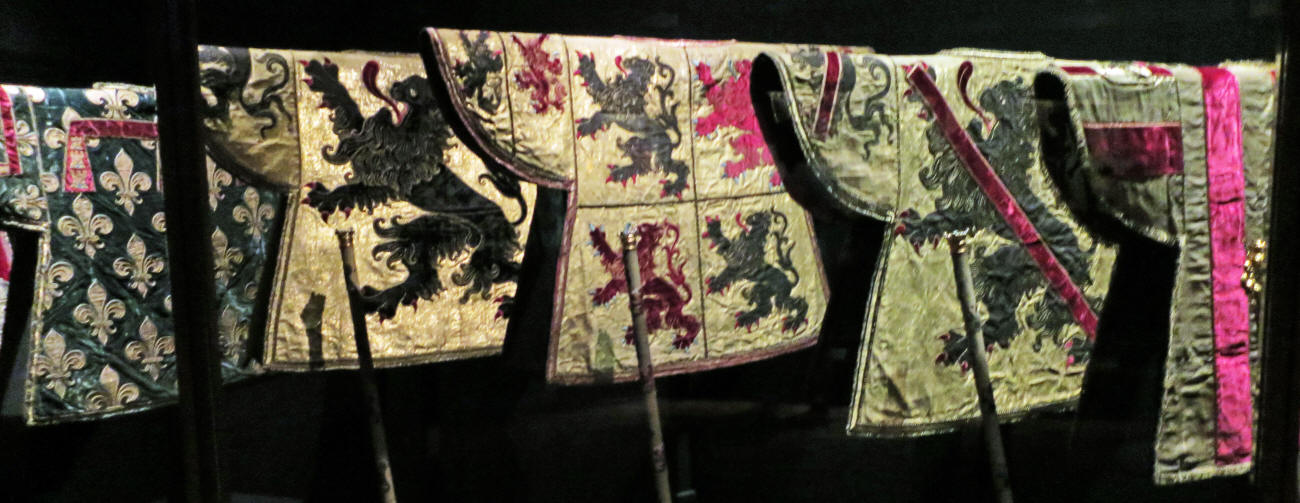
Below left is a German idealized oil portrait of Emperor Charlemagne (747-814) which is a copy after Albrecht D�rer (1471-1528), circa 1600. Below right is a similar one of Emperor Sigismund (1361-1437).
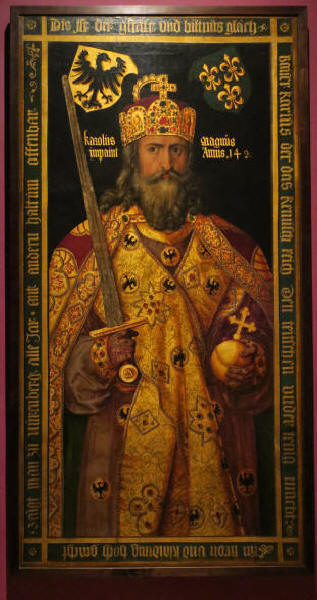
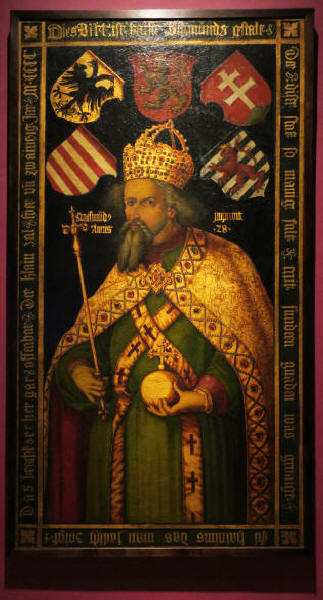
The display (below left) shows the "Gospels of the Court of Charlemagne" circa 800 (upper left) and blown up (below right). The burse of St. Stephen (Carolingian, 800-833) is to the right of it.
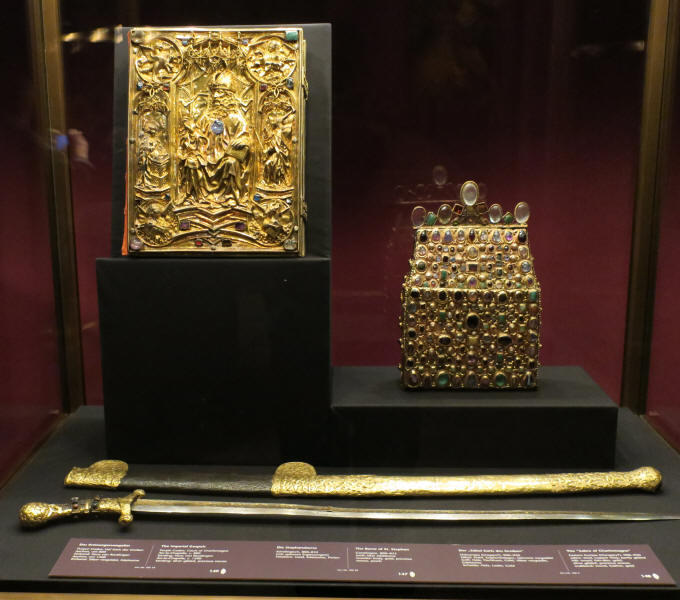
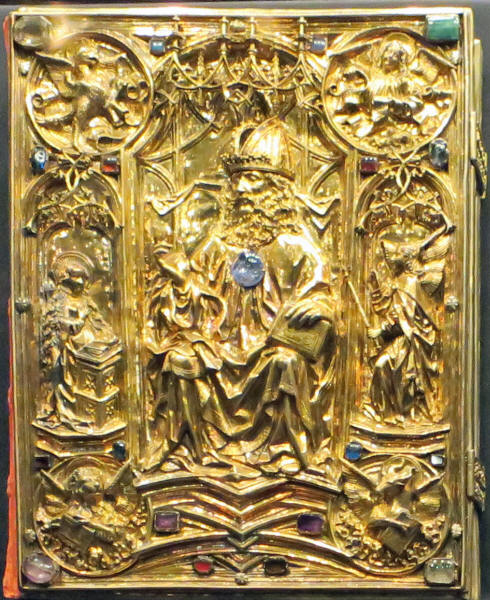
Below them (above) is the "Saber of Charlemagne" with its scabbard (900-50). Below left is a blow up of St. Stephan's burse to see the detail of the gems and below right is the Imperial Crown (Western German, 960-80). These are more believable.
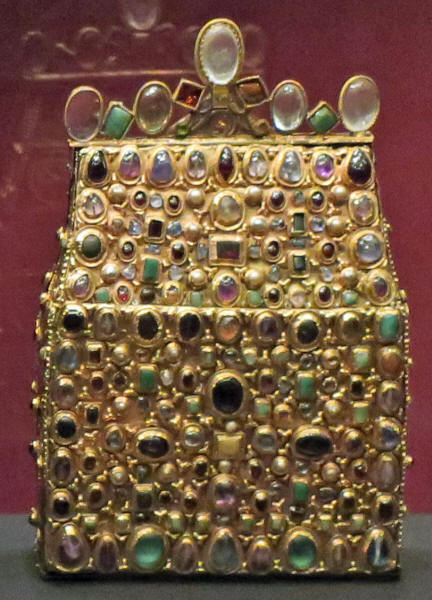
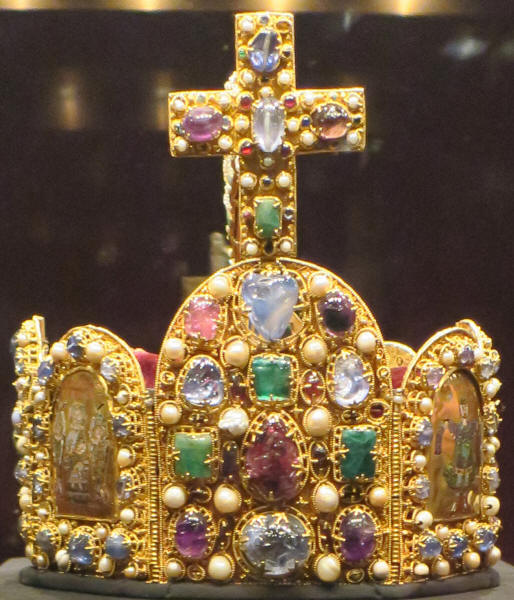
This is a quite ornate vestment sprawled out.
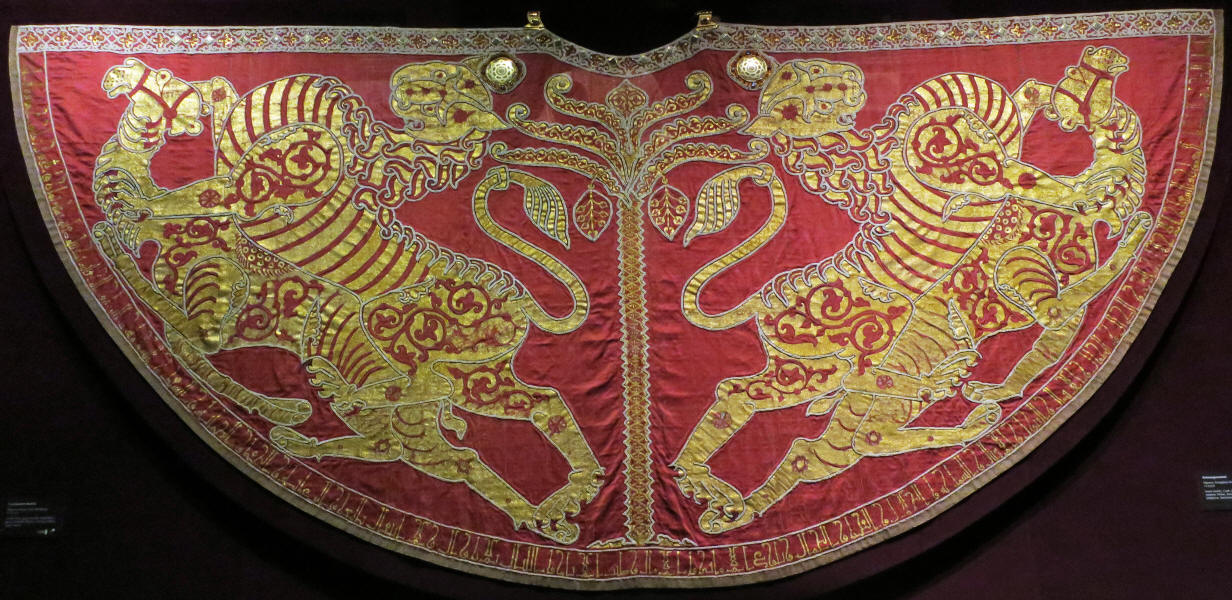
Below is displayed the Imperial sword of St. Mauritius (below right, the Church's first black saint, 1084-1218) with its scabbard (below it), an Imperial Orb (Cologne, 1200) (lower left), a silver Aspergillum (German, 1300-50) which is a liturgical implement used to sprinkle holy water (center) right next to a German Scepter (1300), and a ceremonial sword (Palermo, 1220/Prague, 1375).
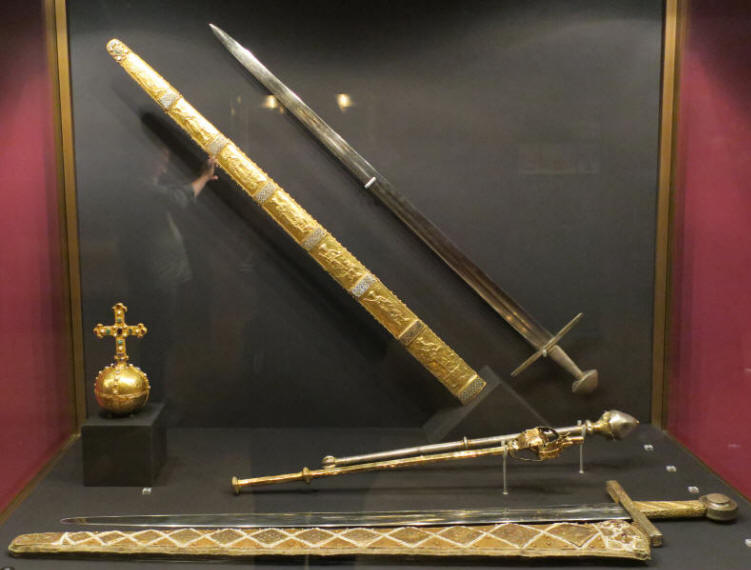
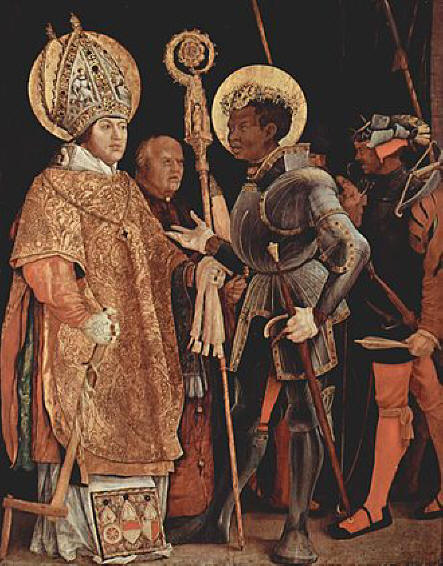
The next section consisted of displays of the Coronation robes of the Holy Roman Empire from the workshops in Palermo, Italy.
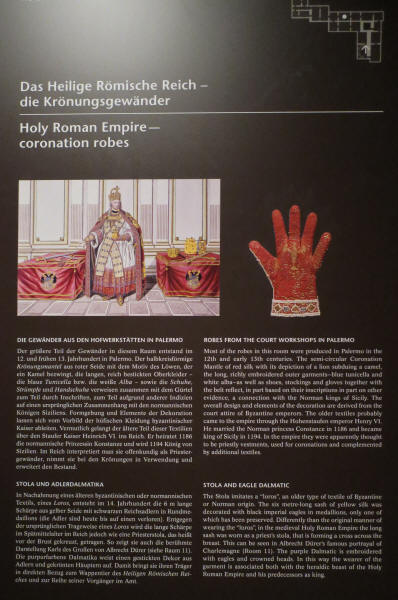
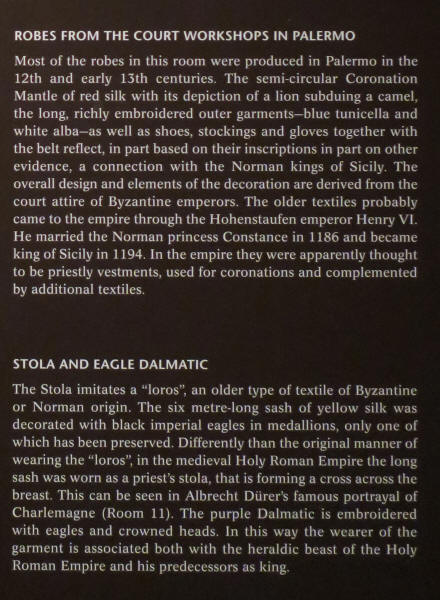
Here is a stunning coronation vestment of the Kingdom of Lombardy-Venetia (Vienna, 1838) made of gold and ermine near a sword of investiture (Vienna, 1837).
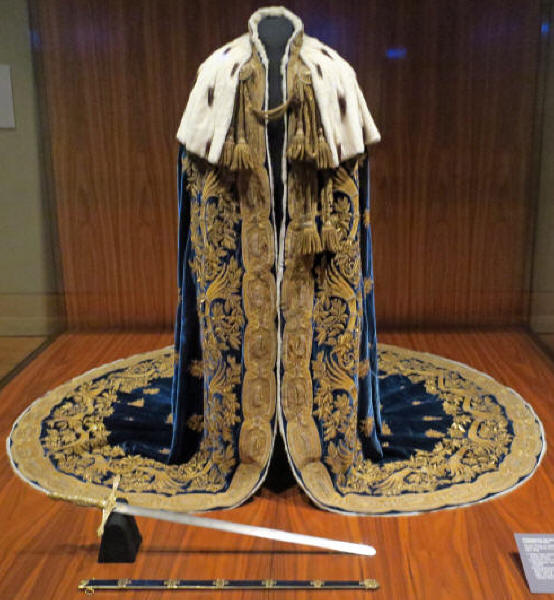
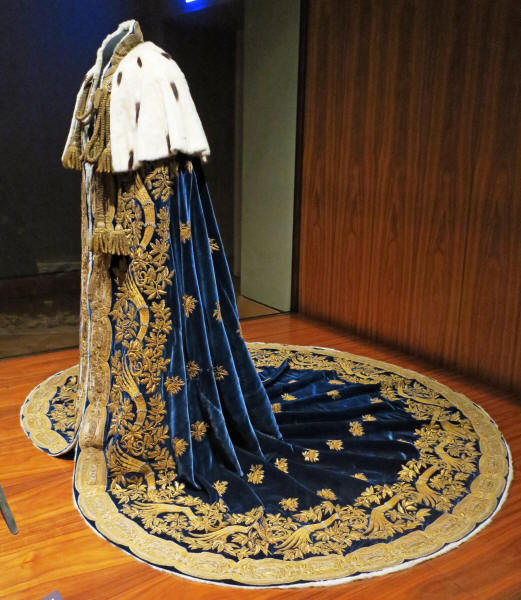
Then there is an area about the French Empire, Napoleon and the House of Hapsburg.
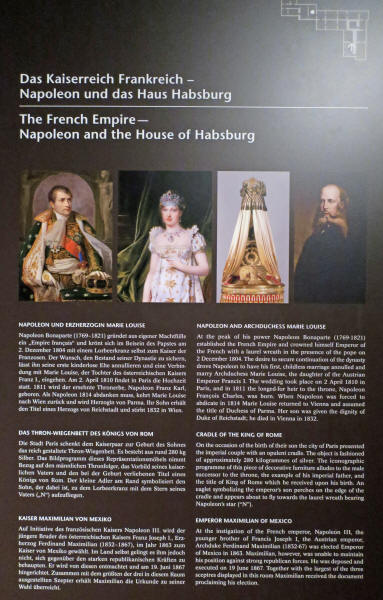
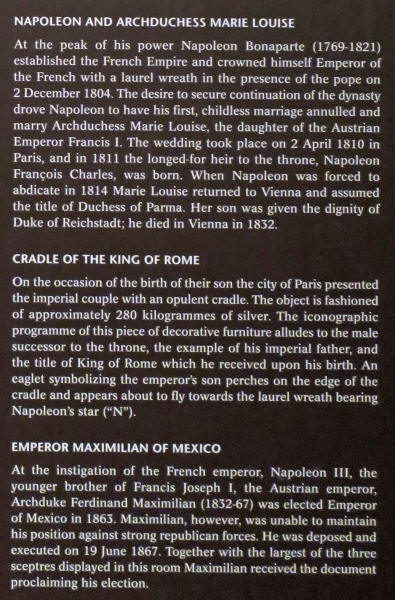
They have an oil painting of Napoleon (1769-1821) as King of Italy (Milan, 1805) by Appiani and a cradle for Napoleon's son (the "King of Rome") made of 560 pounds of silver (Paris, 1811) given to him as a gift by the people of Paris.
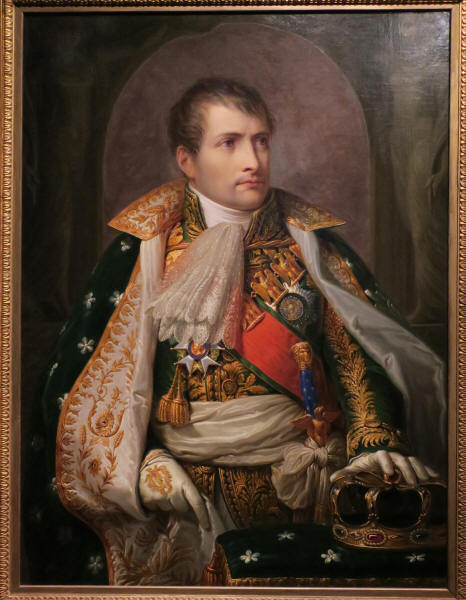
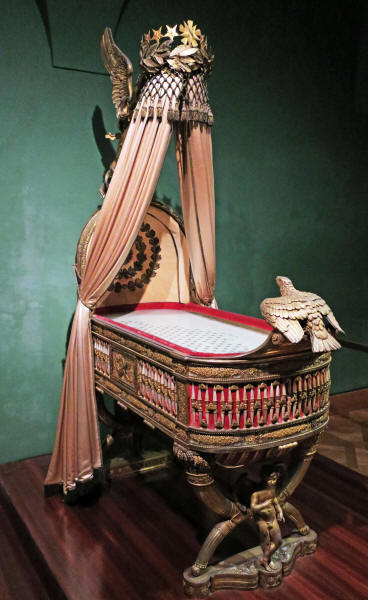
This display holds pieces commemorating Emperor Maximilian of Mexico: 1) Chain of Maximilian I Order of the Eagle (top), 2) Chain of the Order of Our Lady of Guadalupe (below it), 3) scepter of Maximilian 1863 (center), 4) & 5) scepters (Mexico, 1863) and 6) the cane of Emperor Maximilian I (Mexico, 1863).
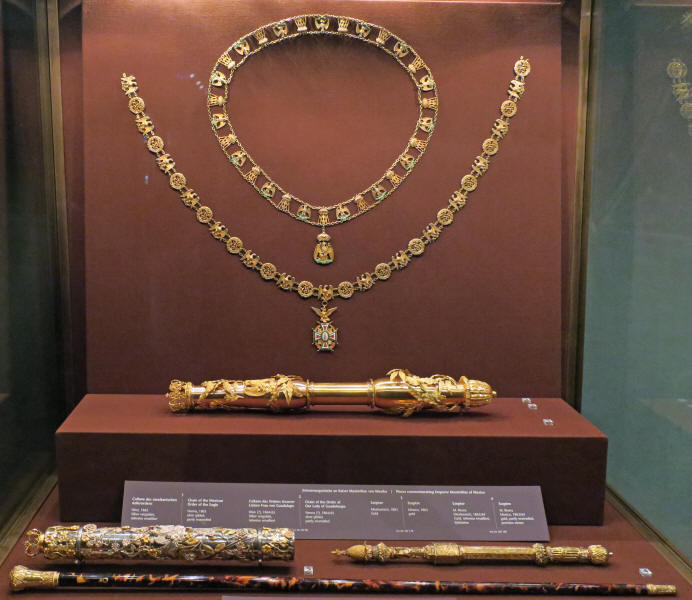


Below is an ornate gold ewer and basin used for Imperial baptisms (Spanish, 1571) next to a small ewer also used for baptisms (Prague, 1606).
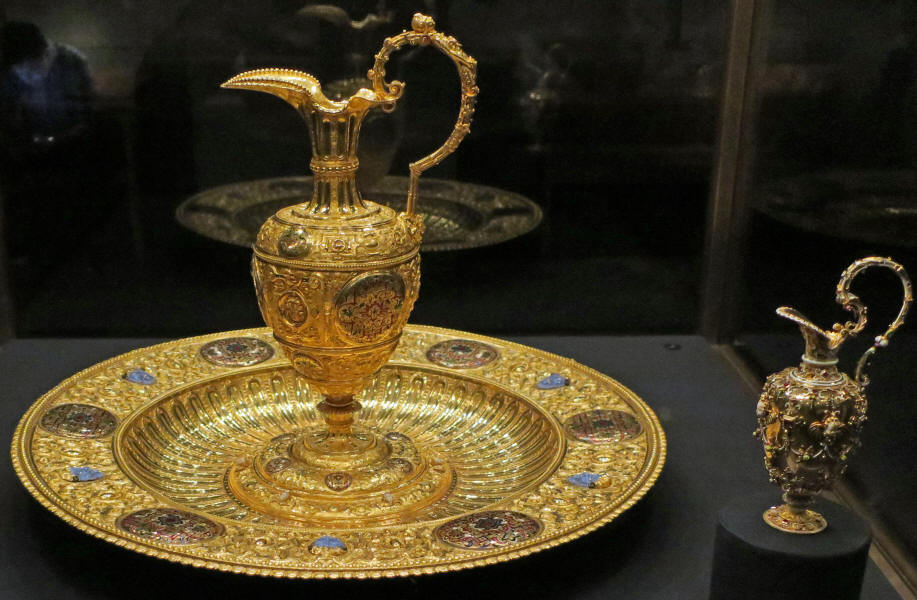

Below left is an amber altar from 1640 and on the right is a reproduction (Augsburg, 1875) of the column of the Virgin Mary in Am Hof, Vienna.
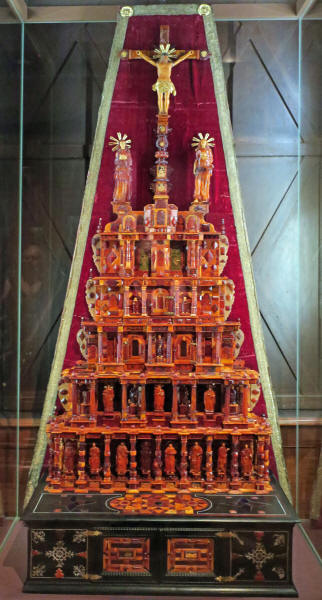
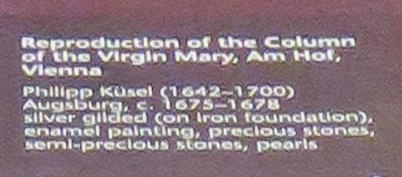
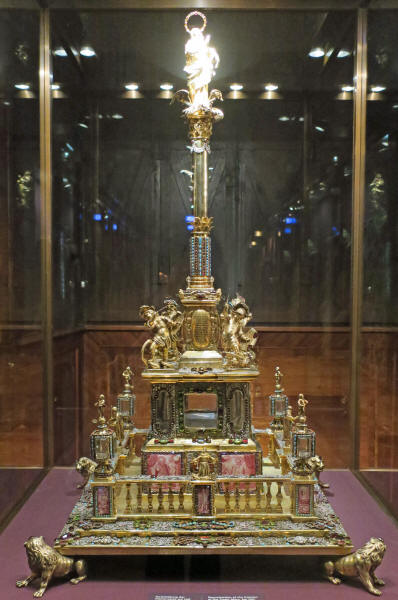
Then there is the "Ainkh�rn" (unicorn horn) narwhal tusk (1500-50) from two different angles and the Golden Rose (Rome, 1818).
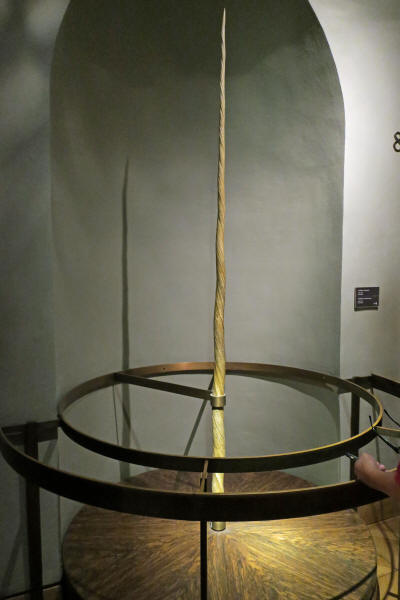
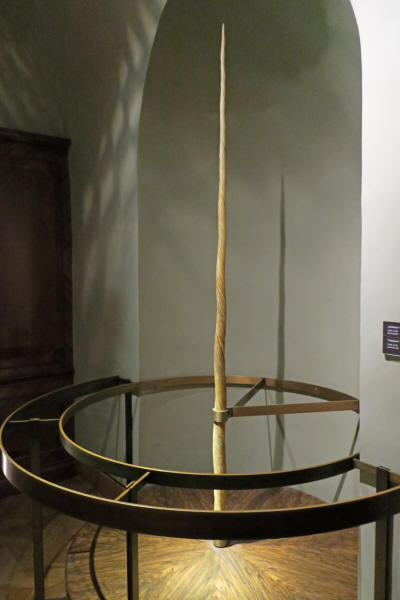
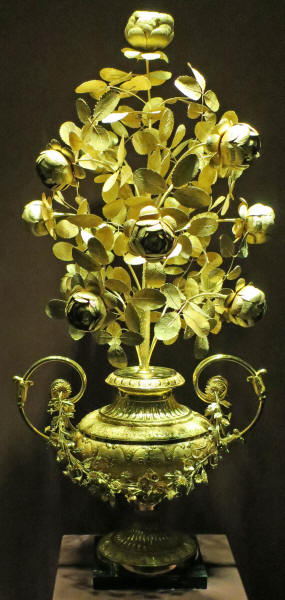
Below is the Crown of Stephan Bocskay (or Bocskai Istv�n) (1557-1606) given to him by the Ottoman Grand Vizier, Lala Mehmed Pasha (Turkish, 1605) (left) and it's case (right).
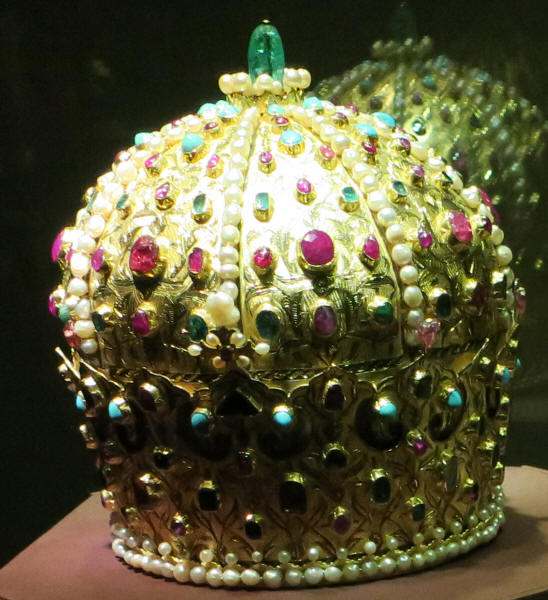
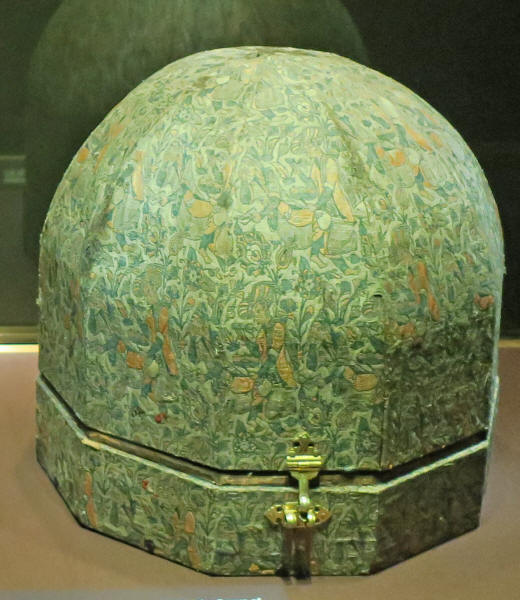
Bocskay (below center) was a 16th Century Calvinist revolutionary in Hungary, who ruled for a time. He is honored with a statue on the Reformation Wall in Geneva, Switzerland (below left). Below right is a stock photo of the crown.
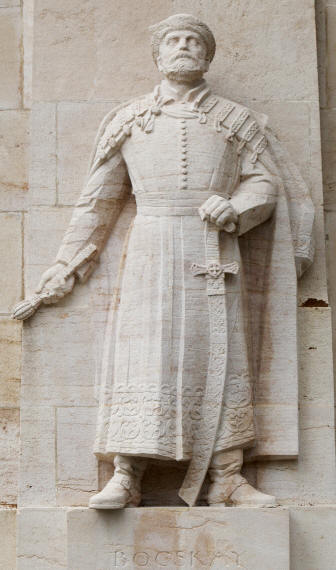
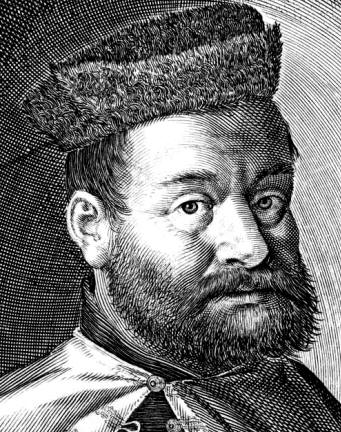
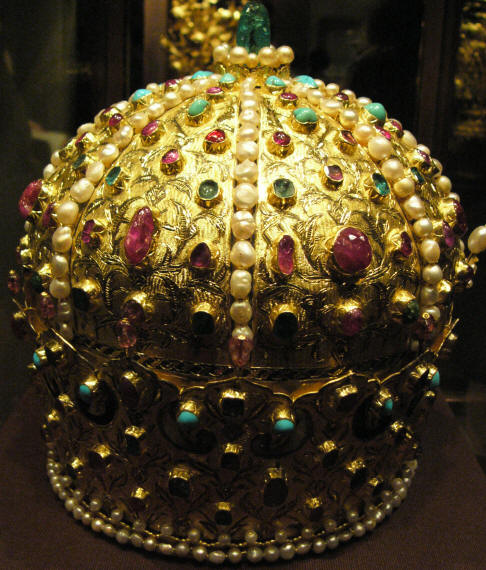
There are displays of medals, medallions and other ornate statues.
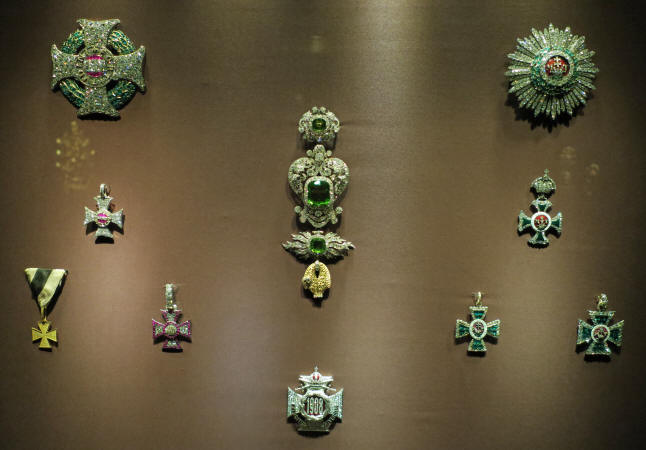
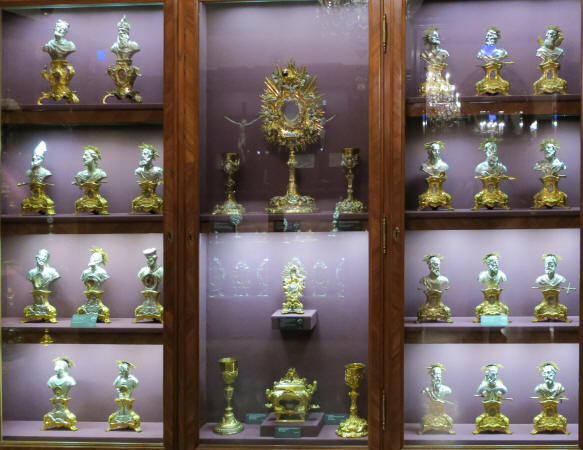
Then there is this display on some background on the Holy Roman Empire and ...
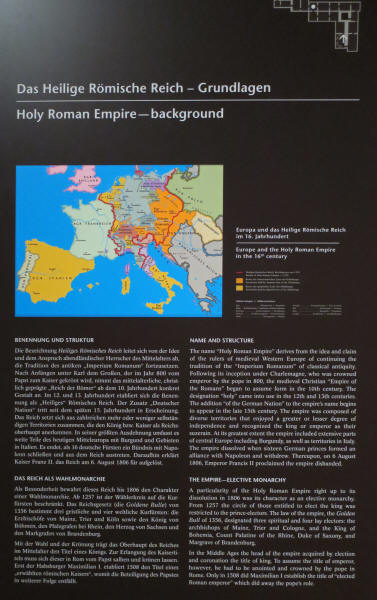
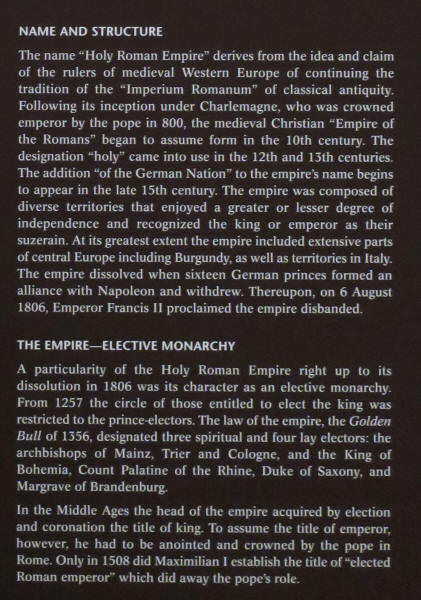
... and the history of the Imperial regalia (Room 10).
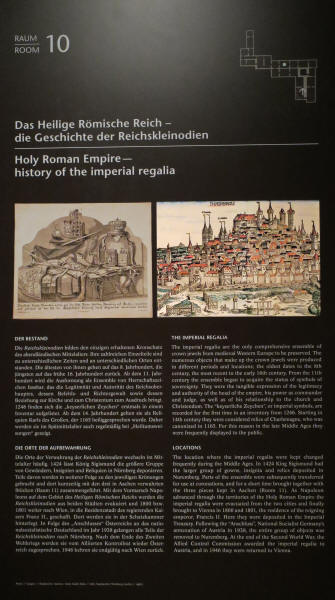
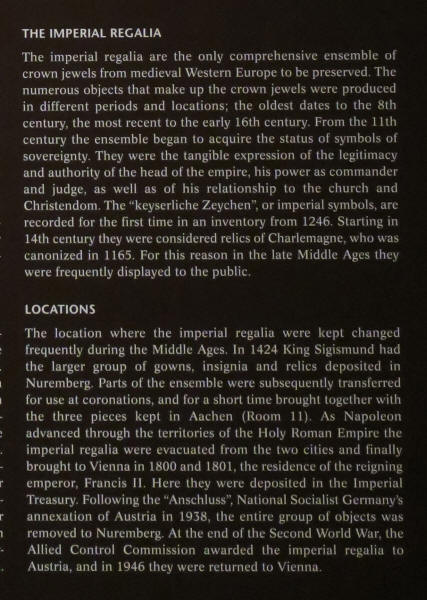
Then another on the the Burgundian heritage and Burgundian court art treasures (Room 14).
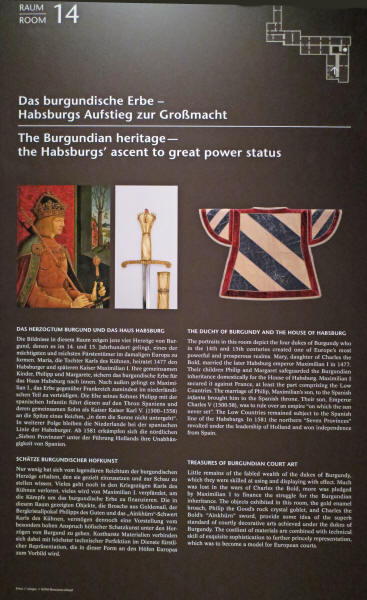
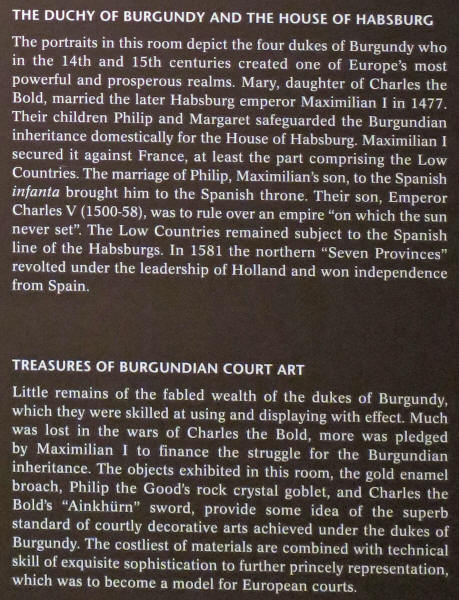
They have displays of old paintings: Emperor Maximilian I (1459-1519) (left); King Phillip I the Fair (1478-1506) or Emperor Ferdinand I (1503-1564) (center) and Mary, Duchess of Burgundy (1457-82) (right).
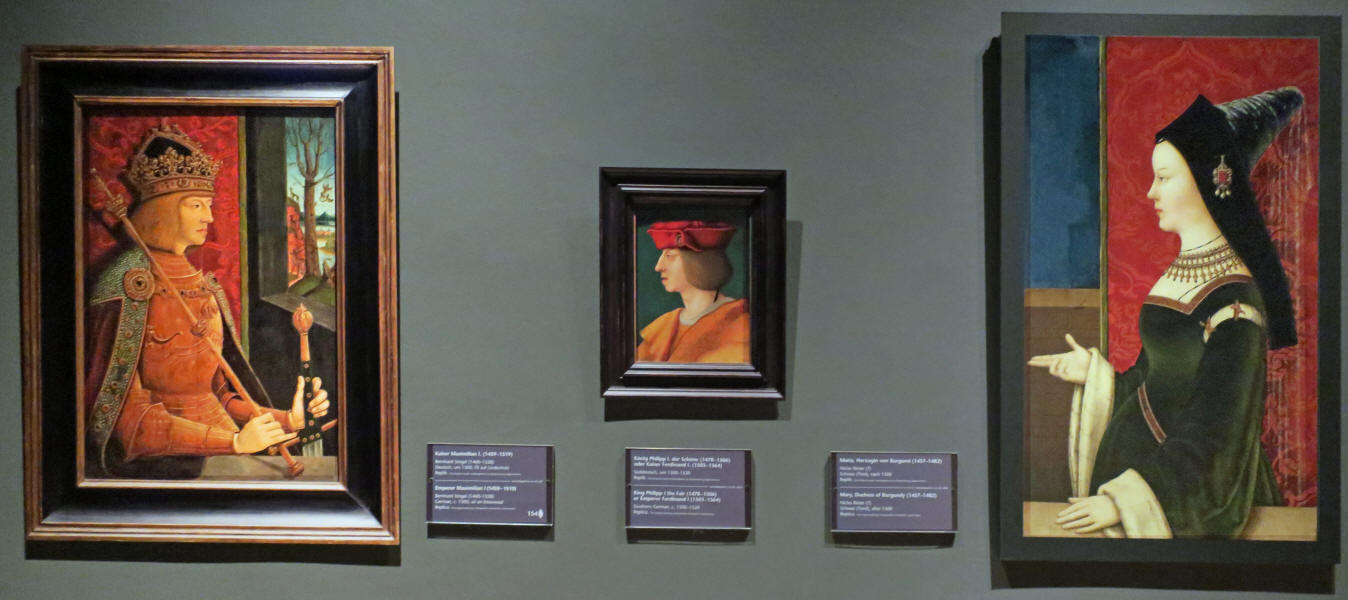
Room 16 is about historical liturgical vestments of the Order of the Golden Fleece.
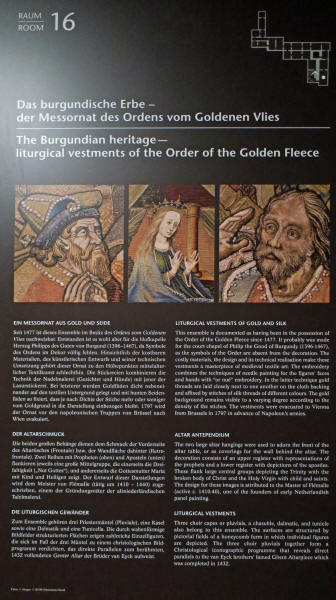
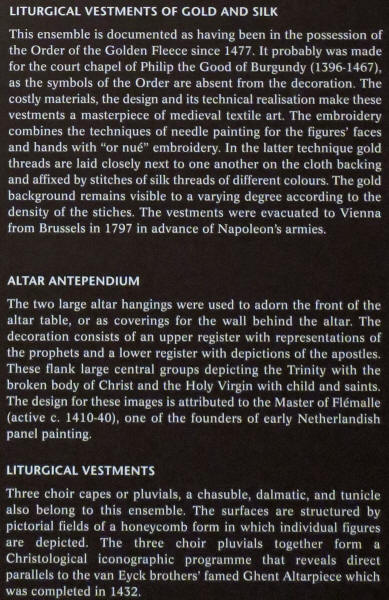
Below are two beautiful examples.
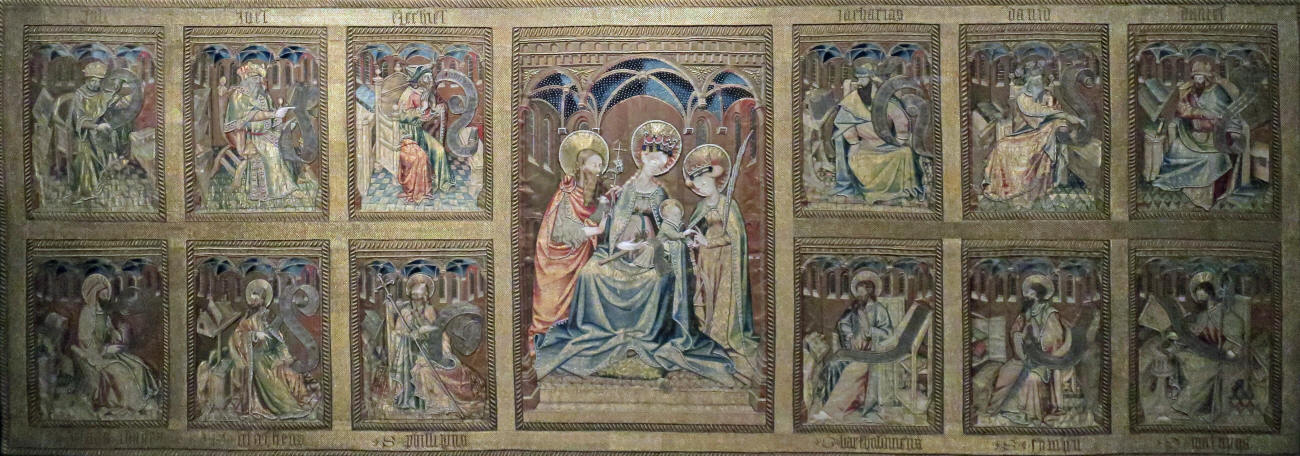
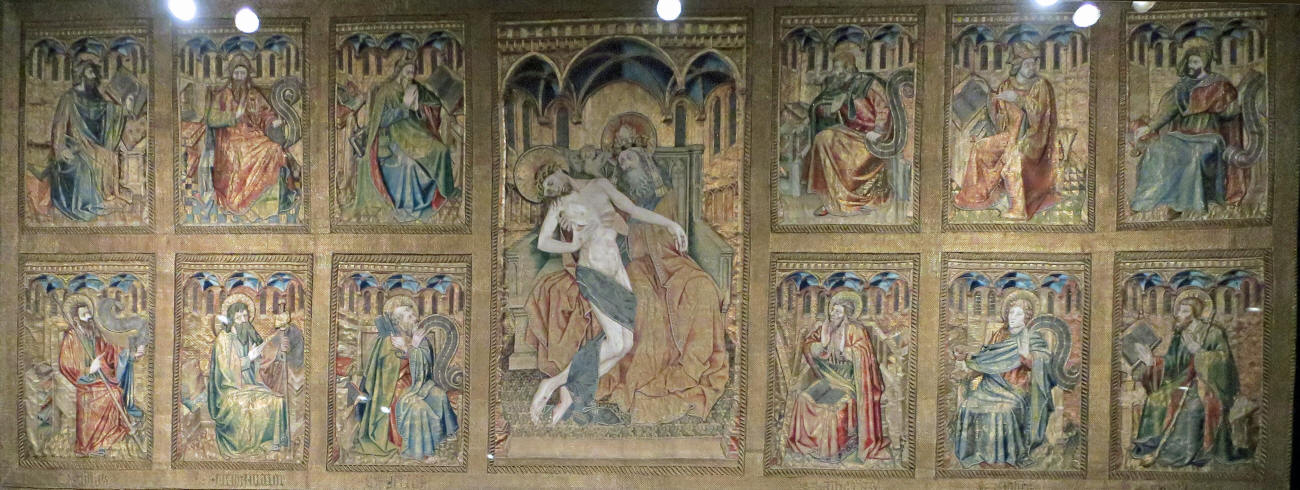
Here is an example of how these display rooms go on and on (see through doorway).
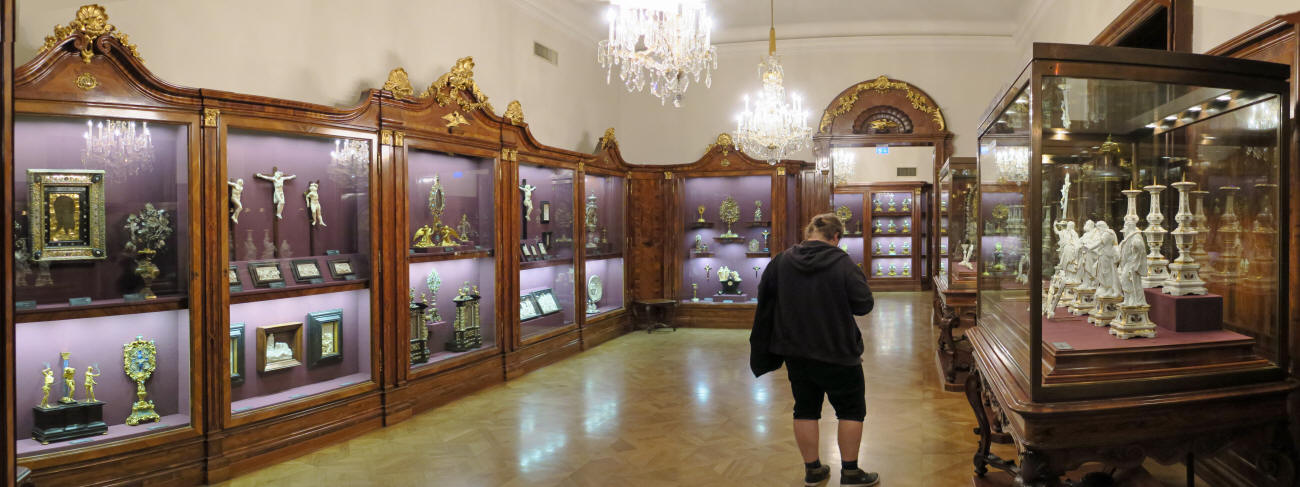
Then there were these paintings from 1500 of four Dukes of Burgundy (L-R): Phillip the Bold, (1342-1404), John the Fearless (1371-1419, Phillip the Good (1396-1467) and Charles the Bold (1433-77).
They have these poster displaying the various objects in the museum based on the age of their origins, from 800 to 1918.
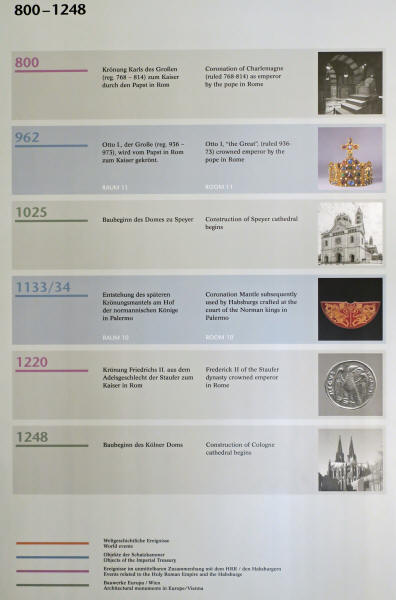
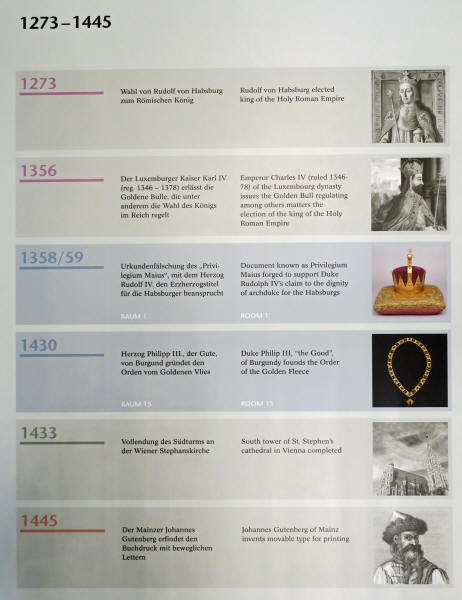
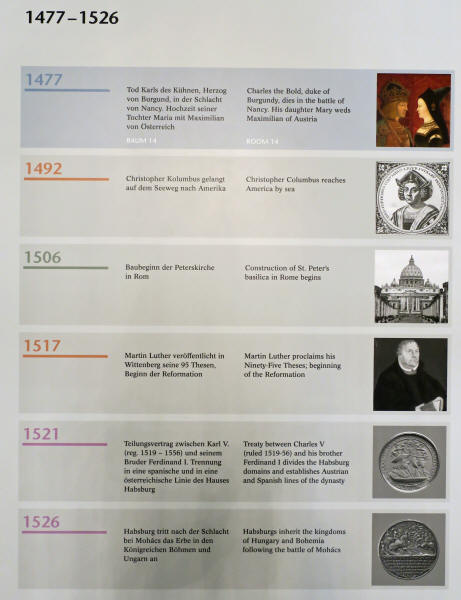
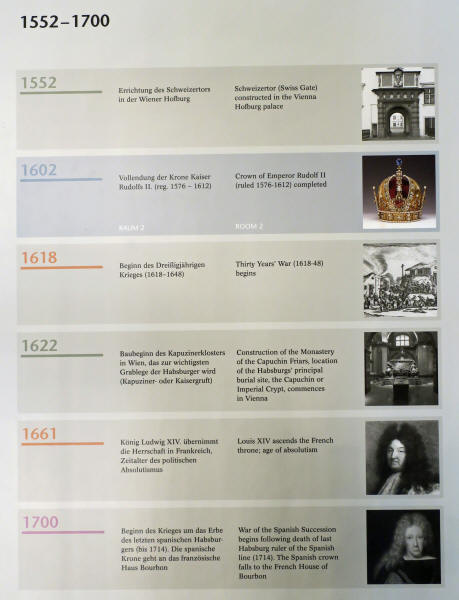
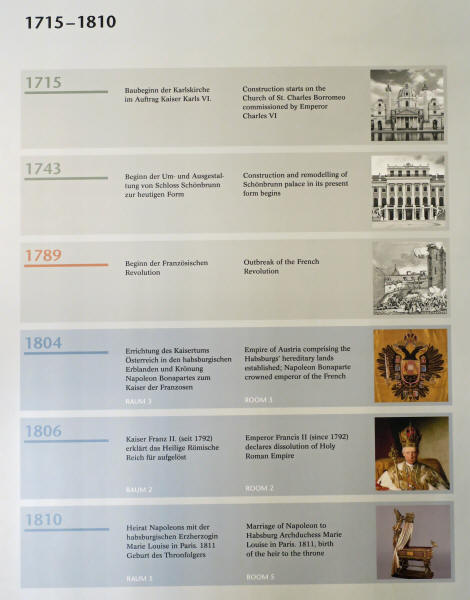
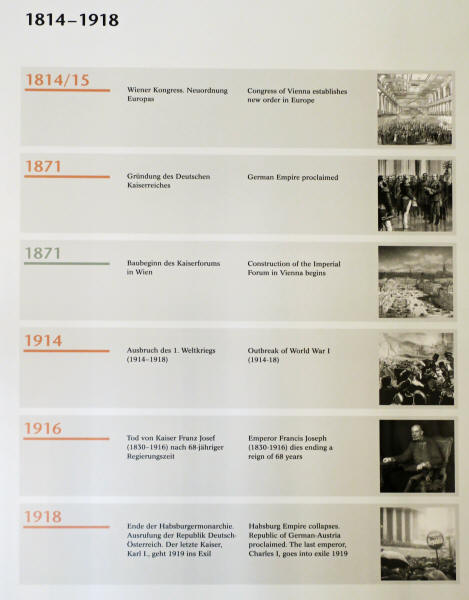
We start with this large display showing 1) "Dog-collar", insignia of the Grand Master of the hunt (Vienna, 1838) (left), 2) shield of the Archduchy of below the River Enns (Vienna, 1835) (above), 3) Austrian Archducal coronet (crown) of Joseph II (Vienna, 1764) (center on pillow), ...
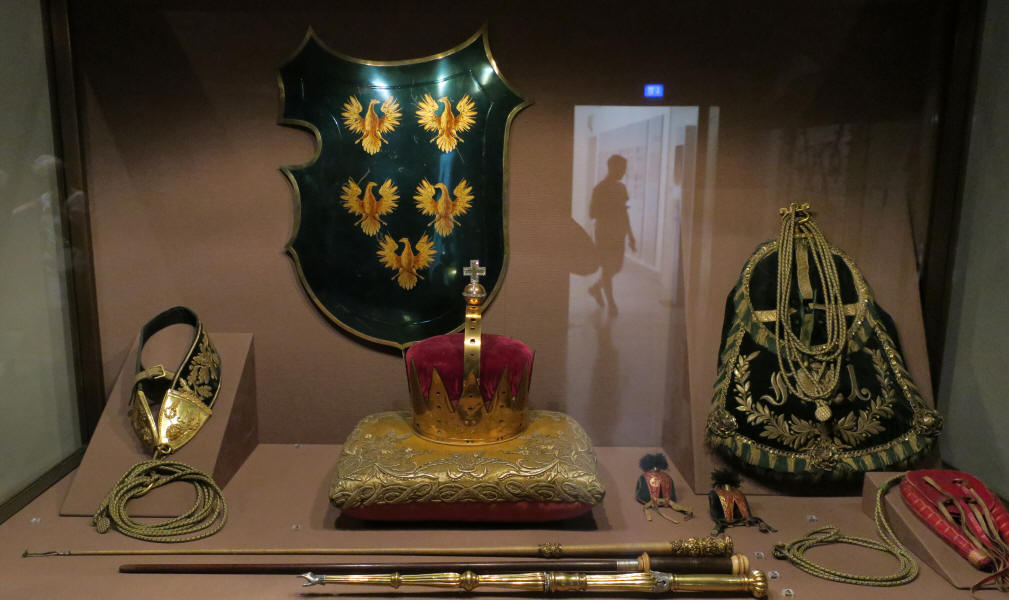
... 4) the "Main de Justice" (German 1600-1700) (forefront), 5) Staff of the Imperial Court of Chancellery (German 1500-1700) (behind 4), 6) Riding whip of the Equerry of the Tyrol (Vienna, 1838) (behind 5), and 7) Insignia for the Hereditary Grand Master Falconer (Vienna, 1835) (a. pouch, b. two falcon hoods, c. falcon lure) (all on the right).
Finally I get to the "crown" display". Below is the crown of Rudolph II (Prague, 1615) with the Imperial orb to match the crown (Prague, 1612-15) and below, the scepter (made of narwhal tusk, gold, diamonds, rubies, sapphires and pearls made for Emperor Matthew to match the crown.
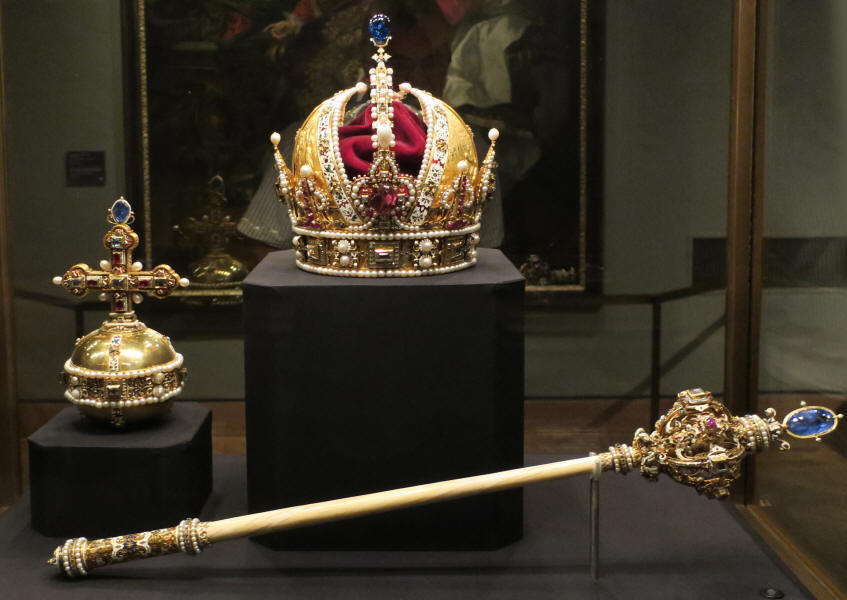
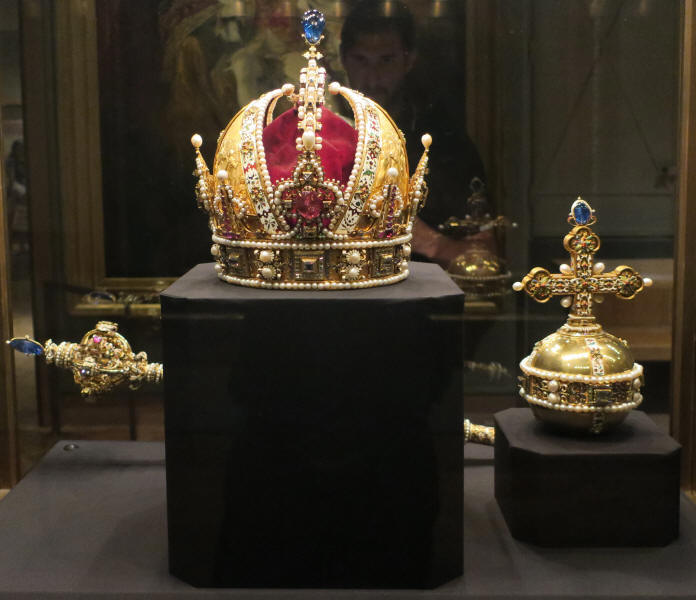

The Crown of Rudolph II became the crown of the Austrian Empire (Prague, 1602). Here is a closer look at the crown and the orb.
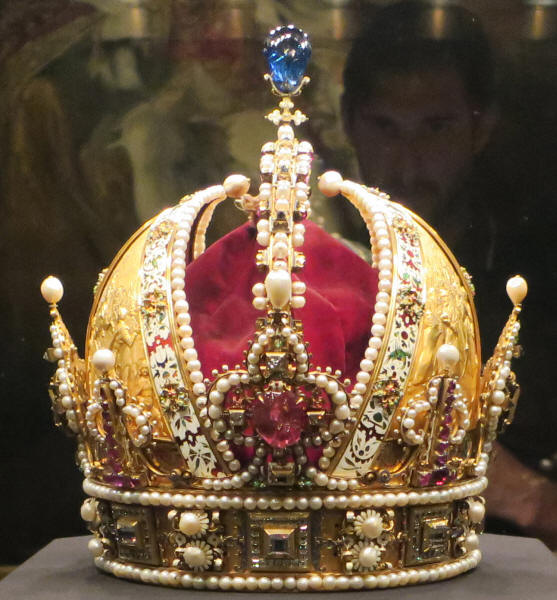
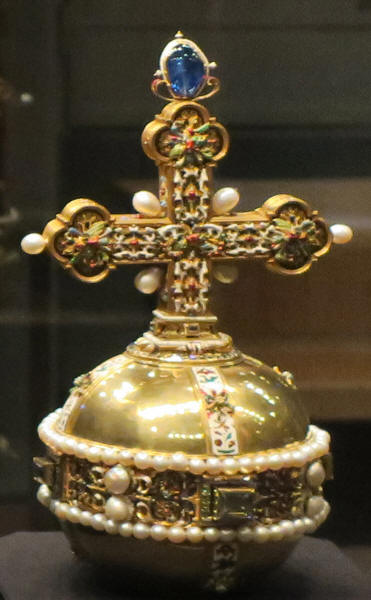
Below is a stock photo I found of the Imperial crown display and my shot of the bronze bust of the man who wore it, Emperor Rudolph II (1552-1612) by Adriaen de Vries of Prague in 1607.
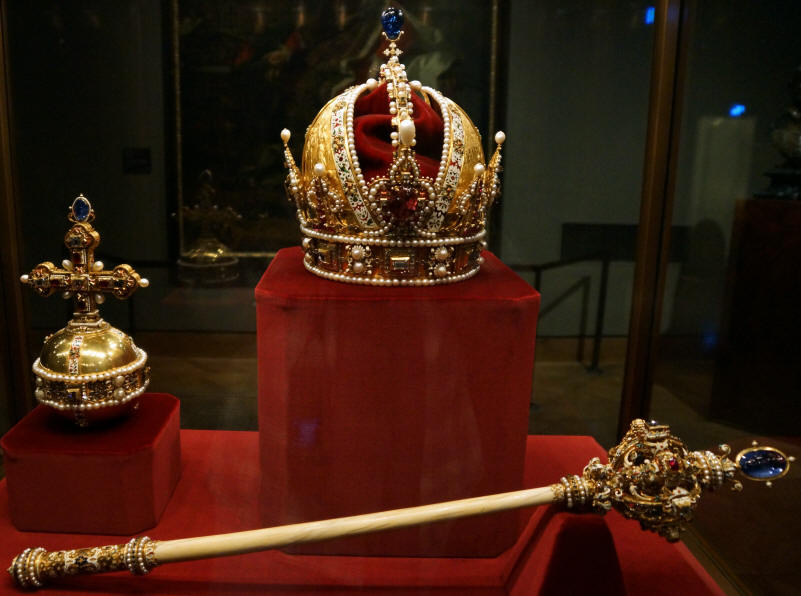
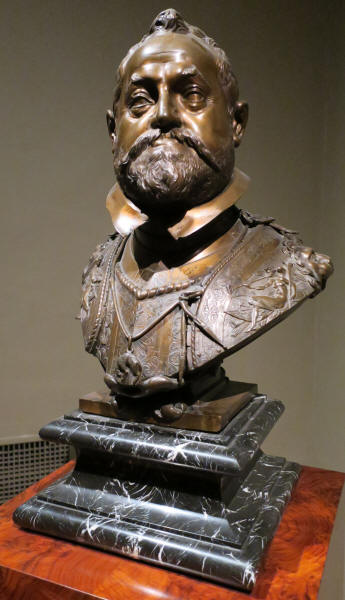
In Room 4 there are displays of the Austrian Empire's Kingdom of Lombardy-Venetia and the coronation vestments of Ferdinand I.
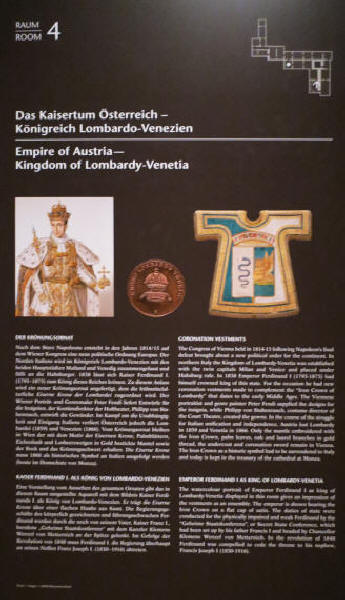
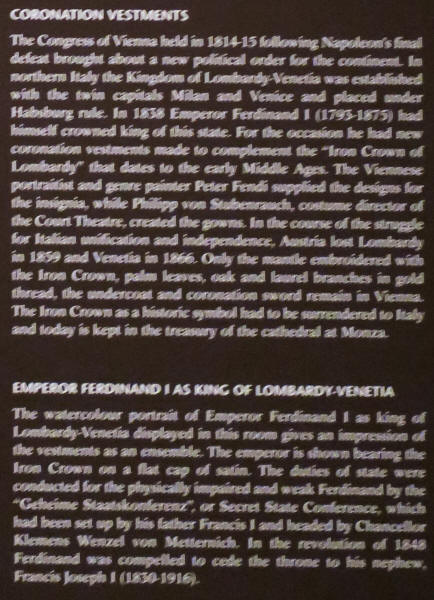
Below is an example of the scepter and vestment used by the Heralds.
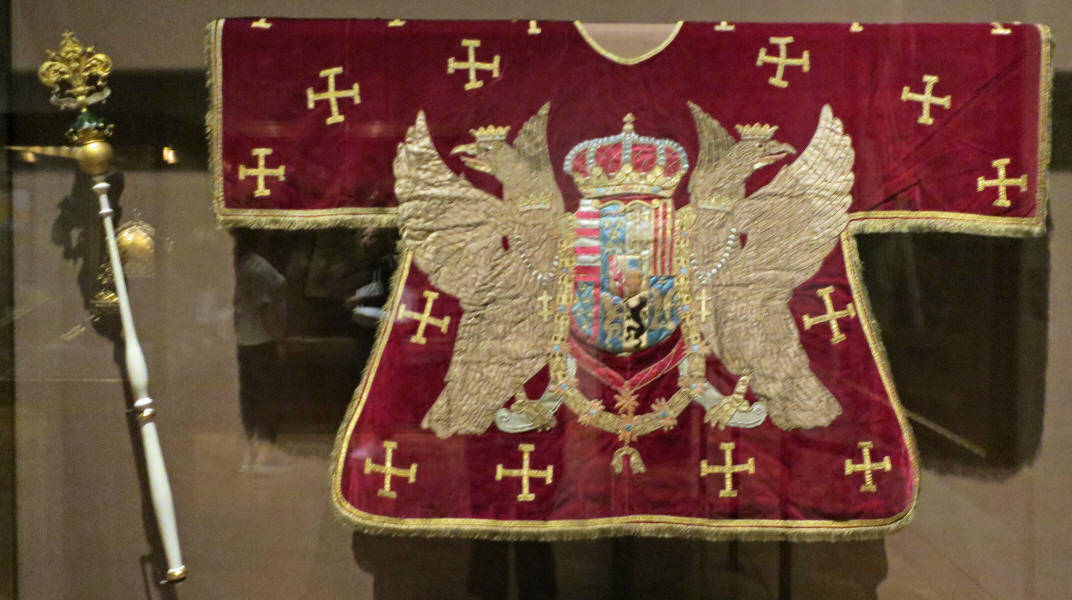
Below left is another staff and mantle of the Austrian Emperor and on the right is the Herald's staff (1858) (left) and the tabard of the Herald of the Kingdom of Lombardy and Venetia (1858) (right).
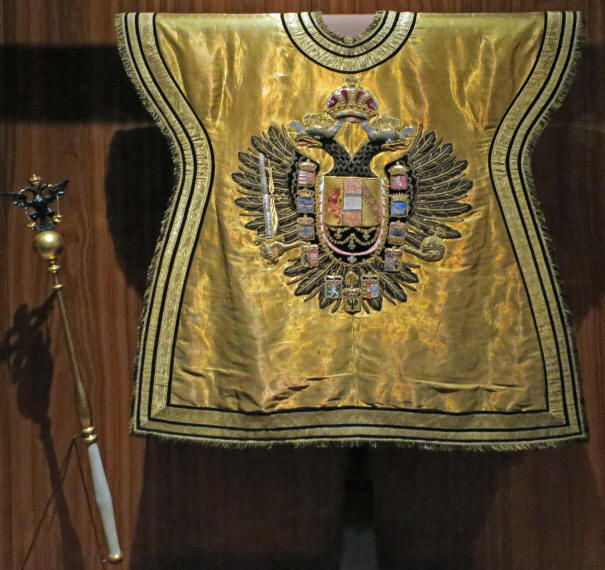
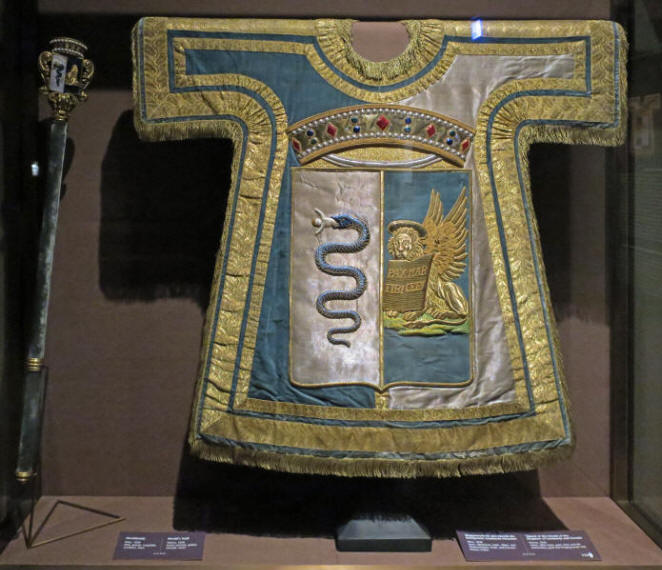
Below left is the insignia of the Kingdom of Bohemia with the scepter and orb (Prague, 1350-1375) (center). The robes worn by the King of Bohemia as Elector (above) and the coronet (hat) with ermine trimming (below right) and a pair of gloves with gold lace trimmings (below left). Below right is another court robe, hat, sword and scabbard.
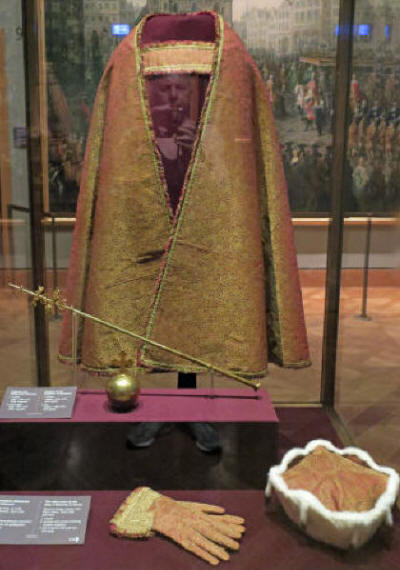
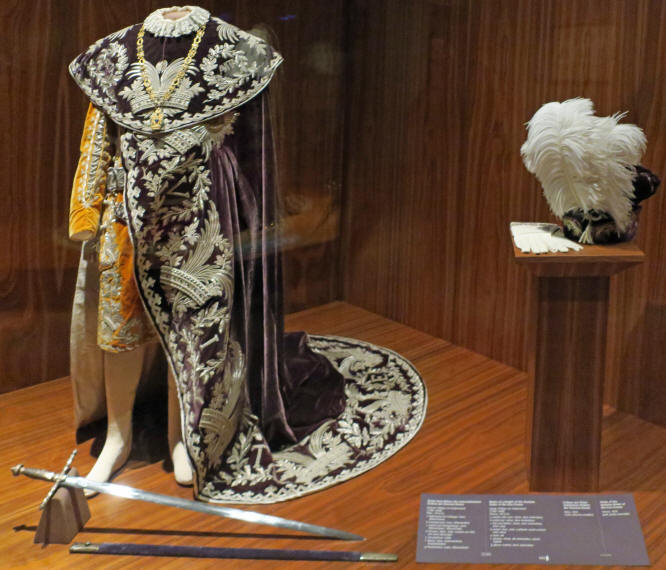
Below left is the mantle of the Austrian Emperor (Vienna, 1830) and sword to be worn with it (German, 1600). Center and right are two more ceremonial robes.
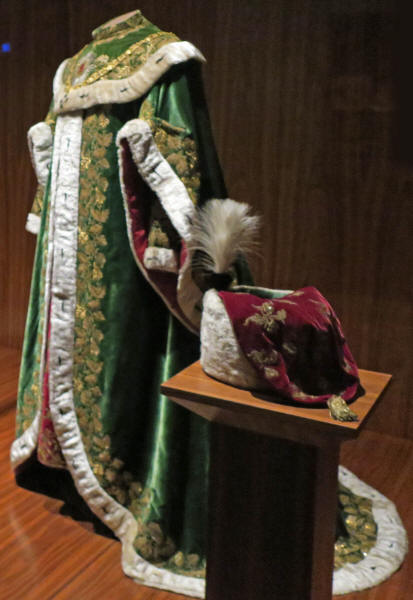
I ended this part of my touring with an oil painting of Emperor Francis I of Austria (1768-1833) wearing the Imperial robes and a notice that this palace is an official European Heritage Site.
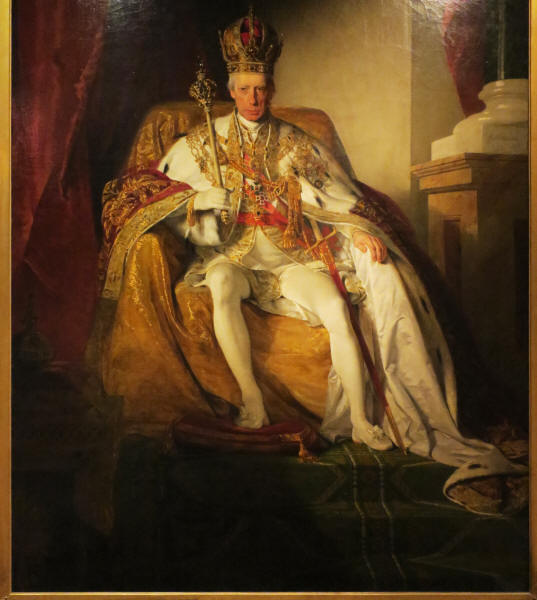
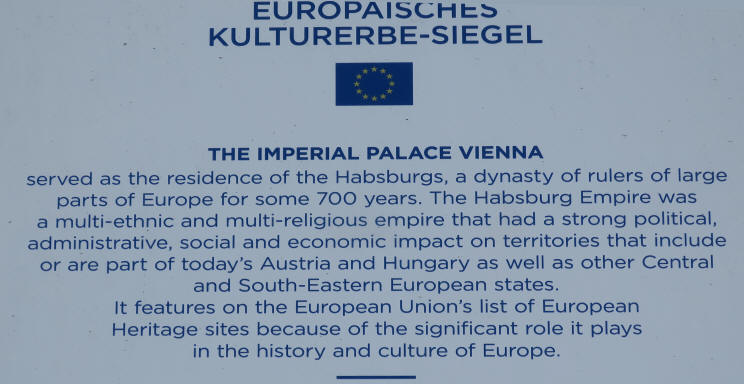
There is no way to display all I have seen today, so it became necessary to split this one day into two pages which will continue with Diario #4. I thought all this was rather interesting and hope it is not boring.
Kenneth J. Hoffer, MD
Vienna, Austria
Sent 2-15-2019
If you enjoyed these travels or wish to add comments on the places we visited
Please Leave Me a Message by clicking the spinning @ sign below.

